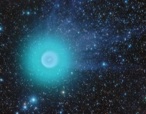
Abstract:
Frank Dodd (Tony) Smith, Jr., November 2007 and January 2008 - Apppendix re E8 geometry etc
(Click here for pdf version) (Click here to see about F4, E6, and E8 and a root vector movie.)

Garrett Lisi in hep-th/0711.0770 said ".... The building blocks of the standard model and gravity are fields over a four dimensional base manifold. ... Relying on the algebraic structure of the exceptional Lie groups, the fermions may also be recast as Lie algebra elements and included naturally ... the entire ensemble corresponds to a uniquely beautiful Lie group - the largest simple exceptional group, E8. ... The weights of ... 222 elements - corresponding to the quantum numbers of all gravitational and standard model fields - exactly match 222 roots out of the 240 of E8. ... The action for everything, [is] chosen by hand to be in agreement with the standard model with gravity included via the MacDowell-Mansouri technique....".Jacques Distler in November 2007 on his web blog Musings said "... I ...[Jacques Distler am]... not going to talk about spin-statistics, or the Coleman-Mandula Theorem ... that could render Garrett's idea a non-starter ... Instead, I will confine myself to a narrow question in group representation theory. ...
There are two ... noncompact real form[s] of E8 ...
- E8(8) [with] Spin(16) as a maximal compact subgroup ..[where]... the 248 [dimensions of E8]... decompose... as 248 = 120 + 128 ...
- E8(-24) [with] SU(2) x E7 as a maximal compact subgroup ..[where]... the 248 [dimensions of E8]... decompose... as 248 = (3,1) + (1,133) + (2,56)
... I ...[Jacques Distler am here]... deliberately not being careful about such factors of Z2 ... for ease of presentation ...
you [Garrett Lisi] state that G is embedded in E8(-24). Now you say it's embedded in Spin(7,1) x Spin(8) ... That's not a subgroup of E8(-24). It is a subgroup of E8(8). ...".
Garrett Lisi replied "... I [Garrett Lisi] made a mistake in thinking that so(7,1) + so(8) is in the Lie algebra of E IX [ = E8(-24) ] , when in fact it's in ... [ EVIII = E8(8) ]... Thanks. ...".
Bee (Sabine Hossenfelder) said in November on her blog "... I ...[ Bee have ]... complained ..
- about the absence of coupling constants throughout the paper [ hep-th/0711.0770 ] ...
- there is no base manifold present whatsoever ...[in]... the elements of the [E8 Lie] algebra ...
- he [ Garrett Lisi ] has to choose the action by hand to reproduce the SM ...
- for his [ Garrett Lisi's ] theory to work he needs ... the cosmological constant ... to be the size of about the Higgs vev, i.e. roughly 12 orders of magnitude too large
Jacques Distler in November 2007 on his web blog Musings said "... If you want to include the MacDowell-Mansouri Spin(3,1)o, along with the Standard Model gauge group, in E8, then there is not enough "room" to also include 3 generations of quarks and leptons in the 248. That was what Lisi was aiming for. And I think we are all agreed that it doesn't work. ...".
So, this paper is written based on Garrett Lisi's ideas in hep-th/0711.0770 with some modifications to satisfy the objections of Jacques Distler and Bee (Sabine Hossenfelder):
- the structure is based on EVII = E8(8) with 248 = 120 + 128
- there are calculations of coupling constants (force strengths) as well as particle masses and K-M parameters
- the base manifold spacetime is part of E8(8) itself
- the Lagrangian for Gravity plus the Standard Model is based on natural structural relations among various parts of E8(8)
- the Dark Energy (cosmological constant) : Dark Matter : Ordinary Matter ratio is calculated, with results consistent with WMAP
- the second and third generations of fermions are composites of some of the 248 elements of E8 and are not directly related to triality
- triality is useful in establishing relations among fermions, the base manifold, and gauge bosons, which relations indicate that the model satisfies Coleman-Mandula and spin-statistics
For "ease of presentation", sometimes I will be sloppy about such things as signature, distinguishing between Pinors and Spinors, precise group structure distinctions such as between SU(3)xSU(2)xU(1) and S(U(2)xU(3)) = U(1) x SU(2) x SU(3) / I(2) x I(3), etc. I hope that the real meanings will be clear from context.
Any errors in this paper are not Garrett Lisi's fault.
Spin(16) is the bivector Lie algebra of the real Clifford algebra Cl(16)
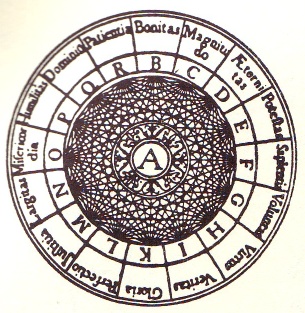
As Ramon Llull showed about 700 years ago in his Wheel A, the 16 basis vectors of Cl(16) (vertices/letters) combine to form 120 bivectors (vertex pair lines) of Cl(16) which act as the 120 generators of the Lie algebra Spin(16).
The real Clifford algebra 8-periodicity tensor product factorization
In terms of the 28 bivectors of the first Cl(8) factor and the 28 bivectors of the second Cl(8) factor and the 64 product-of-vectors, the 112 are:
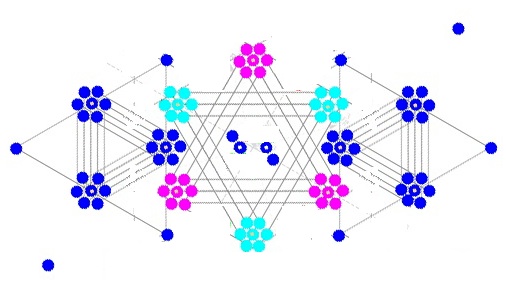
Note that in the above image some of the 240 E8(8) vertices are projected to the same point:
The 128 can be seen as the sum 64 + 64 of two 8x8 square-matrices each being 64-dim (colored red and green on the following diagram).
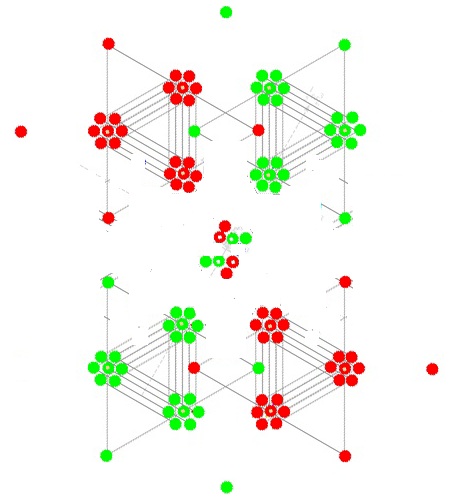
Note that in the above image some of the 240 E8(8) vertices are projected to the same point:
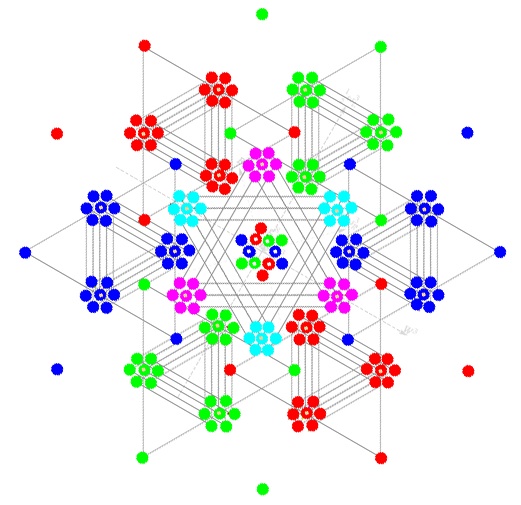
Note that in the above image some of the 240 E8(8) vertices are projected to the same point:
In the above, the black underlined 4+4 = 8 correspond to the 8 E8 Cartan subalgebra elements that are not represented by root vectors, and the black non-underlined 1+3+3+1 = 8 correspond to the 8 elements of 256-dim Cl(8) that do not directly correspond elements of 248-dim E8.
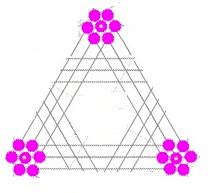
A stereo view of a 24-cell (the 4th dimension color-coded red-green-blue with green in the middle)
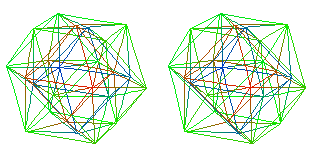
shows that the 4-dim 24-cell has a 3-dim central polytope that is a cuboctahedron
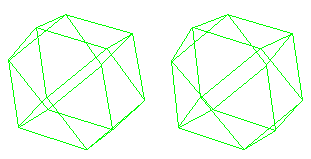
the 12 vertices of which form the root vector polytope of the 16-dim U(2,,2) = U(1) x SU(2,2) , where 15-dim rank 3 SU(2,2) = Conformal Group Spin(2,4) produces Gravity by the MacDowell-Mansouri mechanism (see Rabindra Mohapatra, Unification and Supersymmetry (2nd edition, Springer-Verlag 1992), particularly section 14.6).
Since this group structure acts directly on the 8-dim Kaluza-Klein M4 x CP2, it acts on the associative part given by the associative 3-vector PSI of the dimensional reduction Quaternionic structure
(such as occurs due to dimensional reduction of physical spacetime from 8-dim Octonionic to 4-dim Quaternionic by freezing out (at energies lower than the Planck/GUT region) a Quaternionic substructure of 8-dim Octonionic vector space)
which is the spatial part of the M4, so that the M4 on which it acts has signature -+++
The U(1) of U(2,2) provides the complex phase of propagators.
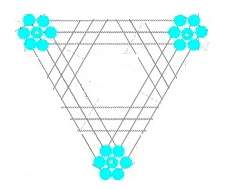
The 28 6-vectors of Cl(8) correspond to a 28-dim rank 4 Spin(8) Lie algebra after introduction of Quaternionic structure into the E8 physics model
(such as occurs due to dimensional reduction of physical spacetime from 8-dim Octonionic to 4-dim Quaternionic by freezing out (at energies lower than the Planck/GUT region) a Quaternionic substructure of 8-dim Octonionic vector space )
by using the co-associative 4-vector PHI of the chosen Quaternionic structure to map any 6-vector A to a bivector A /\ PHI,
and so mapping the 28 6-vectors onto 28 bivectors that form a 28-dim Lie algebra.
The process is somewhat analagous to using a co-associative 4-vector PHI' in Cl(7) to define a cross-product in 7-dim vector space for vectors a, b (see F. Reese Harvey, Spinors and Calibrations (Academic 1990)) by a x b = *((a /\ b) /\ PSI)
A stereo view of a 24-cell (the 4th dimension color-coded red-green-blue with green in the middle)

shows that the 4-dim 24-cell has a 3-dim central polytope that is a cuboctahedron

that is the root vector polytope of 15-dim rank 3 Spin(6) = SU(4) that includes 8+1 = 9-dim SU(3)xU(1) = U(3) in the Twistor construction of 6-dim CP3 = SU(4) / U(3)
Projection into a 2-dim space for the root vectors of the rank 2 group SU(3) gives
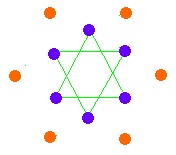
where the 6 purple vertices form the hexagonal root vector polygon of 8-dim rank 2 SU(3) and the 6 gold vertices correspond to the 6 dimensions of the CP3 Twistor space.
Introduction of a Quaternionic CP3 Twistor space "... induces a mapping of projective spaces CP3 -> QP1 ...[with]... fibres ... CP1 ..." (see R. O. Wells, Complex Geometry in Mathematical Physics (Les Presses de l'Universite de Montreal 1982), particularly section 2.6).
Since CP1 = SU(2) / U(1) an introduction of Quaternionic structure into the E8 physics model
(such as occurs due to dimensional reduction of physical spacetime from 8-dim Octonionic to 4-dim Quaternionic by freezing out (at energies lower than the Planck/GUT region) a Quaternionic substructure of 8-dim Octonionic vector space )
gives weak force SU(2) through QP1 = Sp(2)/ Sp(1)xSp(1) = Spin(5) / SU(2)xSU(2) or, equivalently, through CP3 containing CP2 = SU(3) / U(2) .
Since the U(1) of U(3) = SU(3) x U(1) is Abelian, it does not correspond to a root vector vertex and therefore does not appear in the root vector diagrams.
Since this group structure is produced by a co-associative 4-vector PHI, it acts on the co-associative part of 8-dim Kaluza-Klein M4 x CP2, which is the CP2 4-dim Internal Symmetry Space of signature ++++
As described by N. A. Batakis in Class. Quantum Grav. 3 (1986) L99-L105, the U(2) = SU(2) x U(1) acts on the CP2 as little group, or local isotropy group, while the SU(3) acts globally on the CP2 = SU(3) / U(2) = SU(3) / SU(2) x U(1)
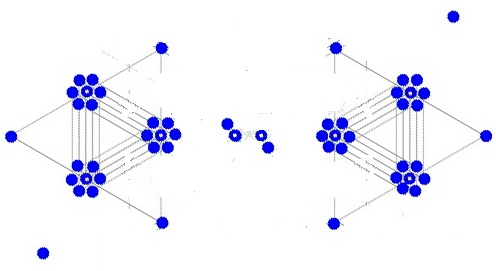
With respect to the Cl(8) grading, the first 8 of the 8x8 = 64 is the vector space, and therefore is a natural 8-dim spacetime that after introduction of a preferred Quaternionic substructure
(such as occurs due to dimensional reduction of physical spacetime from 8-dim Octonionic to 4-dim Quaternionic by freezing out (at energies lower than the Planck/GUT region) a Quaternionic substructure of 8-dim Octonionic vector space)
becomes a 4-dim plus 4-dim Kaluza-Klein space of the form M4 x CP2 as described by N. A. Batakis in Class. Quantum Grav. 3 (1986) L99-L105,
The M4 of signature -+++ contains an associative 3-dim spatial structure, while the CP2 of signature ++++ has a co-associative 4-dim structure.
So, the first 8 of the 8x8 = 64, denoted by 8_v , represents 4+4 = 8-dim M4 x CP2 Kaluza-Klein space, where the compact CP2 is small.
As to the second 8 of the 8_v x 8,
it lives in the 7-vectors of the Cl(8) grading,
and it should represent the 8 Dirac Gammas of the Cl(8) Clifford algebra, so denote it by 8_G so that

The 128 is the 128-dim rank 8 symmetric space E8 / Spin(16) of type EVIII known as Rosenfeld's octo-octonionic projective plane (OxO)P2 (see Arthur L. Besse, Einstein Manifolds (Springer 1987) and Boris Rosenfeld, Geometry of Lie Groups (Kluwer 1997)).
Since it is a plane (of 2 8x8 octo-octonionic dimensions), it has structure 128 = 64 + 64 = 8x8 + 8x8.
Since it is a half-spinor space (of Spin(16)) its elements are fundamentally fermionic, so
As to the second 8 in the 8_f+ x 8 = 64 and the 8_f- x 8 = 64
it should represent the 8 Dirac Gammas of the Cl(8) Clifford algebra, so denote it by 8_G so that :
Note also that the fermion particles are fundamentally all left-handed, and the fermion antiparticles are fundamentally all right-handed. The other handednesses are not different fundamental states, but arise dynamically due to special relativity transformations that can switch handedness of particles that travel at less than light-speed (i.e., that have more than zero rest mass).
At energies below the Planck/GUT level, the Octonionic structure of the model changes, by freezing out of a preferred Quaternionic substructure, from Real/Octonionic 8-dim spacetime to Quaternionic -+++ associative 4-dim M4 Physical Spacetime plus Quaternionic +++ co-associative 4-dim CP2 = SU(3) / SU(2) x U(1) Internal Symmetry Space.
After Quaternionic structure freezes out,
transform from 8x8 real matrices to 4x4 Quaternionic matrices
As can be seen in this chart (from F. Reese Harvey, Spinors and Calibrations (Academic 1990))
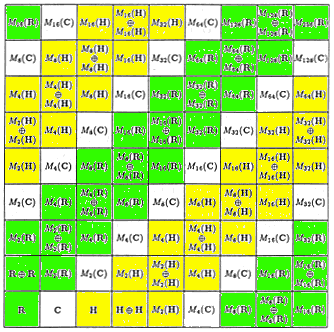
is transformed into
the 8x8x4 = 256-dim Cl(2,6) = M(8,Q) = 8x8 Quaternionic Matrix Algebra
and
is transformed into
the 4x4x4 = 64-dim Cl(2,4) = M(4,Q) = 4x4 Quaternionic Matrix Algebra
and
become
the 2-Quaternionic-dim (8-Real-dim) column vectors 2_Q_v , 2_Q_f+ , 2_Q_f-
and
become
the 2-Quaternionic-dim (8-Real-dim) row vectors 2_Q_G
so that
There is a Spin(8)-type Triality among the three 64 things
The model has:
From the point of view of high-energy 8-dim space, in which gauge boson terms have dimension 1 in the Lagrangian and fermion terms have dimension 7/2 in the Lagrangian, the Triality gives a Subtle Supersymmetry
The natural Lagrangian for the model is
The objective is to reduce the integral over the 8-dim Kaluza-Klein M4 x CP2 to an integral over the 4-dim M4.
Since the U(2,2) acts on the M4, there is no problem with it.
Since the CP2 = SU(3) / U(2) has global SU(3) action, the SU(3) can be considered as a local gauge group acting on the M4, so there is no problem with it.
However, the U(2) acts on the CP2 = SU(3) / U(2) as little group, and so has local action on CP2 and then on M4, so the local action of U(2) on CP2 must be integrated out to get the desired U(2) local action directly on M4.
Since the U(1) part of U(2) = U(1) x SU(2) is Abelian, its local action on CP2 and then M4 can be composed to produce a single U(1) local action on M4, wo there is no problem with it.
That leaves non-Abelian SU(2) with local action on CP2 and then on M4, and the necessity to integrate out the local CP2 action to get something acting locally directly on M4. This is done by a mechanism due to Meinhard Mayer, The Geometry of Symmetry Breaking in Gauge Theories, Acta Physica Austriaca, Suppl. XXIII (1981) 477-490 where he says:
"... We start out from ... four-dimensional M [ M4 ] ...[and]... R ...[that is]... obtained from ... G/H [ CP2 = SU(3) / U(2) ] ... the physical surviving components of A and F, which we will denote by A and F, respectively, are a one-form and two form on M [M4] with values in H [SU(2)] ...the remaining components will be subjected to symmetry and gauge transformations, thus reducing the Yang-Mills action ...[on M4 x CP2]... to a Yang-Mills-Ginzburg-Landau action on M [M4] ... Consider the Yang-Mills action on R ...S_YM = Integral Tr ( F /\ *F ) ... We can ... split the curvature F into components along M [M4] (spacetime) and those along directions tangent to G/H [CP2] .
We denote the former components by F_!! and the latter by F_?? , whereas the mixed components (one along M, the other along G/H) will be denoted by F_!? ... Then the integrand ... becomes
Tr( F_!! F^!! + 2 F_!? F^!? + F_?? F^?? ) ... The first term .. becomes the [SU(2)] Yang-Mills action for the reduced [SU(2)] Yang-Mills theory ...
the middle term .. becomes, symbolically, Tr Sum D_! PHI(?) D^! PHI(?) where PHI(?) is the Lie-algebra-valued 0-form corresponding to the invariance of A with respect tothe vector field ? , in the G/H [CP2] direction ...
the third term ... involves the contraction F_?? of F with two vector fields lying along G/H [CP2] ... we make use of the equation [from Mayer-Trautman, Acta Physica Austriaca, Suppl. XXIII (1981) 433-476, equation 6.18]
2 F_?? = [ PHI(?) , PHI(?) ] - PHI([?,?]) ... Thus, the third term ... reduces to what is essentially a Ginzburg-Landau potential in the components of PHI:
Tr F_?? F^?? = (1/4) Tr ( [ PHI , PHI ] - PHI )^2 ... special cases which were considered show that ...[the equation immediately above]... has indeed the properties required of a Ginzburg_Landau-Higgs potential, and moreover the relative signs of the quartic and quadratic terms are correct, and only one overall normalization constant ... is needed. ...".
(see also S. Kobayashi and K. Nomizu, Foundations of Differential Geometry, Volume I, Wiley (1963), especially section II.11)
So,
As to
At low (where we do experiments) energies a Quaternionic structure freezes out, splitting the 8-dim spacetime into a 4-dim physical spacetime M4 and a 4-dim internal symmetry space CP2.
First generation fermion particles are represented by octonions as follows:
Octonion Fermion
Basis Element Particle
1 e-neutrino
i red up quark
j green up quark
k blue up quark
e electron
ie red down quark
je green down quark
ke blue down quark
First generation fermion antiparticles are represented by octonions in a similiar way.
Second generation fermion particles and antiparticles are represented by pairs of octonions.
Third generation fermion particles and antiparticles are represented by triples of octonions.
There are no higher generations of fermions than the Third. This can be seen geometrically as a consequence of the fact that if you reduce the original 8-dimensional spacetime into associative 4-dime M4 physical spacetime and coassociative 4-dim CP2 Internal Symmetry Space then if you look in the original 8-dimensional spacetime at a fermion (First-generation represented by a single octonion) propagating from one vertex to another there are only 4 possibilities for the same propagation after dimensional reduction:
1 - the origin o and target x vertices are both in the associative 4-dimensional physical spacetime
4-dim Internal Symmetry Space -------------- 4-dim Physical SpaceTime ---o------x---
in which case the propagation is unchanged, and the fermion remains a FIRST generation fermion represented by a single octonion o
2 - the origin vertex o is in the associative spacetime and the target vertex * in in the Internal Symmetry Space
4-dim Internal Symmetry Space ----------*---
4-dim Physical SpaceTime ---o----------
in which case there must be a new link from the original target vertex * in the Internal Symmetry Space to a new target vertex x in the associative spacetime
4-dim Internal Symmetry Space ----------*--- 4-dim Physical SpaceTime ---o------x---
and a second octonion can be introduced at the original target vertex in connection with the new link so that the fermion can be regarded after dimensional reduction as a pair of octonions o and * and therefore as a SECOND generation fermion
3 - the target vertex x is in the associative spacetime and the origin vertex o in in the Internal Symmetry Space
4-dim Internal Symmetry Space ---o---------- 4-dim Physical SpaceTime ----------x---
in which case there must be a new link to the original origin vertex o in the Internal Symmetry Space from a new origin vertex * in the associative spacetime
4-dim Internal Symmetry Space ---o---------- 4-dim Physical SpaceTime ---O------x---
so that a second octonion can be introduced at the new origin vertex O in connection with the new link so that the fermion can be regarded after dimensional reduction as a pair of octonions o and o and therefore as a SECOND generation fermion
4 - both the origin vertex o and the target vertex * are in the Internal Symmetry Space,
4-dim Internal Symmetry Space ---o------*--- 4-dim Physical SpaceTime --------------
in which case there must be a new link to the original origin vertex o in the Internal Symmetry Space from a new origin vertex O in the associative spacetime, and a second new link from the original target vertex * in the Internal Symmetry Space to a new target vertex x in the associative spacetime
4-dim Internal Symmetry Space ---o------*--- 4-dim Physical SpaceTime ---O------x---
so that a second octonion can be introduced at the new origin vertex O in connection with the first new link, and a third octonion can be introduced at the original target vertex * in connection with the second new link, so that the fermion can be regarded after dimensional reduction as a triple of octonions O and o and * and therefore as a THIRD generation fermion.
As there are no more possibilities, there are no more generations, and we have:
and
we now have a Lagrangian for the model
Path integrals give a Quantum theory via the classical Lagrangian set out above.
The Lagrangian set out above is only valid in a (possibly small) neighborhood of spacetime. To get a more global theory, the local Lagrangians must be patched together. To do that, look at it from a Cl(8) point of view, and consider that, using 8-periodicity of real Clifford algebras, taking tensor products of factors of Cl(8)
allows construction of arbitrarily large real Clifford algebras as composites of lots of local Cl(8) factors.
As to how to combine local Lagrangians in terms of E8, note that there are 7 independent Root Vector Polytopes / Lattices of type E8, denoted E8_1, E8_2, E8_3, E8_4, E8_5, E8_6, E8_7. Some of them have vertices in commmon, but they are all distinct.
All of the 7 independent Root Vector Polytope Lie algebras E8_i correspond to E8 Lattices consistent with Octonion Multiplication, and the the 7 Lie algebras / Lattices / Root Vector Polytopes E8_i are related to each other as the 7 Octonion imaginaries i,j,k,e,ie,je,ke , so the copies of E8 might combine according to the rules of octonion multiplication, globally arranging themselves like integral octonions.
Such a Spin Foam model might be related to the 26-dim Bosonic String model described in CERN preprint CERN-CDS-EXT-2004-031 in which fermions come from orbifolding and the 7 independent E8_i are used in constructing D8 branes.
Michio Hashimoto, Masaharu Tanabashi, and Koichi Yamawaki in their paper at hep-ph/0311165 describe models with T-quark condensate for Higgs in 8-dimensional Kaluza-Klein spacetime with 4 compact dimensions, like M4 x CP2 of the E8 model, and calculate that
Renormalization running up and down from that point on a plot of Higgs mass v. Tquark mass
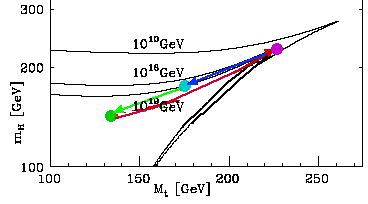
shows that the point ( M_H = 176-188 , M_T = 172-175 ) is right on the Triviality Bound curve for as Standard Model with high-energy cut-off at the Planck energy 10^19 GeV (see hep-ph/0307138 ) and
There is not much data for a T-quark-Higgs state around ( M_H = 239 , M_T = 220 ), but perhaps the LHC might shed light on that.
As to a T-quark-Higgs state around ( M_H = 143-160 , M_T = 130-145 ) , it is not conventionally accepted that there is any evidence for such a state, but my opinion about data analysis is that there is such evidence. For example, the initial CDF and D0 histograms for semileptonic events
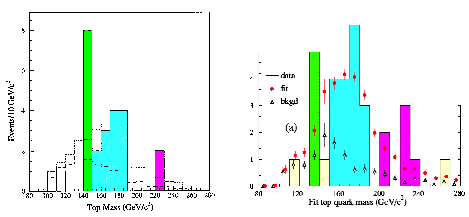
both independently show a tall narrow peak (green) in the 130-145 GeV range for the Tquark mass. Since mass calculations used in this E8 model had been done prior to those histograms, and had predicted a tree-level (about 10% or so accuracy) value of the Tquark mass of about 130 GeV, those independent CDF and D0 results indicate a probability around 4 sigma for M_T = 130-145 (see an entry on Tommaso Dorigo's blog around 5 September 2007).
In my opinion, recent results from CDF and D0 are still consistent with the existence of a Tquark-Higgs state around ( M_H = 143-160 , M_T = 130-145 ), but the consensus view is otherwise. However, I disagree with that consensus, based on how I see exeperimental data, such as:
Dilepton data described by Erich Ward Varnes in Chapter 8 of his 1997 UC Berkeley PhD thesis about D0 data at Fermilab:
"… there are six t-tbar candidate events in the dilepton final states … Three of the events contain three jets, and in these cases the results of the fits using only the leading two jets and using all combinations of three jets are given …".
There being only 6 dilepton events in Figure 8.1 of Varnes's PhD thesis
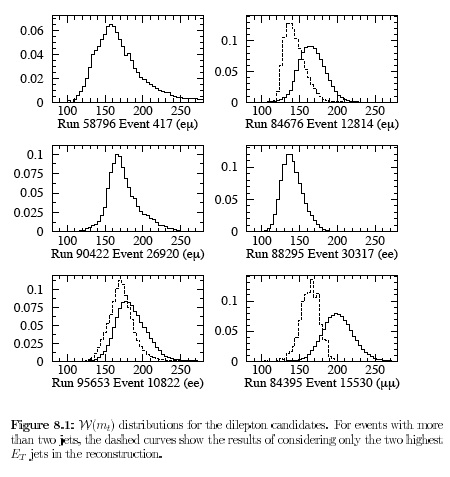
it is reasonable to discuss each of them, so (mass is roughly estimated by me looking at the histograms) here they are:
In terms of 3 Truth Quark mass states - high around 220 GeV or so - medium around 170 GeV or so - low around 130-145 GeV or so - those look like:
This, and other more recent experimental subtleties ( see for example www.tony5m17h.net/ and other pages on my web site there ), reinforce my view:
In my opinion, recent results from CDF and D0 are still consistent with the existence of a Tquark-Higgs state around ( M_H = 143-160 , M_T = 130-145 ), but the consensus view is otherwise.
The model Lagrangian (just looking at spacetime and gauge bosons and ignoring spinor fermions etc) is the integral over spacetime of gauge boson terms, so THE FORCE STRENGTH IS MADE UP OF TWO PARTS:
Ignoring for this exposition details about the 4-dim internal symmetry space, and ignoring conformal stuff (Higgs etc), the 4-dim spacetime Lagrangian gauge boson term is the integral over spacetime as seen by gauge boson acting globally of the gauge force term of the gauge boson acting locally for the gauge bosons of each of the four forces:
In the conventional Lagrangian picture, for each gauge force the gauge boson force term contains the force strength, which in Feynman's picture is the probability to emit a gauge boson, in either an explicit ( like g |F|^2 ) or an implicit ( incorporated into the |F|^2 ) form. Either way, the conventional picture is that the force strength g is an ad hoc inclusion.
What I am doing is to construct the integral such that the force strength emerges naturally from the geometry of each gauge force.
To do that, for each gauge force:
1 - make the spacetime over which the integral is taken be spacetime AS IT IS SEEN BY THAT GAUGE BOSON, that is, in terms of the symmetric space with GLOBAL symmetry of the gauge boson:
2 - make the gauge boson force term have the volume of the Shilov boundary corresponding to the symmetric space with LOCAL symmetry of the gauge boson. The nontrivial Shilov boundaries are:
The result is (ignoring technicalities for exposition) the geometric factor for force strength calculation.
GLOBAL: Each gauge group is the global symmetry of a symmetric space
LOCAL: Each gauge group is the local symmetry of a symmetric space
The nontrivial local symmetry symmetric spaces correspond to bounded complex domains
The nontrivial bounded complex domains have Shilov boundaries
GLOBAL AND LOCAL TOGETHER: Very roughly think of the force strength as
That is (again very roughly and intuitively): the geometric strength of the force is given by the product of
When you calculate the product volumes (using some normalizations etc that are described in more detail here below ), you see that roughly:
so since (as Feynman says) force strength = probability to emit a gauge boson means that the highest force strength or probability should be 1
I normalize the gravity Volume product to be 1, and get results roughly ( for example, the fine structrure constant calculation gives 1/137.03608 but is rounded off here as 1/137 ):
There are two further main components of a force strength:
CONSIDER MASSIVE GAUGE BOSONS: I consider gravity to be carried by virtual Planck-mass black holes, so that the geometric strength of gravity should be reduced by 1/Mp^2 and I consider the weak force to be carried by weak bosons, so that the geometric strength of gravity should be reduced by 1/MW^2 That gives the result:
FINALLY, CONSIDER RENORMALIZATION RUNNING FOR THE COLOR FORCE: That gives the result:
The use of compact volumes is itself a calculational device, because it would be more nearly correct, instead of
to use
However, since the strongest (gravitation) geometric force strength is to be normalized to 1, the only thing that matters is RATIOS, and the compact volumes (finite and easy to look up in the book by Hua) have the same ratios as the noncompact invariant measures.
In fact, I should go on to say that continuous spacetime and gauge force geometric objects are themselves also calculational devices, and
that it would be even more nearly correct to do the calculations with respect to a discrete generalized hyperdiamond Feynman checkerboard.
Some of this material was written in connection with email discussion with Ark Jadczyk. More details can be found on my web site at www.valdostamuseum.org/hamsmith/
The force strength of a given force is
alphaforce = (1 / Mforce^2 \)
( Vol(MISforce))
( Vol(Qforce) / Vol(Dforce)^( 1 / mforce ))
where:
alphaforce represents the force strength;
Mforce represents the effective mass;
MISforce represents the part of the target
Internal Symmetry Space that is available for the gauge
boson to go to;
Vol(MISforce) stands for volume of MISforce,
and is sometimes also denoted by the shorter notation Vol(M);
Qforce represents the link from the origin
to the target that is available for the gauge
boson to go through;
Vol(Qforce) stands for volume of Qforce;
Dforce represents the complex bounded homogeneous domain
of which Qforce is the Shilov boundary;
mforce is the dimensionality of Qforce,
which is 4 for Gravity and the Color force,
2 for the Weak force (which therefore is considered to
have two copies of QW for each spacetime HyperDiamond link),
and 1 for Electromagnetism (which therefore is considered to
have four copies of QE for each spacetime HyperDiamond link)
Vol(Dforce)^( 1 / mforce ) stands for
a dimensional normalization factor (to reconcile the dimensionality
of the Internal Symmetry Space of the target vertex
with the dimensionality of the link from the origin to the
target vertex).
The Qforce, Hermitian symmetric space,
and Dforce manifolds for the four forces are:
Gauge Hermitian Type mforce Qforce
Group Symmetric of
Space Dforce
Spin(5) Spin(7) / Spin(5)xU(1) IV5 4 RP^1xS^4
SU(3) SU(4) / SU(3)xU(1) B^6(ball) 4 S^5
SU(2) Spin(5) / SU(2)xU(1) IV3 2 RP^1xS^2
U(1) - - 1 -
The geometric volumes needed for the calculations are mostly taken from the book Harmonic Analysis of Functions of Several Complex Variables in the Classical Domains (AMS 1963, Moskva 1959, Science Press Peking 1958) by L. K. Hua [with unit radius scale].
Note ( thanks to Carlos Castro for noticing this ) that the volume lisrted for S5 is for a squashed S5, a Shilov boundary of the complex domain corresponding to the symmetric space SU(4) / SU(3) x U(1).
Note ( thanks again to Carlos Castro for noticing this ) also that the volume listed for CP2 is unconventional, but physically justified by noting that S4 and CP2 can be seen as having the same physical volume, with the only difference being structure at infinity.
Note also that
Force M Vol(M)
gravity S^4 8pi^2/3 - S^4 is 4-dimensional
color CP^2 8pi^2/3 - CP^2 is 4-dimensional
weak S^2 x S^2 2 x 4pi - S^2 is a 2-dim boundary of 3-dim ball
4-dim S^2 x S^2 =
= topological boundary of 6-dim 2-polyball
Shilov Boundary of 6-dim 2-polyball = S^2 + S^2 =
= 2-dim surface frame of 4-dim S^2 x S^
e-mag T^4 4 x 2pi - S^1 is 1-dim boundary of 2-dim disk
4-dim T^4 = S^1 x S^1 x S^1 x S^1 =
= topological boundary of 8-dim 4-polydisk
Shilov Boundary of 8-dim 4-polydisk =
= S^1 + S^1 + S^1 + S^1 =
= 1-dim wire frame of 4-dim T^4
Also note that for U(1) electromagnetism, whose photon carries no charge, the factors Vol(Q) and Vol(D) do not apply and are set equal to 1, and from another point of view, the link manifold to the target vertex is trivial for the abelian neutral U(1) photons of Electromagnetism, so we take QE and DE to be equal to unity.
Force M Vol(M) Q Vol(Q) D Vol(D)
gravity S^4 8pi^2/3 RP^1xS^4 8pi^3/3 IV5 pi^5/2^4 5!
color CP^2 8pi^2/3 S^5 4pi^3 B^6(ball) pi^3/6
weak S^2xS^2 2x4pi RP^1xS^2 4pi^2 IV3 pi^3/24
e-mag T^4 4x2pi - - - -
Using these numbers, the results of the
calculations are the relative force strengths
at the characteristic energy level of the
generalized Bohr radius of each force:
Gauge Force Characteristic Geometric Total
Group Energy Force Force
Strength Strength
Spin(5) gravity approx 10^19 GeV 1 GGmproton^2
approx 5 x 10^-39
SU(3) color approx 245 MeV 0.6286 0.6286
SU(2) weak approx 100 GeV 0.2535 GWmproton^2
approx 1.05 x 10^-5
U(1) e-mag approx 4 KeV 1/137.03608 1/137.03608
The force strengths are given at the characteristic
energy levels of their forces, because the force
strengths run with changing energy levels.
The effect is particularly pronounced with the color
force.
The color force strength was calculated using a simple
perturbative QCD renormalization group equation
at various energies, with the following results:
Energy Level Color Force Strength
245 MeV 0.6286
5.3 GeV 0.166
34 GeV 0.121
91 GeV 0.106
Taking other effects, such as Nonperturbative QCD,
into account, should give
a Color Force Strength of about 0.125 at about 91 GeV
The E8 model Lagrangian (for this message just looking at spacetime and spinor fermions and ignoring gauge bosons etc) has
an Integral over 8-dim spacetime of a spinor fermion particle and antiparticle term,
in which first-generation fermion particles correspond to octonion basis elements
and first-generation fermion antiparticles correspond to octonion basis elements
At low (where we do experiments) energies a specific quaternionic submanifold freezes out, splitting the 8-dim spacetime into a 4-dim M4 physical spacetime plus a 4-dim CP2 internal symmetry space and creating second and third generation fermions that live (at least in part) in the 4-dim CP2 internal symmetry space and correspond respectively to pairs and triples of octonion basis elements.
Ignoring for this exposition details about the 4-dim CP2 internal symmetry space, and ignoring conformal stuff (Higgs etc), and considering for now only first generation fermions, the 4-dim spacetime Lagrangian spinor fermion part is:
In the conventional picture, the spinor fermion term is of the form m S S* where m is the fermion mass and S and S* represent the given fermion. Although the mass m is derived from the Higgs mechanism, the Higgs coupling constants are, in the conventional picture, ad hoc parameters, so that effectively the mass term is, in the conventional picuture, an ad hoc inclusion.
What I am doing is to NOT put in the mass m as an ad hoc Higgs coupling value,
but to construct the integral such that the mass m emerges naturally from the geometry of the spinor fermions.
To do that, make the spinor fermion mass term have the volume of the Shilov boundary corresponding to the symmetric space with LOCAL symmetry of the Spin(8) gauge group with respect to which the first generation spinor fermions can be seen as +half-spinor and -half-spinor spaces.
Then, take the the spinor fermion volume to be the Shilov boundary corresponding to the same symmetric space on which Spin(8) acts as a local gauge group that is used to construct 8-dimensional vector spacetime:
the symmetric space Spin(10) / Spin(8)xU(1) corresponds to a bounded domain of type IV8 whose Shilov boundary is RP^1 x S^7
Since all the first generation fermions see the spacetime over which the integral is taken in the same way ( unlike what happens for the force strength calculation ), the only geometric volume factor relevant for calculating first generation fermion mass ratios is in the spinor fermion volume term.
Since the physcally observed fermions in this model correspond to Kerr-Newman Black Holes, the quark mass in this model is a constituent mass.
Consider a first-generation massive lepton (or antilepton, i.e., electron or positron). For definiteness, consider an electron E (a similar line of reasoning applies to the positron).
Since the electron cannot be related to any other massive Dirac fermion, its volume V(electron) is taken to be 1.
Consider a first-generation quark (or antiquark). For definiteness, consider a red down quark I (a similar line of reasoning applies to the others of the first generation).
Therefore first-generation quarks or antiquarks can by gluons, weak bosons, or decay occupy the entire volume of the Shilov boundary RP1 x S7, which volume is pi^5 / 3, so its volume V(quark) is taken to be pi^5 / 3.
Consider graviton interactions with first-generation fermions.
MacDowell-Mansouri gravitation comes from 10 Spin(5) gauge bosons, 8 of which are charged (carrying color or electric charge).
2 of the charged Spin(5) gravitons carry electric charge. However, even though the electron carries electric charge, the electric charge carrying Spin(5) gravitons can only change the electron into a ( tree-level ) massless neutrino, so the Spin(5) gravitons do not enhance the electron volume factor, which remains
6 of the charged Spin(5) gravitons carry color charge, and their action on quarks (which carry color charge) multiplies the quark volume V(quark) by 6, giving
The 2 Spin(5) gravitons carrying electric charge only cannot change quarks into leptons, so they do not enhance the quark volume factor, so we have (where md is down quark mass, mu is up quark mass, and me is electron mass)
The proton mass is calculated as the sum of the constituent masses of its constituent quarks
which is close to the experimental value of 938.27 MeV.
In the first generation, each quark corresponds to a single octonion basis element and the up and down quark constituent masses are the same:
First Generation - 8 singletons - mu / md = 1
Second and third generation calculations are generally more complicated ( some details are given here below ) with combinatorics indicating that in higher generations the up-type quarks are heavier than the down-type quarks. The third generation case, in which the fermions correspond to triples of octonions, is simple enough to be used in this expository overview as an illustration of the combinatoric effect:
8^3 = 512 triples
mt / mb = 483 / 21 = 161 / 7 = 23
Here is a summary of the results of calculations of tree-level fermion masses (quark masses are constituent masses):
The use of compact volumes is itself a calculational device, because it would be more nearly correct, instead of
to use
However, since the strongest (gravitation) geometric force strength is to be normalized to 1, the only thing that matters is RATIOS, and the compact volumes (finite and easy to look up in the book by Hua) have the same ratios as the noncompact invariant measures.
In fact, I should go on to say that continuous spacetime and gauge force geometric objects are themselves also calculational devices, and
that it would be even more nearly correct to do the calculations with respect to a discrete generalized hyperdiamond Feynman checkerboard.
Fermion masses are calculated as a product of four factors: V(Qfermion) x N(Graviton) x N(octonion) x Sym
The ratio of the down quark constituent mass to the electron mass is then calculated as follows:
Consider the electron, e. By photon, weak boson, and gluon interactions, e can only be taken into 1, the massless neutrino. The electron and neutrino, or their antiparticles, cannot be combined to produce any of the massive up or down quarks. The neutrino, being massless at tree level, does not add anything to the mass formula for the electron. Since the electron cannot be related to any other massive Dirac fermion, its volume V(Qelectron) is taken to be 1.Next consider a red down quark ie. By gluon interactions, ie can be taken into je and ke, the blue and green down quarks. By also using weak boson interactions, it can be taken into i, j, and k, the red, blue, and green up quarks.
Given the up and down quarks, pions can be formed from quark-antiquark pairs, and the pions can decay to produce electrons and neutrinos.
Therefore the red down quark (similarly, any down quark) is related to any part of S^7 x RP^1, the compact manifold corresponding to { 1, i, j, k, ie, ie, ke, e } and therefore a down quark should have a spinor manifold volume factor V(Qdown quark) of the volume of S^7 x RP^1.
The ratio of the down quark spinor manifold volume factor tothe electron spinor manifold volume factor is just
V(Qdown quark) / V(Qelectron) = V(S^7x RP^1)/1 = pi^5 / 3. Since the first generation graviton factor is 6,
md/me = 6V(S^7 x RP^1) = 2 pi^5 = 612.03937
As the up quarks correspond to i, j, and k, which are the octonion transforms under e of ie, je, and ke of the down quarks, the up quarks and down quarks have the same constituent mass
Antiparticles have the same mass as the corresponding particles.
Since the model only gives ratios of massses, the mass scale is fixed so that the electron mass me = 0.5110 MeV.
and the constituent mass for the up quark is mu = 312.75 MeV.
These results when added up give a total mass of first generation fermion particles:
As the proton mass is taken to be the sum of the constituent masses of its constituent quarks
The theoretical calculation is close to the experimental value of 938.27 MeV.
The third generation fermion particles correspond to triples of octonions. There are 8^3 = 512 such triples.
The triple { 1,1,1 } corresponds to the tau-neutrino.
The other 7 triples involving only 1 and e correspond
to the tauon:
The symmetry of the 7 tauon triples is the same as the symmetry of the 3 down quarks, the 3 up quarks, and the electron, so the tauon mass should be the same as the sum of the masses of the first generation massive fermion particles. Therefore the tauon mass is calculated at tree level as 1.877 GeV.
The calculated Tauon mass of 1.88 GeV is a sum of first generation fermion masses, all of which are valid at the energy level of about 1 GeV.
However, as the Tauon mass is about 2 GeV, the effective Tauon mass should be renormalized from the energy level of 1 GeV (where the mass is 1.88 GeV) to the energy level of 2 GeV. Such a renormalization should reduce the mass. If the renormalization reduction were about 5 percent,
The 1996 Particle Data Group Review of Particle Physics gives a Tauon mass of 1.777 GeV.
Note that all triples corresponding to the tau and the tau-neutrino are colorless.
The beauty quark corresponds to 21 triples.
They are triples of the same form as the 7 tauon triples, but for 1 and ie, 1 and je, and 1 and ke, which correspond to the red, green, and blue beauty quarks, respectively.
The seven triples of the red beauty quark correspond to the seven triples of the tauon, except that the beauty quark interacts with 6 Spin(0,5) gravitons while the tauon interacts with only two.
The beauty quark constituent mass should be the tauon mass times the third generation graviton factor 6/2 = 3, so the B-quark mass is
The calculated Beauty Quark mass of 5.63 GeV is a consitituent mass, that is, it corresponds to the conventional pole mass plus 312.8 MeV.
Therefore, the calculated Beauty Quark mass of 5.63 GeV corresponds to a conventional pole mass of 5.32 GeV.
The 1996 Particle Data Group Review of Particle Physics gives a lattice gauge theory Beauty Quark pole mass as 5.0 GeV.
The pole mass can be converted to an MSbar mass if the color force strength constant alpha_s is known. The conventional value of alpha_s at about 5 GeV is about 0.22. Using alpha_s (5 GeV) = 0.22, a pole mass of 5.0 GeV gives an MSbar 1-loop Beauty Quark mass of 4.6 GeV, and
If the MSbar mass is run from 5 GeV up to 90 GeV, the MSbar mass decreases by about 1.3 GeV, giving an expected MSbar mass of about 3.0 GeV at 90 GeV.
DELPHI at LEP has observed the Beauty Quark and found a 90 GeV MSbar Beauty Quark mass of about 2.67 GeV, with error bars +/- 0.25 (stat) +/- 0.34 (frag) +/- 0.27 (theo).
Note that the theoretical model calculated mass of 5.63 GeV corresponds to a pole mass of 5.32 GeV, which is somewhat higher than the conventional value of 5.0 GeV. However, the theoretical model calculated value of the color force strength constant alpha_s at about 5 GeV is about 0.166, while the conventional value of the color force strength constant alpha_s at about 5 GeV is about 0.216, and the theoretical model calculated value of the color force strength constant alpha_s at about 90 GeV is about 0.106, while the conventional value of the color force strength constant alpha_s at about 90 GeV is about 0.118.
The theoretical model calculations gives a Beauty Quark pole mass (5.3 GeV) that is about 6 percent higher than the conventional Beauty Quark pole mass (5.0 GeV), and a color force strength alpha_s at 5 GeV (0.166) such that 1 + alpha_s = 1.166 is about 4 percent lower than the conventional value of 1 + alpha_s = 1.216 at 5 GeV.
Note particularly that triples of the type { 1, ie, je } , { ie, je, ke }, etc., do not correspond to the beauty quark, but to the truth quark.
The truth quark corresponds to the remaining 483 triples, so the constituent mass of the red truth quark is 161/7 = 23 times the red beauty quark mass, and the red T-quark mass is
The blue and green truth quarks are defined similarly.
All other masses than the electron mass (which is the basis of the assumption of the value of the Higgs scalar field vacuum expectation value v = 252.514 GeV), including the Higgs scalar mass and Truth quark mass, are calculated (not assumed) masses in the E8 model.
These results when added up give a total mass of third generation fermion particles:
The second generation fermion particles correspond to pairs of octonions.
There are 8^2 = 64 such pairs. The pair { 1,1 } corresponds to the mu-neutrino. The pairs { 1, e }, { e, 1 }, and { e, e } correspond to the muon.
Compare the symmetries of the muon pairs to the symmetries of the first generation fermion particles.
The pair { e, e } should correspond to the e electron.
The other two muon pairs have a symmetry group S2, which is 1/3 the size of the color symmetry group S3 which gives the up and down quarks their mass of 312.75 MeV.
Therefore the mass of the muon should be the sum of
According to the 1998 Review of Particle Physics of the Particle Data Group, the experimental muon mass is about 105.66 MeV.
Note that all pairs corresponding to the muon and the mu-neutrino are colorless.
The red, blue and green strange quark each corresponds to the 3 pairs involving 1 and ie, je, or ke.
The red strange quark is defined as the three pairs 1 and i, because i is the red down quark.Its mass should be the sum of two parts:
Unlike the first generation situation, massive second and third generation leptons can be taken, by both of the colorless gravitons that may carry electric charge, into massive particles. Therefore the graviton factor for the second and third generations is 6/2 = 3.
Therefore the symmetry part of the muon mass times the graviton factor 3 is 312.75 MeV, and the red strange quark constituent mass is
The blue strange quarks correspond to the three pairs involving j, the green strange quarks correspond to the three pairs involving k, and their masses are determined similarly.
The charm quark corresponds to the other 51 pairs. Therefore, the mass of the red charm quark should be the sum of two parts:
Therefore the red charm quark constituent mass is
The blue and green charm quarks are defined similarly, and their masses are calculated similarly.
The calculated Charm Quark mass of 2.09 GeV is a consitituent mass, that is, it corresponds to the conventional pole mass plus 312.8 MeV.
Therefore, the calculated Charm Quark mass of 2.09 GeV corresponds to a conventional pole mass of 1.78 GeV.
The 1996 Particle Data Group Review of Particle Physics gives a range for the Charm Quark pole mass from 1.2 to 1.9 GeV.
The pole mass can be converted to an MSbar mass if the color force strength constant alpha_s is known. The conventional value of alpha_s at about 2 GeV is about 0.39, which is somewhat lower than the teoretical model value. Using alpha_s (2 GeV) = 0.39, a pole mass of 1.9 GeV gives an MSbar 1-loop mass of 1.6 GeV, evaluated at about 2 GeV.
These results when added up give a total mass of second generation fermion particles:
As with forces strengths, the calculations produce ratios of masses, so that only one mass need be chosen to set the mass scale.
In the E8 model, the value of the fundamental mass scale vacuum expectation value v = <PHI> of the Higgs scalar field is set to be the sum of the physical masses of the weak bosons, W+, W-, and Z0,
whose tree-level masses will then be shown by ratio calculations to be 80.326 GeV, 80.326 GeV, and 91.862 GeV, respectively,
and so that the electron mass will then be 0.5110 MeV.
The relationship between the Higgs mass and v is given by the Ginzburg-Landau term from the Mayer Mechanism as
or, in the notation of hep-ph/9806009 by Guang-jiong Ni
where the Higgs mass M_H = sqrt( 2 sigma )
Ni says: "... the invariant meaning of the constant lambda in the Lagrangian is not the coupling constant, the latter will change after quantization ... The invariant meaning of lambda is nothing but the ratio of two mass scales:
which remains unchanged irrespective of the order ...".
Since <PHI>^2 = v^2, and assuming at tree-level that lambda = 1 ( a value consistent with the Higgs Tquark condensate model of Michio Hashimoto, Masaharu Tanabashi, and Koichi Yamawaki in their paper at hep-ph/0311165 ), we have, at tree-level
In the E8 model, the fundamental mass scale vacuum expectation value v of the Higgs scalar field is the fundamental mass parameter that is to be set to define all other masses by the mass ratio formulas of the model and
so that
To get W-boson masses, denote the 3 SU(2) high-energy weak bosons (massless at energies higher than the electroweak unification) by W+, W-, and W0, corresponding to the massive physical weak bosons W+, W-, and Z0.
The triplet { W+, W-, W0 } couples directly with the T - Tbar quark-antiquark pair, so that the total mass of the triplet { W+, W-, W0 } at the electroweak unification is equal to the total mass of a T - Tbar pair, 259.031 GeV.
The triplet { W+, W-, Z0 } couples directly with the Higgs scalar, which carries the Higgs mechanism by which the W0 becomes the physical Z0, so that the total mass of the triplet { W+, W-, Z0 } is equal to the vacuum expectation value v of the Higgs scalar field, v = 252.514 GeV.
First, look at the triplet { W+, W-, W0 } which can be represented by the 3-sphere S^3. The Hopf fibration of S^3 as
gives a decomposition of the W bosons into the neutral W0 corresponding to S^1 and the charged pair W+ and W- corresponding to S^2.
The mass ratio of the sum of the masses of W+ and W- to the mass of W0 should be the volume ratio of the S^2 in S^3 to the S^1 in S3.
The ratio of the sum of the W+ and W- masses to the W0 mass should then be
Since the total mass of the triplet { W+, W-, W0 } is 259.031 GeV, the total mass of a T - Tbar pair, and the charged weak bosons have equal mass, we have
The charged W+/- neutrino-electron interchange must be symmetric with the electron-neutrino interchange, so that the absence of right-handed neutrino particles requires that the charged W+/- SU(2) weak bosons act only on left-handed electrons.
Each gauge boson must act consistently on the entire Dirac fermion particle sector, so that the charged W+/- SU(2) weak bosons act only on left-handed fermion particles of all types.
The neutral W0 weak boson does not interchange Weyl neutrinos with Dirac fermions, and so is not restricted to left-handed fermions, but also has a component that acts on both types of fermions, both left-handed and right-handed, conserving parity.
However, the neutral W0 weak bosons are related to the charged W+/- weak bosons by custodial SU(2) symmetry, so that the left-handed component of the neutral W0 must be equal to the left-handed (entire) component of the charged W+/-.
Since the mass of the W0 is greater than the mass of the W+/-, there remains for the W0 a component acting on both types of fermions.
Therefore the full W0 neutral weak boson interaction is proportional to (M_W+/-^2 / M_W0^2) acting on left-handed fermions and
(1 - (M_W+/-^2 / M_W0^2)) acting on both types of fermions.
If (1 - (M_W+/-2 / M_W0^2)) is defined to be sin( theta_w )^2 and denoted by K,
and if the strength of the W+/- charged weak force (and of the custodial SU(2) symmetry) is denoted by T,
then the W0 neutral weak interaction can be written as W0L = T + K and W0LR = K.
Since the W0 acts as W0L with respect to the parity violating SU(2) weak force
and as W0LR with respect to the parity conserving U(1) electromagnetic force of the U(1) subgroup of SU(2), the W0 mass mW0 has two components:
the parity violating SU(2) part mW0L that is equal to M_W+/-
the parity conserving part M_W0LR that acts like a heavy photon.
As M_W0 = 98.379 GeV = M_W0L + M_W0LR, and as M_W0L = M_W+/- = 80.326 GeV, we have M_W0LR = 18.053 GeV.
Denote by *alphaE = *e^2 the force strength of the weak parity conserving U(1) electromagnetic type force that acts through the U(1) subgroup of SU(2).
The electromagnetic force strength alphaE = e^2 = 1 / 137.03608 was calculated above using the volume V(S^1) of an S^1 in R^2, normalized by 1 / sqrt( 2 ).
The *alphaE force is part of the SU(2) weak force whose strength alphaW = w^2 was calculated above using the volume V(S^2) of an S^2 \subset R^3, normalized by 1 / sqrt( 3 ).
Also, the electromagnetic force strength alphaE = e^2 was calculated above using a 4-dimensional spacetime with global structure of the 4-torus T^4 made up of four S^1 1-spheres,
while the SU(2) weak force strength alphaW = w^2 was calculated above using two 2-spheres S^2 x S^2, each of which contains one 1-sphere of the *alphaE force.
Therefore
and the mass mW0LR must be reduced to an effective value M_W0LReff = M_W0LR / 1.565 = 18.053/1.565 = 11.536 GeV for the *alphaE force to act like an electromagnetic force in the E8 model:
where the physical effective neutral weak boson is denoted by Z0.
Therefore, the correct E8 model values for weak boson masses and the Weinberg angle theta_w are:
M_W+ = M_W- = 80.326 GeV;
M_Z0 = 80.326 + 11.536 = 91.862 GeV;
Sin(theta_w)^2 = 1 - (M_W+/- / M_Z0)^2 = 1 - ( 6452.2663 / 8438.6270 ) = 0.235.
Radiative corrections are not taken into account here, and may change these tree-level values somewhat.
The Kobayashi-Maskawa parameters are determined in terms of the sum of the masses of the 30 first-generation fermion particles and antiparticles, denoted by Smf1 = 7.508 GeV,
and the similar sums for second-generation and third-generation fermions, denoted by Smf2 = 32.94504 GeV and Smf3 = 1,629.2675 GeV.
The reason for using sums of all fermion masses (rather than sums of quark masses only) is that all fermions are in the same spinor representation of Spin(8), and the Spin(8) representations are considered to be fundamental.
The following formulas use the above masses to calculate Kobayashi-Maskawa parameters:
The factor sqrt( Smf2 /Smf1 ) appears in s23 because an s23 transition is to the second generation and not all the way to the first generation, so that the end product of an s23 transition has a greater available energy than s12 or s13 transitions by a factor of Smf2 / Smf1 .
Since the width of a transition is proportional to the square of the modulus of the relevant KM entry and the width of an s23 transition has greater available energy than the s12 or s13 transitions by a factor of Smf2 / Smf1
the effective magnitude of the s23 terms in the KM entries is increased by the factor sqrt( Smf2 /Smf1 ) .
The Chau-Keung parameterization is used, as it allows the K-M matrix to be represented as the product of the following three 3x3 matrices:
1 0 0
0 cos(gamma) sin(gamma)
0 -sin(gamma) cos(gamma)
cos(beta) 0 sin(beta)exp(-i d13)
0 1 0
-sin(beta)exp(i d13) 0 cos(beta)
cos(alpha) sin(alpha) 0
-sin(alpha) cos(alpha) 0
0 0 1
The resulting Kobayashi-Maskawa parameters for W+ and W- charged weak boson processes, are:
d s b u 0.975 0.222 0.00249 -0.00388i c -0.222 -0.000161i 0.974 -0.0000365i 0.0423 t 0.00698 -0.00378i -0.0418 -0.00086i 0.999
The matrix is labelled by either (u c t) input and (d s b) output, or, as above, (d s b) input and (u c t) output.
For Z0 neutral weak boson processes, which are suppressed by the GIM mechanism of cancellation of virtual subprocesses, the matrix is labelled by either (u c t) input and (u'c't') output, or, as below, (d s b) input and (d's'b') output:
d s b d' 0.975 0.222 0.00249 -0.00388i s' -0.222 -0.000161i 0.974 -0.0000365i 0.0423 b' 0.00698 -0.00378i -0.0418 -0.00086i 0.999
Since neutrinos of all three generations are massless at tree level, the lepton sector has no tree-level K-M mixing.
According to a Review on the KM mixing matrix by Gilman, Kleinknecht, and Renk in the 2002 Review of Particle Physics:
"... Using the eight tree-level constraints discussed below together with unitarity, and assuming only three generations, the 90% confidence limits on the magnitude of the elements of the complete matrix are
d s b u 0.9741 to 0.9756 0.219 to 0.226 0.00425 to 0.0048 c 0.219 to 0.226 0.9732 to 0.9748 0.038 to 0.044 t 0.004 to 0.014 0.037 to 0.044 0.9990 to 0.9993
... The constraints of unitarity connect different elements, so choosing a specific value for one element restricts the range of others. ... The phase d13 lies in the range 0 < d13 < 2 pi, with non-zero values generally breaking CP invariance for the weak interactions. ... Using tree-level processes as constraints only, the matrix elements ...[ of the 90% confidence limit shown above ]... correspond to values of the sines of the angles of s12 = 0.2229 +/- 0.0022, s23 = 0.0412 +/- 0.0020, and s13 = 0.0036 +/- 0.0007. If we use the loop-level processes discussed below as additional constraints, the sines of the angles remain unaffected, and the CKM phase, sometimes referred to as the angle gamma = phi3 of the unitarity triangle ... is restricted to d13 = ( 1.02 +/- 0.22 ) radians = 59 +/- 13 degrees. ... CP-violating amplitudes or differences of rates are all proportional to the product of CKM factors ... s12 s13 s23 c12 c13^2 c23 sind13. This is just twice the area of the unitarity triangle. ... All processes can be quantitatively understood by one value of the CKM phase d13 = 59 +/- 13 degrees. The value of beta = 24 +/- 4 degrees from the overall fit is consistent with the value from the CP-asymmetry measurements of 26 +/- 4 degrees. The invariant measure of CP violation is J = ( 3.0 +/- 0.3) x 10^(-5). ... From a combined fit using the direct measurements, B mixing, epsilon, and sin2beta, we obtain: Re Vtd = 0.0071 +/- 0.0008 , Im Vtd = -0.0032 +/- 0.0004 ... Constraints... on the position of the apex of the unitarity triangle following from | Vub | , B mixing, epsilon, and sin2beta. ...".
In hep-ph/0208080, Yosef Nir says: "... Within the Standard Model, the only source of CP violation is the Kobayashi-Maskawa (KM) phase ... The study of CP violation is, at last, experiment driven. ... The CKM matrix provides a consistent picture of all the measured flavor and CP violating processes. ... There is no signal of new flavor physics. ... Very likely, the KM mechanism is the dominant source of CP violation in flavor changing processes. ... The result is consistent with the SM predictions. ...".
Consider the three generations of neutrinos:
and three neutrino mass states: nu_1 ; nu_2 : nu_3
and the division of 8-dimensional spacetime into
The lightest mass state nu_1 corresponds to a neutrino whose propagation begins and ends in physical Minkowski spacetime, lying entirely therein. According to the E8 model, the mass of nu_1 is zero at tree-level and it picks up no first-order correction while propagating entirely through physical Minkowski spacetime, so the first-order corrected mass of nu_1 is zero.
Since only two of the three neutrinos have first-order mass, and since in the E8 model theneutrinos are not Majorana particles, there is no neutrino CP-violation or phase at first order.
Consider the neutrino mixing matrix
nu_1 nu_2 nu_3 nu_e Ue1 Ue2 Ue3 nu_m Um1 Um2 Um3 nu_t Ut1 Ut2 Ut3
Assume the simplest mixing scheme with a massless nu_1 andnu_3 with no nu_e component so that Ue3 = 0
or, in conventional notation, mixing angle theta_13 = 0 = sin(theta_13) and cos(theta_13) = 1.
Then we have (as described in the 2004 Particle Data Book):
nu_1 nu_2 nu_3 nu_e cos(theta_12) sin(theta_12) 0 nu_m -sin(theta_12)cos(theta_23) cos(theta_12)cos(theta_23) sin(theta_23) nu_t sin(theta_12)sin(theta_23) -cos(theta_12)sin(theta_23) cos(theta_23)
Assume that nu_3 has equal components of nu_m and nu_t so that Um3 = Ut3 = 1/sqrt(2)
or, in conventional notation, mixing angle theta_23 = pi/4.
Then we have:
nu_1 nu_2 nu_3 nu_e cos(theta_12) sin(theta_12) 0 nu_m -sin(theta_12)/sqrt(2) cos(theta_12)/sqrt(2) 1/sqrt(2) nu_t sin(theta_12)/sqrt(2) -cos(theta_12)/sqrt(2) 1/sqrt(2)
The heaviest mass state nu_3 corresponds to a neutrino whose propagation begins and ends in CP2 internal symmetry space, lying entirely therein.
According to the E8 model the mass of nu_3 is zero at tree-level but it picks up a first-order correction propagating entirely through internal symmetry space by merging with an electron through the weak and electromagnetic forces, effectively acting not merely as a point
but as a point plus an electron loop at both beginning and ending points
so the first-order corrected mass of nu_3 is given by
where the factor (1/sqrt(2)) comes from the Ut3 component of the neutrino mixing matrix so that
= 1.4 x 5 x 10^5 x 1.05 x 10^(-5) x (1/137) eV =
= 7.35 / 137 = 5.4 x 10^(-2) eV.
Note that the neutrino-plus-electron loop can be anchored by weak force action through any of the 6 first-generation quarks at each of the beginning and ending points, and that the anchor quark at the beginning point can be different from the anchor quark at the ending point, so that there are 6x6 = 36 different possible anchorings.
The intermediate mass state nu_2 corresponds to a neutrino whose propagation begins or ends in CP2 internal symmetry space and ends or begins in physical Minkowski spacetime, thus having only one point (either beginning or ending) lying in CP2 internal symmetry space where it can act not merely as a point but as a point plus an electron loop.
According to the E8 model the mass of nu_2 is zero at tree-level but it picks up a first-order correction at only one (but not both) of the beginning or ending points
so that so that there are 6 different possible anchorings for nu_2 first-order corrections, as opposed to the 36 different possible anchorings for nu_3 first-order corrections,
so that the first-order corrected mass of nu_2 is less than the first-order corrected mass of nu_3 by a factor of 6,
so the first-order corrected mass of nu_2 is
= 9 x 10^(-3)eV.
Therefore: the mass-squared difference D(M23^2) is
= ( 2916 - 81 ) x 10^(-6) eV^2 =
= 2.8 x 10^(-3) eV^2
and
the mass-squared difference D(M12^2) is
= ( 81 - 0 ) x 10^(-6) eV^2 =
= 8.1 x 10^(-5) eV^2
Set theta_12 = pi/6= 0.866 so that cos(theta_12) = 0.866 = sqrt(3)/2 and sin(theta_12) = 0.5 = 1/2 = Ue2 = fraction of nu_2 begin/end points that are in the physical spacetime where massless nu_e lives. Then we have for the neutrino mixing matrix:
nu_1 nu_2 nu_3 nu_e 0.87 0.50 0 nu_m -0.35 0.61 0.71 nu_t 0.35 -0.61 0.71
Gravity and the Cosmological Constant come from the MacDowell-Mansouri Mechanism and the 15-dimensional Spin(2,4) = SU(2,2) Conformal Group, which is made up of:
According to gr-qc/9809061 by R. Aldrovandi and J. G. Peireira:
"... If the fundamental spacetime symmetry of the laws of Physics is that given by the de Sitter instead of the Poincare group, the P-symmetry of the weak cosmological-constant limit and the Q-symmetry of the strong cosmological-constant limit can be considered as limiting cases of the fundamental symmetry. ...... N ...[ is the space ]... whose geometry is gravitationally related to an infinite cosmological constant ...[and]... is a 4-dimensional cone-space in which ds = 0, and whose group of motion is Q. Analogously to the Minkowski case, N is also a homogeneous space, but now under the kinematical group Q, that is, N = Q/L [ where L is the Lorentz Group of Rotations and Boosts ]. In other words, the point-set of N is the point-set of the special conformal transformations.
Furthermore, the manifold of Q is a principal bundle P(Q/L,L), with Q/L = N as base space and L as the typical fiber. The kinematical group Q, like the Poincare group, has the Lorentz group L as the subgroup accounting for both the isotropy and the equivalence of inertial frames in this space. However, the special conformal transformations introduce a new kind of homogeneity. Instead of ordinary translations, all the points of N are equivalent through special conformal transformations. ...
... Minkowski and the cone-space can be considered as dual to each other, in the sense that their geometries are determined respectively by a vanishing and an infinite cosmological constants. The same can be said of their kinematical group of motions: P is associated to a vanishing cosmological constant and Q to an infinite cosmological constant.
The dual transformation connecting these two geometries is the spacetime inversion x^u -> x^u / sigma^2 . Under such a transformation, the Poincare group P is transformed into the group Q, and the Minkowski space M becomes the cone-space N. The points at infinity of M are concentrated in the vertex of the cone-space N, and those on the light-cone of M becomes the infinity of N. It is interesting to notice that, despite presenting an infinite scalar curvature, the concepts of space isotropy and equivalence between inertial frames in the cone-space N are those of special relativity. The difference lies in the concept of uniformity as it is the special conformal transformations, and not ordinary translations, which act transitively on N. ..."
Therefore, our Flat Expanding Universe should, according to the cosmology of the model, have (without taking into account any evolutionary changes with time) roughly:
As Dennnis Marks pointed out to me, since density rho is proportional to (1+z)^3(1+w) for red-shift factor z and a constant equation of state w:
so that the ratio of their overall average densities must vary with time, or scale factor R of our Universe, as it expands.
Therefore, the above calculated ratio 0.67 : 0.27 : 0.06 is valid only for a particular time, or scale factor, of our Universe.
Since WMAP observes Ordinary Matter at 4% NOW, the time WHEN Ordinary Matter was 6% would be at redshift z such that 1 / (1+z)^3 = 0.04 / 0.06 = 2/3 , or (1+z)^3 = 1.5 , or 1+z = 1.145 , or z = 0.145. To translate redshift into time, in billions of years before present, or Gy BP, use this chart
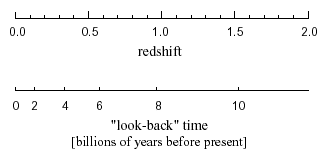
from a www.supernova.lbl.gov file SNAPoverview.pdf. to see that the time WHEN Ordinary Matter was 6% would have been a bit over 2 billion years ago, or 2 Gy BP.
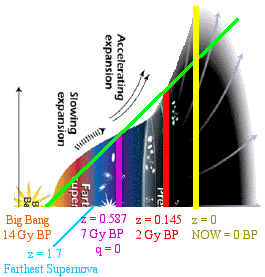
In the diagram, there are four Special Times in the history of our Universe:
Those four Special Times define four Special Epochs:
As to how the Dark Energy /\ and Cold Dark Matter terms have evolved during the past 2 Gy, a rough estimate analysis would be:
The Ordinary Matter excess 0.06 - 0.04 = 0.02 plus the first-order CDM excess 0.27 - 0.18 = 0.09 should be summed to get a total first-order excess of 0.11, which in turn should be distributed to the /\ and CDM factors in their natural ratio 67 : 27, producing, for NOW after 2 Gy of expansion:
for a total calculated Dark Energy : Dark Matter : Ordinary Matter ratio for NOW of 0.75 : 0.21 : 0.04
The quark content of a charged pion is a quark - antiquark pair: either Up plus antiDown or Down plus antiUp. Experimentally, its mass is about 139.57 MeV.
The quark is a Naked Singularity Kerr-Newman Black Hole, with electromagnetic charge e and spin angular momentum J and constituent mass M 312 MeV, such that e^2 + a^2 is greater than M^2 (where a = J / M).
The antiquark is a also Naked Singularity Kerr-Newman Black Hole, with electromagnetic charge e and spin angular momentum J and constituent mass M 312 MeV, such that e^2 + a^2 is greater than M^2 (where a = J / M).
According to General Relativity, by Robert M. Wald (Chicago 1984) page 338 [Problems] ... 4. ...:
"... Suppose two widely separated Kerr black holes with parameters ( M1 , J1 ) and ( M2 , J2 ) initially are at rest in an axisymmetric configuration, i.e., their rotation axes are aligned along the direction of their separation.Assume that these black holes fall together and coalesce into a single black hole.
Since angular momentum cannot be radiated away in an axisymmetric spacetime, the final black hole will have momentum J = J1 + J2. ...".
The neutral pion produced by the quark - antiquark pair would have zero angular momentum, thus reducing the value of e^2 + a^2 to e^2 .
For fermion electrons with spin 1/2, 1 / 2 = e / M (see for example Misner, Thorne, and Wheeler, Gravitation (Freeman 1972), page 883) so that M^2 = 4 e^2 is greater than e^2 for the electron. In other words, the angular momentum term a^2 is necessary to make e^2 + a^2 greater than M^2 so that the electron can be seen as a Kerr-Newman naked singularity.
Since the magnitude of electromagnetic charge of each quarks or antiquarks less than that of an electron, and since the mass of each quark or antiquark (as well as the pion mass) is greater than that of an electron, and since the quark - antiquark pair (as well as the pion) has angular momentum zero, the quark - antiquark pion has M^2 greater than e^2 + a^2 = e^2.
( Note that color charge, which is nonzero for the quark and the antiquark and is involved in the relation M^2 less than sum of spin-squared and charges-squared by which quarks and antiquarks can be see as Kerr-Newman naked singularities, is not relevant for the color-neutral pion. )
Therefore, the pion itself is a normal Kerr-Newman Black Hole with Outer Event Horizon = Ergosphere at r = 2M ( the Inner Event Horizon is only the origin at r = 0 ) as shown in this image
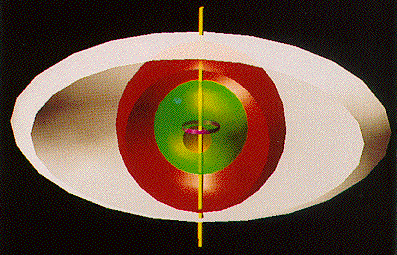
from Black Holes - A Traveller's Guide, by Clifford Pickover (Wiley 1996) in which the Ergosphere is white, the Outer Event Horizon is red, the Inner Event Horizon is green, and the Ring Singularity is purple. In the case of the pion, the white and red surfaces coincide, and the green surface is only a point at the origin.
According to section 3.6 of Jeffrey Winicour's 2001 Living Review of the Development of Numerical Evolution Codes for General Relativity (see also a 2005 update):
"... The black hole event horizon associated with ... slightly broken ... degeneracy [ of the axisymmetric configuration ]... reveals new features not seen in the degenerate case of the head-on collision ... If the degeneracy is slightly broken, the individual black holes form with spherical topology but as they approach, tidal distortion produces two sharp pincers on each black hole just prior to merger.... Tidal distortion of approaching black holes ...
... Formation of sharp pincers just prior to merger ..
... toroidal stage just after merger ...
At merger, the two pincers join to form a single ... toroidal black hole.
The inner hole of the torus subsequently [ begins to] close... up (superluminally) ... [ If the closing proceeds to completion, it ]... produce[s] first a peanut shaped black hole and finally a spherical black hole. ...".
In the physical case of quark and antiquark forming a pion, the toroidal black hole remains a torus. The torus is an event horizon and therefore is not a 2-spacelike dimensional torus, but is a (1+1)-dimensional torus with a timelike dimension.
The effect is described in detail in Robert Wald's book General Relativity (Chicago 1984). It can be said to be due to extreme frame dragging, or to timelike translations becoming spacelike as though they had been Wick rotated in Complex SpaceTime.
As Hawking and Ellis say in The LargeScale Structure of Space-Time (Cambridge 1973):
"... The surface r = r+ is ... the event horizon ... and is a null surface ...... On the surface r = r+ .... the wavefront corresponding to a point on this surface lies entirely within the surface. ...".
A (1+1)-dimensional torus with a timelike dimension can carry a Sine-Gordon Breather, and the soliton and antisoliton of a Sine-Gordon Breather correspond to the quark and antiquark that make up the pion.
Sine-Gordon Breathers are described by Sidney Coleman in his Erica lecture paper Classical Lumps and their Quantum Descendants (1975), reprinted in his book Aspects of Symmetry (Cambridge 1985), where Coleman writes the Lagrangian for the Sine-Gordon equation as ( Coleman's eq. 4.3 ):
L = (1 / B^2 ) ( (1/2) (df)^2 + A ( cos( f ) - 1 ) )
and Coleman says:
"... We see that, in classical physics, B is an irrelevant parameter: if we can solve the sine-Gordon equation for any non-zero B, we can solve it for any other B. The only effect of changing B is the trivial one of changing the energy and momentum assigned to a given soluition of the equation. This is not true in quantum physics, becasue the relevant object for quantum physics is not L but [ eq. 4.4 ]L / hbar = (1 / ( B^2 hbar ) ) ( (1/2) (df)^2 + A ( cos( f ) - 1 ) )
An other way of saying the same thing is to say that in quantum physics we have one more dimensional constant of nature, Planck's constant, than in classical physics. ... the classical limit, vanishingf hbar, is exactly the same as the small-coupling limit, vanishing B ... from now on I will ... set hbar equal to one. ...
... the sine-Gordon equation ...[ has ]... an exact periodic solution ...[ eq. 4.59 ]...
f( x, t ) = ( 4 / B ) arctan( ( n sin( w t ) / cosh( n w x ))
where [ eq. 4.60 ] n = sqrt( A - w^2 ) / w and w ranges from 0 to A. This solution has a simple physical interpretation ... a soliton far to the left ...[ and ]... an antisoliton far to the right. As sin( w t ) increases, the soliton and antisoliton mover farther apart from each other. When sin( w t ) passes thrpough one, they turn around and begin to approach one another. As sin( w t ) comes down to zero ... the soliton and antisoliton are on top of each other ... when sin( w t ) becomes negative .. the soliton and antisoliton have passed each other. ...[
This stereo image of a Sine-Gordon Breather was generated by the program 3D-Filmstrip for Macintosh by Richard Palais. You can see the stereo with red-green or red-cyan 3D glasses. The program is on the WWW at http://rsp.math.brandeis.edu/3D-Filmstrip. The Sine-Gordon Breather is confined in space (y-axis) but periodic in time (x-axis), and therefore naturally lives on the (1+1)-dimensional torus with a timelike dimension of the Event Horizon of the pion. ...]
... Thus, Eq. (4.59) can be thought of as a soliton and an antisoliton oscillation about their common center-of-mass. For this reason, it is called 'the doublet [ or Breather ] solution'. ... the energy of the doublet ...[ eq. 4.64 ]
E = 2 M sqrt( 1 - ( w^2 / A ) )
where [ eq. 4.65 ] M = 8 sqrt( A ) / B^2 is the soliton mass. Note that the mass of the doublet is always less than twice the soliton mass, as we would expect from a soltion-antisoliton pair. ... Dashen, Hasslacher, and Neveu ... Phys. Rev. D10, 4114; 4130; 4138 (1974). A pedagogical review of these methods has been written by R. Rajaraman ( Phys. Reports 21, 227 (1975 ... Phys. Rev. D11, 3424 (1975) ...[ Dashen, Hasslacher, and Neveu found that ]... there is only a single series of bound states, labeled by the integer N ... The energies ... are ... [ eq. 4.82 ]
E_N = 2 M sin( B'^2 N / 16 )
where N = 0, 1, 2 ... < 8 pi / B'^2 , [ eq. 4.83 ]
B'^2 = B^2 / ( 1 - ( B^2 / 8 pi ))
and M is the soliton mass. M is not given by Eq. ( 4.675 ), but is the soliton mass corrected by the DHN formula, or, equivalently, by the first-order weak coupling expansion. ... I have written the equation in this form .. to eliminate A, and thus avoid worries about renormalization conventions. Note that the DHN formula is identical to the Bohr-Sommerfeld formula, except that B is replaced by B'. ... Bohr and Sommerfeld['s] ... quantization formula says that if we have a one-parameter family of periodic motions, labeled by the period, T, then an energy eigenstate occurs whenever [ eq. 4.66 ]
[ Integral from 0 to T ]( dt p qdot = 2 pi N,
where N is an integer. ... Eq.( 4.66 ) is cruder than the WKB formula, but it is much more general; it is always the leading approximation for any dynamical system ... Dashen et al speculate that Eq. ( 4.82 ) is exact. ...
the sine-Gordon equation is equivalent ... to the massive Thirring model. This is surprising, because the massive Thirring model is a canonical field theory whose Hamiltonian is expressedin terms of fundamental Fermi fields only. Even more surprising, when B^2 = 4 pi , that sine-Gordon equation is equivalent to a free massive Dirac theory, in one spatial dimension. ... Furthermore, we can identify the mass term in the Thirring model with the sine-Gordon interaction, [ eq. 5.13 ]
M = - ( A / B^2 ) N_m cos( B f )
.. to do this consistently ... we must say [ eq. 5.14 ]
B^2 / ( 4 pi ) = 1 / ( 1 + g / pi )
....[where]... g is a free parameter, the coupling constant [ for the Thirring model ]... Note that if B^2 = 4 pi , g = 0 , and the sine-Gordon equation is the theory of a free massive Dirac field. ... It is a bit surprising to see a fermion appearing as a coherent state of a Bose field. Certainly this could not happen in three dimensions, where it would be forbidden by the spin-statistics theorem. However, there is no spin-statistics theorem in one dimension, for the excellent reason that there is no spin. ... the lowest fermion-antifermion bound state of the massive Thirring model is an obvious candidate for the fundamental meson of sine-Gordon theory. ... equation ( 4.82 ) predicts that all the doublet bound states disappear when B^2 exceeds 4 pi . This is precisely the point where the Thirring model interaction switches from attractive to repulsive. ... these two theories ... the massive Thirring model .. and ... the sine-Gordon equation ... define identical physics. ... I have computed the predictions of ...[various]... approximation methods for the ration of the soliton mass to the meson mass for three values of B^2 : 4 pi (where the qualitative picture of the soliton as a lump totally breaks down), 2 pi, and pi . At 4 pi we know the exact answer ... I happen to know the exact answer for 2 pi, so I have included this in the table. ...
Method B^2 = pi B^2 = 2 pi B^2 = 4 pi
Zeroth-order weak coupling
expansion eq2.13b 2.55 1.27 0.64
Coherent-state variation 2.55 1.27 0.64
First-order weak
coupling expansion 2.23 0.95 0.32
Bohr-Sommerfeld eq4.64 2.56 1.31 0.71
DHN formula eq4.82 2.25 1.00 0.50
Exact ? 1.00 0.50
...[eq. 2.13b ] E = 8 sqrt(A) / B^2 ...[ is the ]... energy of the lump ... of sine-Gordon theory ... frequently called 'soliton...' in the literature ... [ Zeroth-order is the classical case, or classical limit. ] ...
... Coherent-state variation always gives the same result as the ... Zeroth-order weak coupling expansion ... .
The ... First-order weak-coupling expansion ... explicit formula ... is ( 8 / B^2 ) - ( 1 / pi ). ...".
Note that, using the VoDou Physics constituent mass of the Up and Down quarks and antiquarks, about 312.75 MeV, as the soliton and antisoliton masses, and setting B^2 = pi and using the DHN formula, the mass of the charged pion is calculated to be
which is in pretty good agreement with the experimental value of about 139.57 MeV.
Because B^2 = pi is where the First-order weak coupling expansion substantially coincides with the ( probably exact ) DHN formula.
In other words, the physical quark - antiquark pion lives where the first-order weak coupling expansion is exact.
Near the end of his article, Coleman expressed "Some opinions":
"... This has been a long series of physics lectures with no reference whatsoever to experiment. This is embarrassing.... Is there any chance that the lump will be more than a theoretical toy in our field? I can think of two possiblities.
One is that there will appear a theory of strong-interaction dynamics in which hadrons are thought of as lumps, or, ... as systems of quarks bound into lumps. ... I am pessimistic about the success of such a theory. ... However, I stand ready to be converted in a moment by a convincing computation.
The other possibility is that a lump will appear in a realistic theory ... of weak and electromagnetic interactions ... the theory would have to imbed the U(1)xSU(2) group ... in a larger group without U(1) factors ... it would be a magnetic monopole. ...".
This description of the hadronic pion as a quark - antiquark system governed by the sine-Gordon - massive Thirring model should dispel Coleman's pessimism about his first stated possibility and relieve his embarrassment about lack of contact with experiment.
As to his second stated possibility, very massive monopoles related to SU(5) GUT are still within the realm of possible future experimental discoveries.
Further material about the sine-Gordon doublet Breather and the massive Thirring equation can be found in the book Solitons and Instantons (North-Holland 1982,1987) by R. Rajaraman, who writes:
"... the doublet or breather solutions ... can be used as input into the WKB method. ... the system is ... equivalent to the massive Thirring model, with the SG soliton state identifiable as a fermion. ... Mass of the quantum soliton ... will consist of a classical term followed by quantum corrections. The energy of the classical soliton ... is ... [ eq. 7.3 ]E_cl[f_sol] = 8 m^3 / L
The quantum corrections ... to the 'soliton mass' ... is finite as the momentum cut-off goes to infinity and equals ( - m / pi ). Hence the quantum soliton's mass is [ eq. 7.10 ]
M_sol =( 8 m^3 / L ) - ( m / pi ) +O(L).
The mass of the quantum antisoliton will be, by ... symmetry, the same as M_sol. ...
The doublet solutions ... may be quantised by the WKB method. ... we see that the coupling constant ( L / m^2 ) has been replaced by a 'renormalised' coupling constant G ... [ eq. 7.24 ]
G = ( L / m^2 ) / ( 1 - ( L / 8 pi m^2 ))
... as a result of quantum corrections. ... the same thing had happened to the soliton mass in eq. ( 7.10 ). To leading order, we can write [ eq. 7.25 ]
M_sol = ( 8 m^3 / L ) - ( m / pi ) = 8 m / G
... The doublet masses ... bound-state energy levels ... E = M_N, where ... [ eq. 7.28 ]
M_N = ( 16 m / G ) sin( N G / 16 ) ; N = 1, 2, ... < 8 pi / G
Formally, the quantisation condition permits all integers N from 1 to oo , but we run out of classical doublet solutions on which these bound states are based when N > 8 pi / G . ... The classical solutions ... bear the same relation to the bound-state wavefunctionals ... that Bohr orbits bear to hydrogen atom wavefunctions. ...
Coleman ... show[ed] explicitly ... the SG theory equivalent to the charge-zero sector of the MT model, provided ... L / 4 pi m^2 = 1 / ( 1 + g / pi )
...[ where in Coleman's work set out above such as his eq. ( 5.14 ) , B^2 = L / m^2 ]...
Coleman ... resurrected Skyrme's conjecture that the quantum soliton of the SG model may be identified with the fermion of the MT model. ... ".
The quark content of the charged pion is u_d or d_u , both of which are consistent with the sine-Gordon picture. Experimentally, its mass is 139.57 Mev.
The neutral pion has quark content (u_u + d_d)/sqrt(2) with two components, somewhat different from the sine-Gordon picture, and a mass of 134.96 Mev.
The effective constituent mass of a down valence quark increases (by swapping places with a strange sea quark) by about DcMdquark = (Ms - Md) (Md/Ms)2 aw V12 = 312x0.25x0.253x0.22 Mev = 4.3 Mev.
Similarly, the up quark color force mass increase is about
DcMuquark = (Mc - Mu) (Mu/Mc)2 aw V12 = 1777x0.022x0.253x0.22 Mev = 2.2 Mev.
The color force increase for the charged pion DcMpion± = 6.5 Mev.
Since the mass Mpion± = 139.57 Mev is calculated from a color force sine-Gordon soliton state, the mass 139.57 Mev already takes DcMpion± into account.
For pion0 = (u_u + d_d)/ sqrt 2 , the d and _d of the the d_d pair do not swap places with strange sea quarks very often because it is energetically preferential for them both to become a u_u pair.
Therefore, from the point of view of calculating DcMpion0, the pion0 should be considered to be only u_u , and DcMpion0 = 2.2+2.2 = 4.4 Mev.
If, as in the nucleon, DeM(pion0-pion±) = -1 Mev, the theoretical estimate is
DM(pion0-pion±) = DcM(pion0-pion±) + DeM(pion0-pion±) = 4.4 - 6.5 -1 = -3.1 Mev,
roughly consistent with the experimental value of -4.6 Mev.
According to the 1986 CODATA Bulletin No. 63, the experimental value of the neutron mass is 939.56563(28) Mev, and the experimental value of the proton is 938.27231(28) Mev.
The neutron-proton mass difference 1.3 Mev is due to the fact that the proton consists of two up quarks and one down quark, while the neutron consists of one up quark and two down quarks.
The magnitude of the electromagnetic energy difference mN - mP is about 1 Mev, but the sign is wrong: mN - mP = -1 Mev, and the proton's electromagnetic mass is greater than the neutron's.
The difference in energy between the bound states, neutron and proton, is not due to a difference between the Pre-Quantum constituent masses of the up quark and the down quark, which are calculated in the E8 model to be equal.
It is due to the difference between the Quantum color force interactions of the up and down constituent valence quarks with the gluons and virtual sea quarks in the neutron and the proton.
An up valence quark, constituent mass 313 Mev, does not often swap places with a 2.09 Gev charm sea quark, but a 313 Mev down valence quark can more often swap places with a 625 Mev strange sea quark.
Therefore the Quantum color force constituent mass of the down valence quark is heavier by about
(ms - md) (md/ms)^2 a(w) |Vds| = 312 x 0.25 x 0.253 x 0.22 Mev = 4.3 Mev,
so that the Quantum color force constituent mass Qmd of the down quark is
Similarly,
the up quark Quantum color force mass increase is about
(mc - mu) (mu/mc)^2 a(w) |V(uc)| = 1777 x 0.022 x 0.253 x 0.22 Mev = 2.2 Mev,
so that the Quantum color force constituent mass Qmu of the up quark is
Therefore, the Quantum color force Neutron-Proton mass difference is
Since the electromagnetic Neutron-Proton mass difference is roughly mN - mP = -1 MeV
the total theoretical Neutron-Proton mass difference is
an estimate that is fairly close to the experimental value of 1.3 Mev.
Note that in the equation (ms - md) (md/ms)^2 a(w) |Vds| = 4.3 Mev , Vds is a mixing of down and strange by a neutral Z0, compared to the more conventional Vus mixing by charged W. Although real neutral Z0 processes are suppressed by the GIM mechanism, which is a cancellation of virtual processes, the process of the equation is strictly a virtual process.
Note also that the K-M mixing parameter |Vds| is linear. Mixing (such as between a down quark and a strange quark) is a two-step process, that goes approximately as the square of |Vds|:
Only the first step (one factor of |Vds|) appears in the Quantum mass formula used to determine the neutron mass.
If you measure the mass of a neutron, that measurement includes a sum over a lot of histories of the valence quarks inside the neutron. In some of those histories, in my view, you will "see" some of the two valence down quarks in a virtual transition state that is at a time after the first action, or change from down to strange, and before the second action, or change back. Therefore, you should take into account those histories in the sum in which you see a strange valence quark, and you get the linear factor |Vds| in the above equation.
In the E8 model, a Planck-mass black hole is not a tree-level classical particle such as an electron or a quark, but a quantum entity resulting from the Many-Worlds quantum sum over histories at a single point in spacetime.
Consider an isolated single point, or vertex in the lattice picture of spacetime. In the E8 model, fermions live on vertices, and only first-generation fermions can live on a single vertex. (The second-generation fermions live on two vertices that act at our energy levels very much like one, and the third-generation fermions live on three vertices that act at our energy levels very much like one.)
At a single spacetime vertex, a Planck-mass black hole is the Many-Worlds quantum sum of all possible virtual first-generation particle-antiparticle fermion pairs permitted by the Pauli exclusion principle to live on that vertex.
Once a Planck-mass black hole is formed, it is stable in the E8 model. Less mass would not be gravitationally bound at the vertex. More mass at the vertex would decay by Hawking radiation.
In the E8 model, a Planck-mass black hole can be formed: as the end product of Hawking radiation decay of a larger black hole; by vacuum fluctuation; or perhaps by using a pion laser.
Since Dirac fermions in 4-dimensional spacetime can be massive (and are massive at low enough energies for the Higgs mechanism to act), the Planck mass in 4-dimensional spacetime is the sum of masses of all possible virtual first-generation particle-antiparticle fermion pairs permitted by the Pauli exclusion principle.
There are 8 fermion particles and 8 fermion antiparticles for a total of 64 particle-antiparticle pairs. A typical combination should have several quarks, several antiquarks, a few colorless quark-antiquark pairs that would be equivalent to pions, and some leptons and antileptons.
Due to the Pauli exclusion principle, no fermion lepton or quark could be present at the vertex more than twice unless they are in the form of boson pions, colorless first-generation quark-antiquark pairs not subject to the Pauli exclusion principle. Of the 64 particle-antiparticle pairs, 12 are pions.
A typical combination should have about 6 pions.
If all the pions are independent, the typical combination should have a mass of about .14x6 GeV = 0.84 GeV. However, just as the pion mass of .14 GeV is less than the sum of the masses of a quark and an antiquark, pairs of oppositely charged pions may form a bound state of less mass than the sum of two pion masses. If such a bound state of oppositely charged pions has a mass as small as .1 GeV, and if the typical combination has one such pair and 4 other pions, then the typical combination could have a mass in the range of 0.66 GeV.
Summing over all 2^64 combinations, the total mass of a one-vertex universe should give a Planck mass roughly around 0.66 x 2^64 = 1.217 x 10^19 GeV.
Since each fermion particle has a corresponding antiparticle, a Planck-mass Black Hole is neutral with respect to electric and color charges.
The value for the Planck mass given in the Particle Data Group's 1998 review is 1.221 x 10^19 GeV.
Each E8 or Cl(8) only describes physics in a Local Neighborhood ( it takes the Algebraic Quantum Field Theory of the Generalized Hyperfinite II1 von Neumann Factor to describe a more global theory ).
Consider the E8(8) root vector polytope

and particularly the central 24 vertices:

made up of 8+8+8 = 24 central vertices.
If consider the 24-dim space generated by those 24 elements,
and consider the 24-dimensional Leech Lattice as a lattice in that 24-dim space,
and then compactify the 24-dim space by taking its quotient modulo the Leech Lattice,
you get a representation of a single E8 alone, the simplest building block element of the full E8 model.
According to James Lepowsky in math.QA/0706.4072:
"... the Fischer-Griess Monster M ... was constructed by Griess as a symmetry group (of order about 10^54) of a remarkable new commutative but very, very highly nonassociative, seemingly ad-hoc, algebra B of dimension 196,883. ... One takes the torus that is the quotient of 24-dimensional Euclidean space modulo the Leech lattice ... The Monster is the automorphism group of the smallest nontrival string theory that nature allows ... Bosonic 26-dimensional space-time ... "compactified" on 24 dimensions ...".
It is a conjecture that the Monster is also the automorphism group of the smallest nontrivial part of the E8 model, and that the common relationship to the Monster might show an equivalence of the E8 model and the 26-dim Bosonic String Model (with fermions from orbifolding) described at CERN-CDS-EXT-2004-031. It might even be that both the E8 model and such String models are substantially equivalent to a Spin Foam model with E8(8) structures organized according to the 27-dim exceptional Jordan algebra J3(O).
As to possible physical meaning of such Monster symmetry of elemental E8 model structures, consider that the order of the Monster Group is
=
2^46 .3^20 .5^9 .7^6 .11^2 .13^3 .17.19.23.29.31.41.47.59.71
or about 8 x 10^53.
If you use positronium (electron-positron bound state of the two lowest-nonzero-mass Dirac fermions) as a unit of mass Mep = 1 MeV, then it is interesting that the product of the squares of the Planck mass Mpl = 1.2 x 10^22 MeV and W-boson mass Mw = 80,000 MeV gives ( ( Mpl/Mep )( Mw/Mep) )^2 = 9 x 10^53 which is roughly the Monster order.
If you look at the physically realistic superposition of 8 such Cells, you get 8 copies of the Monster of total order about 6.4 x 10^54, which is roughly the product of the Planck mass and Higgs VEV squared:
The full 26-dimensional Lattice Bosonic String Theory, and the full E8 model, and the full J3(O) Spin Foam model, might in that view all be regarded as an infinite-dimensional Affinization of the Theory of that Single Cell.
In his book Quaternionic Quantum Mechanics and Quantum Fields ((Oxford 1995), Stephen L. Adler says at pages 50-52, 561:
"... If the multiplication is associative, as in the complex and quaternionic cases, we can remove parentheses in ... Schroedinger equation dynamics ... to conclude that ... the inner product < f(t) | g(t) > ... is invariant ... this proof fails in the octonionic case, and hence one cannot follow the standard procedure to get a unitary dynamics. ...[sothere is a]... failure of unitarity in octonionic quantum mechanics...".
Conventionally, creation of the particles in our universe occurred during inflation with unitarity and energy conservation being due to an inflaton field that is addition to the fields we now observe in the Standard Model plus Gravity.
In the E8 model, our present 4-dimensional physical spacetime freezes out from a high-energy 8-dimensional octonionic spacetime due to selection of a preferred quaternionic subspacetime. A question is whether the dimensional reduction occurs at the initial Big Bang beginning of inflation or continues through inflation to its end.
If our spacetime remains octonionic 8-dimensional throughout inflation, then the non-associativity and non-unitarity of octonions might account for particle creation without the need for tapping the energy of an inflaton field.
The non-associative structure of octonions manifests itself in interesting ways, such as the expansion of the 7-dim 7-sphere S7 under the Lie algebra bracket operation to the 28-dim Lie algebra Spin(8) that is made up of two S7 spheres and a 14-dim G2 Lie algebra.
Consider that the initial Big Bang produced a particle-antiparticle pair of the 7 charged fermions, plus the 8th fermion (neutrino) corresponding to the real number 1.
In gr-qc/0007006 Paola Zizzi says:
"... during inflation, the universe can be described as a superposed state of quantum ... [ qubits ]. The self-reduction of the superposed quantum state is ... reached at the end of inflation ...[at]... the decoherence time ... [ Tdecoh = 10^9 Tplanck = 10^(-34) sec ] ... and corresponds to a superposed state of ... [ 10^19 = 2^64 qubits ]. ... ... This is also the number of superposed tubulins-qubits in our brain ... leading to a conscious event. ...".
The number of doublings (also known as e-foldings) is also estimated by in astro-ph/0307459, by Banks and Fischler, who say:
"... If the present acceleration of the universe is due to an asymptotically deSitter universe with small cosmological constant, then the number of e-foldings during inflation is bounded. ... The essential ingredient is that because of the UV-IR connection, entropy requires storage space. The existence of a small cosmological constant restricts the available storage space. ... We obtain the upper bound ... N_e = 85 ... where we took [the cosmological constant] /\ to be of O(10^(-3) eV ). For the sake of comparison, the case k = 1/3 [ corresponding to the equation of state for a radiation-dominated fluid, such as the cosmic microwave background ] yields ... N_e= 65 ... This value for the maximum number of e-foldings is close to the value necessary to solve the "horizon problem".
If at each of the 64 doubling stages of Zizzi inflation the 2 particles of such a pair produced 8+8 = 16 fermions,
then at the end of inflation such a non-unitary octonionic process would have produced about 2 x 16^64 = 4 x (2^4)^64 = 4 x 2^256 = 4 x 10^77 fermion particles.
The figure of 4 x 10^77 is similar number of particles estimated by considering the initial fluctuation to be a Planck mass Black Hole and the 64 doublings to act on such Black Holes (which process can also be considered due to octonionic non-associativity non-unitarity).
Roger Penrose, in his book The Emperor's New Mind (Oxford 1989, pages 316-317) said:
"... in our universe ... Entropy ... increases ... Something forced the entropy to be low in the past. ... the low-entropy states in the past are a puzzle. ...".
The Zizzi Inflation phase of our universe ends with decoherence "collapse" of the 2^64 Superposition Inflated Universe into Many Worlds of the Many-Worlds Quantum Theory, only one of which Worlds is our World.
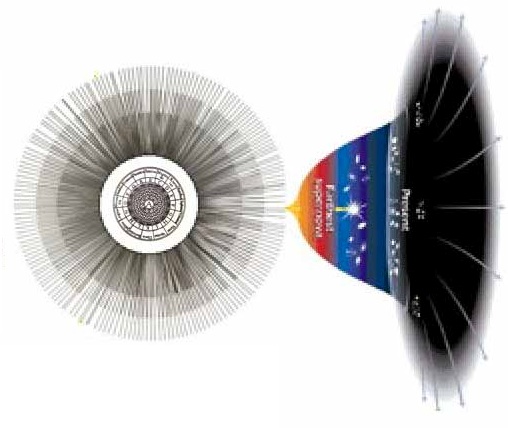
In this image:
Since our World is only a tiny fraction of all the Worlds, it carries only a tiny fraction of the entropy of the 2^64 Superposition Inflated Universe, thus solving Penrose's Puzzle.
Penrose (in his book The Emperor's New Mind (Oxford 1989, page 339)) proposed that the solution of his Puzzle might be related to Weyl Curvature, saying
"... For some reason, the universe was created in a very special (low entropy) state, with something like the WEYL = 0 constraint of the FRW-models imposed upon it ...".
In the book The Dawning of Gauge Theory (Princeton 1997, pages 45,77-81,86,120,144) Lochlainn O'Raifeartaigh said:
"... Weyl's ... 1918 paper ... showed how a geometrical significance could be ascribed to the electromagnetic field ... in 1922 ... Shroedinger ... suggested ... the flaw in the original Weyl theory might be removed by quantum mechanics ... the exponent of the non-integrable Weyl factor became quantized ...... London in his 1927 paper ... establish[ed] the relation between Weyl's non-integrable scale factor and the gauge principle as it ocurs in the Hamilton-Jacobi, de Broglie and Schroedinger equations ... it is the complex amplitude of the de Broglie wave ... The fault in Weyl's original theory lay not in the presence of Weyl's non-integrable scale-factor but in the fact that it was real and applied to the metric. It should be converted to a phase-factor and applied to the wave-function. ... Weyl's reaction ... was ... enthusiasm ... in ... 1929 ... electromagnetism is an accompanying phenomenon of the material wave-field and not of gravitation ...
... Pauli proceeded to incorporate many of Weyl's ideas into his Handbuch article and by 1953 he had become an ardent proponent of the gauge principle ...".
In the early 1950s, Bohm developed his theory, an elaboration of de Broglie-Schroedinger quantum theory.
In physics/0211012 B. G. Sidharth said:
"... Santamato ... Phys.Rev.D. 29 (2), 216ff, 1984 ... J. Math. Phys. 26 (8), 2477ff, 1984 ... Phys.Rev.D 32 (10), 2615ff, 1985 ... further developed the deBroglie-Bohm formulation by relating the ... Quantum potential to ... Weyl's geometry ...".
In The Anthropic Cosmological Principle (Oxford 1986, pages 446-447) Barrow and Tipler said:
"... Penrose ... suggested that the Weyl curvature could be intimately related to the gravitational entropy of space-time ... Unfortunately, as yet there is no obvous candidate to use as a gravitational entropy Sg ...".
As Penrose said in his book The Emperor's New Mind (Oxford 1989, pages 210-211):
"... REIMANN = WEYL + RICCI ... Einstein's equations become ... RICCI = ENERGY ...The Weyl tensor WEYL measures a tidal distortion of our sphere of freely falling particles (i.e., an initial change in shape, rather than in size), and the Ricci tensor RICCI measures its initial change in volume. ... the Weyl tensor ... is an important quantity. The tidal effect that is experienced in empty space is entirely due to WEYL. ... there are differential equations connecting WEYL with ENERGY, rather like the Maxwell equations ... a fruitful point of view is to regard WEYL as a kind of gravitational analogue of the electromagnetic field quantity ...".
These remarks of Penrose seem to me to justify seeing the Weyl curvature as a Weyl gauge quantum phase for a Bohm-type Quantum Potential, especially in view of my model in which the Bohm-type Quantum Potential comes from what is commonly viewed as a gravitational part of Bosonic String Theory and in which Many-Worlds gravitational superposition separation plays a fundamental role in Quantum Consciousness.
Since, from the Many-Worlds point of view, the branching of the Worlds of our Universe as time moves forward towards the future might give a realistic definition of gravitational entropy Sg and since Deutsch has indicated that the Bohm potential can be seen to be equivalent to Many-Worlds Quantum theory, it seems to me that the Weyl-Schroedinger-London-Santamato description of the Quantum potential in terms of Weyl curvature could be seen as Penrose's Weyl curvature entropy.
Moreover, the fact that the Weyl curvature WEYL is the conformal part of the RIEMANN tensor is interesting, and the unification of RICCI for gravity and WEYL for quantum potential indicate to me that Jack Sarfatti's idea that BOTH should have back-reaction may be correct.
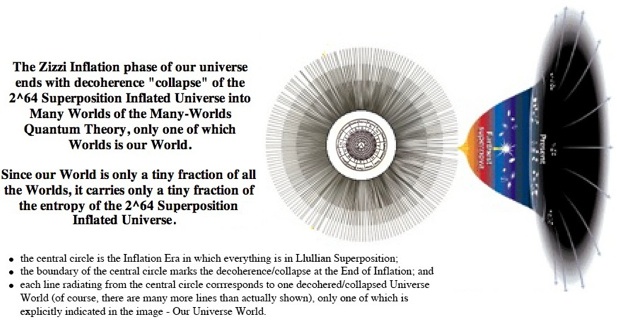
At T = 10^19 GeV, the Planck Mass/Energy, the Inflation Era begins.
At T = 10^16 GeV, the SU(5) Monopole Mass/Energy ... [ According to The Early Universe, by G. Borner (Springer-Verlag 1988), from which book's Fig. 6.21 the SU(5) GUT illustration below is taken,
"... For GUT physics monopoles are extremely interesting objects: they have an onion-like structure ... which contains the whole world of grand unified theories.Near the center ( about 10^(-29) cm ) there is a GUT symmetric vacuum.
At about 10^(-16) cm, out to the Yukawa tail ... exp( - Mw r ), the field is the electroweak colour field of the (3,2,1) standard model, and
at ...[10^(-15) cm]... it is made up of photons and gluons, while
at the edge [ 10^(-13) cm ] there are fermion-antifermion pairs.
Far beyond nuclear distances it behaves as a magnetically-charged pole of the Dirac type.
This view of the GUT monopole raises the possibility that it may catalyze the decay of the proton ...". ]...
SU(5) GUT Monopole formation ends and the Inflationary X-Boson Higgs mechanism eliminates the relic Monopoles.
According to The Early Universe, by Kolb and Turner (1994 paperback edition, Adddison-Wesley, page 526):
"... the full symmetry of the GUT cannot be manifest; if it were the proton would decay in 10^(-24) sec. The gauge group ... must be spontaneously broken to [ SU(3) x SU(2) x U(1) ]. For SU(5), this is accomplished by ... masses of the order of the unification scale for the twelve X ... gauge bosons. ...[
X color charges X electric charges
3 3 3 X X red red -4/3 -1/3
3 3 3 X X green green -4/3 -1/3
3 3 3 X X blue blue -4/3 -1/3
X X X 2 2 antired antigreen antiblue +4/3 +4/3 +4/3
X X X 2 2 antired antigreen antiblue +1/3 +1/3 +1/3
]... Thus, ... at energies below 10^14 GeV or so the processes mediated by X ... boson exchange can be treated as a four-fermion interaction with strength ... [proportional to 1 / M^2 ] ... where M = 3 x 10^14 GeV is the unification scale. ... these new ... interactions are extremely weak at energies below 10^14 GeV. ... the proton lifetime must be ...[about]... 10^31 yr. ...".
In The Early Universe (paperback edition Addison-Wesley 1994) Kolb and Turner say (at p. 526):
"... SU(5) GUT ...[has]... at the very least one complex 5-dimensional Higgs. The 5-dimensional Higgs containsthe usual doublet Higgs required for W-Boson SSB ...[which]... must acquire a mass of order of a few 100 GeV and
a color triplet Higgs ... which can also mediate B,L [baryon,lepton] violation. The triplet component must acquire a mass comparable to ... M = 3 x 10^14 GeV ... to guarantee the proton's longevity, ...".
At T = 10^15 GeV or about 10^(-34) sec the size of Our Universe is about 10 cm, and the Inflation Era ends.
At T = 10^14 GeV, the SU(5) X-Boson Mass/Energy, Zizzi Reheating occurs and SU(5) Unification ends. At the phase transition at 10^14 GeV the GUT SU(5) is broken to U(3)xU(2)
3 3 3
3 3 3
3 3 3
2 2
2 2
and then to the Standard Model SU(3) x SU(2) x U(1) with the usual Higgs doublet with VEV around 250 GeV.
After the Inflation Era, Our Universe begins its current phase of expansion

controlled by Gravity according to a MacDowell-Mansouri Mechanism based on the Conformal Group Spin(2,4) = SU(2,2) with 15 generators:
According to gr-qc/9809061 by R. Aldrovandi and J. G. Peireira:
"... By the process of Inonu-Wigner group contraction taking the limit R -> 0, ...[where R is the de Sitter pseudo-radius, the] ... de Sitter group... [ whether of metric ... (-1,+1,+1,+1,-1) or (-1,+1,+1,+1,+1) , is]... contracted to the group Q, formed by a semi-direct product between Lorentz and special conformal transformation groups, and ... de Sitter space...[is]... reduced to the cone-space N, which is a space with vanishing Riemann and Ricci curvature tensors. As the scalar curvature of the de Sitter space goes to infinity in this limit, we can say that N is a spacetime gravitationally related to an infinite cosmological constant.".
If the 2+4 = 6-dimensional spacetime on which the full Conformal Group Spin(2,4) acts linearly is viewed in terms of an elastic Aether, its rigidity would correspond to the VEV of the X-Boson Higgs Condensate on the order of 10^14 GeV. Since the action of the Conformal Group Spin(2,4) = SU(2,2) is nonlinear on 4-dimensional physical spacetime, the 4-dimensional elastic Aether can, within the Conformal Expanding Domain of Our Universe, be deformed by Special Conformal and Dilation transformations without the restrictions of X-Higgs VEV rigidity on the order of 10^14 GeV.
The Aldrovandi-Peireira paper shows that the 10 Generators (4 Special Conformal and 6 Lorentz) describe Our Universe expanding due to Dark Energy (also known, somewhat inaccurately as it is variable, a cosmological constant).
What about the other Generators?
Those 15 Conformal Group Spin(2,4) = SU(2,2) Generators indicate that the basic tree-level ratio Dark Energy : Dark Matter : Ordinary Matter is 10 : 4 : 1 = 67 : 27 : 6 . After taking into account the history of Our Universe to the Present Time, that ratio is calculated in the E8 model to be, as of Now, consistent with observations including WMAP:
After conventional expansion of our universe begins, some regions of our Universe become Gravitationally Bound Domains (such as, for example, Galaxies) in which the 4 Conformal GraviPhoton generators are frozen out, forming domains within our Universe like IceBergs in an Ocean of Water. Within each Gravitationally Bound Domain, spacetime (regarded as Aether) is incompressible with a rigidity on the order of the W-Boson Higgs VEV = 250 GeV.
On a large scale (billions of light years), the Gravitationally Bound Domains are roughly traced out by Galaxies and Clusters of Galaxies
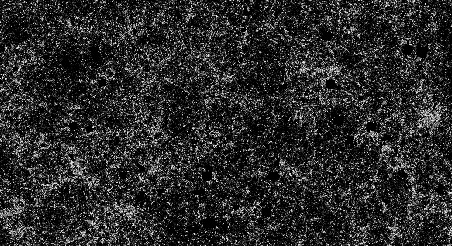
so the the white dots would be the Gravitationally Bound Domains (like rigid pennies on an expanding balloon, or rigid raisins in an expanding cake) and the black background would be the Conformal Expanding Domain of Our Universe.
When the Gravitationally Bound Domains begin to form as Galaxy Cluster Structures in the early stages of the current phase of expansion of Our Universe, according to a 6 December 2006 caption to ESO PR Photo 45/06
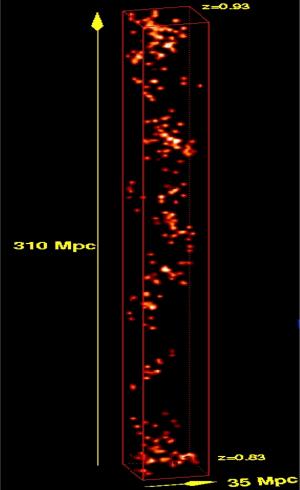
"... Spatial, three-dimensional distribution of galaxies in a slice of the Universe as it was 7 billion years ago, based on the VVDS study: brighter areas represent the regions of the Universe with most galaxies. Astonishingly, the galaxy distribution - the 'building blocks' of the large scale structure - takes the shape of a helix at this primordial epoch. ...".
Such a helical structure suggests that helical magnetic fields might be involved in galaxy formation. Further, Battaner et al, in in astro-ph/9801276, astro-ph/9802009, and astro-ph/9911423, suggest that the simplest network pattern for distribution of superclusters of galaxies that is compatible with magnetic field constraints
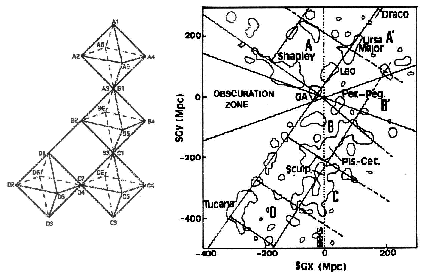
is made up of octahedra contacting at their vertexes, which is related to a tiling of 3-dim space by cuboctahedra and octahedra, and also to the heptaverton of Arthur Young and octonionic structures of Onar Aam.
Within each Gravitationally Bound Domains there can exist Islands of Conformal Expansion in which all 15 generators of Conformal Spin(2,4) = SU(2,2) remain effective,
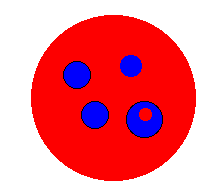
like Puddles of Water (red) on an IceBerg (blue) floating in an Ocean of Water (red), so the overall structure of Our Universe in terms of Gravitationally Bound Domains (pennies, raisins, IceBergs) and Conformal Expanding Domains (balloon, cake, water) is quite complicated.
To get some feeling for this structure, begin by considering Clusters of Galaxies to be the largest Gravitationally Bound Domains and then looking at the next level down in sixe, Galaxies. As Hartmann and Miller say in their book Cycles of Fire (Workman Publishing 1987)
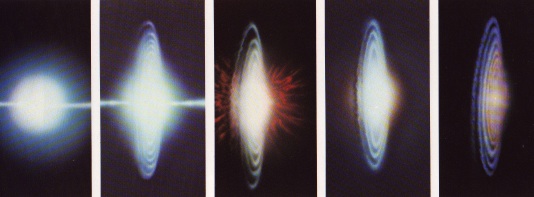
Going down one more level in size, to Stars and Stellar Systems like Our Solar System, Hartmann and Miller describe
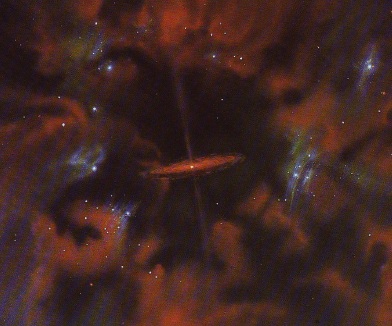
"... a star just formed ...[in]... its disk-shaped cocoon nebula some of which is being blown out in bipolar jets ... near a dark molecular cloud ... embedded in a ... nebular region ... The dust in the cocoon reddens the star's light ...".
Kohji Tomisaka of Niigata University says in astro-ph/9911166:
"... the star formation process ... angular momentum transfer in the contraction of a rotating magnetized cloud is studied with axisymmetric MHD simulations. Owing to the large dynamic range covered by the nested-grid method, the structure of the cloud in the range from 10 AU to 0.1 pc is explored. First, the cloud experiences a run-away collapse, and a disk forms perpendicularly to the magnetic field, in which the central density increases greatly in a finite time-scale. In this phase, the specific angular momentum j of the disk decreases to about 1/3 of the initial cloud. After the central density of the disk exceeds about 10^10 cm ^(-3) , the infall on to the central object develops. In this accretion stage, the rotation motion and thus the toroidal magnetic field drive the outflow. The angular momentum of the central object is transferred efficiently by the out\flow as well as the effect of the magnetic stress. ... the seeding region (origin of the outflow) ... expands radially outward. This outflow is driven by the gradient of the magnetic pressure of the toroidal magnetic fields ... which are made by the rotation motion ... The magnetic fields exert torque on the outflowing gas to increase its angular momentum. On the other hand, they exert torque on the disk to decrease the angular momentum ... [in about 7000 years] ... the outflow expands and reaches ... [about 4 AU] ... The angular momentum distribution at that time ... has been reduced to ... a factor of 10 ^(-4) from the initial value (i.e. from 10^20 cm^2 s ^(-1) to 10^16 cm^2 s ^(-1)). ... the coupling between gas and magnetic fields ... becomes stronger as long as we consider the seeding region, indicating that the mechanism of angular momentum transfer works also in the later stage of the evolution [after 7000 years]. ...".
If you look closely at the central star in the star-formation image above, you might see Birkeland Current Loops (image from thesurfaceofthesun.com web page) that look up close like Solar Coronal Loops (image from electric-cosmos.org/sun.htm web page).
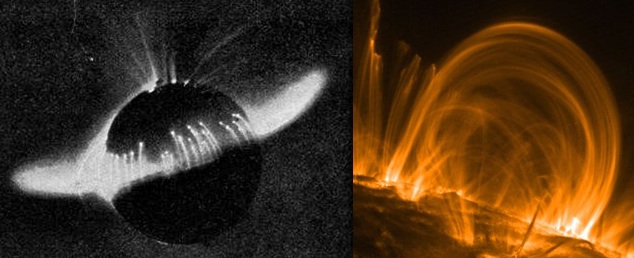
Up close, Birkeland Current Loops are seen to have braided filament structure (Cygnus Loop image from antwrp.gsfc.nasa.gov.
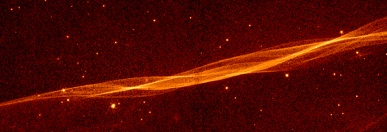
The scale of Birkeland Current Loops extends beyond Stellar to Galactic (images, SOHO of Sun and NRAO of Fornax A from thunderbolts.info webpage, which said as to NGC
"... a tiny but energy-dense plasmoid at the center of the galaxy ... Fornax A ... discharges energy along oppositely-directed Birkeland filaments (invisible in this image) into the radio lobes. Diffuse currents loop back from the lobes to the spiral arms, where their increasing density triggers star formation as they return to the central plasmoid. ..." ...).
The scale also extends down to Planetary, as is seen in the Jupiter-Io system (image from Anthony Peratt's book Physics of the Plasma Universe (Springer-Verlag 1992)).
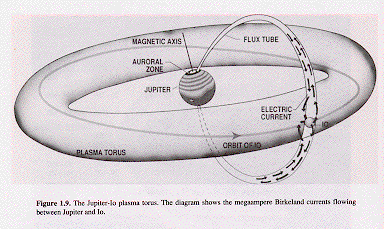
The scale may also extend down to Asteroidal. According to a 17 September 1994 article by Jeff Hecht in the New Scientist: "... inclusions ... in chondrules ... in chondrites, the commonest meteorites ...[were]... heated ... to about 2000 kelvin at the birth of the solar system, 4.6 billion years ago. ...[possibly by]... Lightning ... and ... magnetic discharges ... laser tests ... to model the intense visible and infrared light expected near electric or magnetic discharges ... produced dark structures ... remarkably similar to .... inclusions found in chondrules ...".
As can be seen from the image below (adapted from some of the above images and also An Introduction to Modern Astrophysics, by Carroll and Osterlie (Addison-Wesley 1996), Solar System Evolution, by Stuart Ross Taylor (Cambridge 1992), and B. V. Vasiliev's papers astro-ph/0002048 and astro-ph/0002171), Angular Momentum, Magnetic Dipole Moment, and Mass are systematically related or Stars and Stellar Systems and their components.
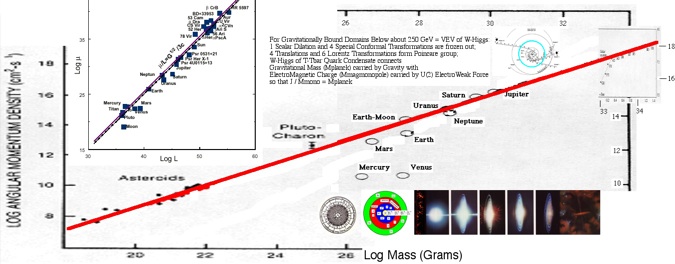
Angular Momentum J and Magnetic Dipole Moment P are related by a constant that is on the order of unity ( J = P ) (natural units) due to Gravity-Induced Electric Polarization of matter.
As to the relationship between Angular Momentum J and Mass (which, due to the Angular Momentum - Magnetic Dipole Moment relationship, implies a relationship between Magnetic Dipole Moment and Mass), Jack Sarfatti's paper wessonI.PDF describes a 1981 paper by Paul Wesson in which Wesson plotted total angular momentum J against mass M for the solar system, double stars, star clusters, spriral galaxies, the Coma cluster, and the local supercluster in which Wesson found that Angular Momentum J and Mass M are related by a constant p such that
Wesson's observations indicate approximately, that
For Elementary Specific Angular Momentum J/M = hbar, in natural units where hbar = 1 and the unit of mass is the Planck mass Mplanck:
which is roughly the mass of an SU(5) Magnetic Monopole.
Wesson's observations are consistent with a Compton Radius Vortes Kerr-Newman Black Hole related to the Wesson Force. The equation (in units with G = c = hbar = 1) for a Kerr-Newman Black Hole with coincident outer and inner event horizons and with Q = 1
meaning that the Black Hole Core has UNIT amplitude to absorb or emit a gauge boson, in accord with Feynman's statement in his book QED (Princeton 1988): "... e - the amplitude for a real electron to emit or absorb a real photon. It is a simple number that has been experimentally determined to be close to -0.0854... the inverse of its square: about 137.03... has been a mystery ... all good theoretical physicists put this number up on their wall ..."
is Q^2 + (J/M)^2 = 1 + (J/M)^2 = M^2. Dividing through by M^2, you get
For the Wesson force for which J = p_wesson M^2 with p_wesson = 1 / alpha_EM
so that 1 - (1/M)^2 = 137^2 and 1/M = sqrt(1 -137^2) = 137 i = 137 exp(pi/2)
Then the magnitude | 1 / Mwesson | = 137 which (since the units are natural units with G = c = hbar = 1) implies that
which is consistent with Wesson's observation that
The Linear Angular Momentum, Magnetic Dipole Moment, and Mass Relationships hold in Gravitationally Bound Domains, which are characterized by
Energy Below about 250 GeV = VEV of W-Boson Higgs where:
Although the Wesson angular momentum / mass relationship covers a very wide range of mass scales (at least from Asteroids to Stars and Stellar Systems), it is not Universal. Some other angular momentum / mass relationships are:
The differences may be that the Wesson relationship involves a combination of ElectroMagnetic and Gravity forces during Collapse/Formation, while, for the others, the forces involved are:
Saul-Paul Sirag, in his 3 November 2000 paper Vigier III: "Gravitational Magnetism: an Update", says:
"... The most straightforward test ... would be to measure directly the magnetic field of a rotating neutral body (which is not also a ferromagnetic substance). Blackett ... suggested that a 1-meter bronze sphere spun at 100 Hz would do nicely, except that this is the maximum safe speed, and there are severe problems in nulling out extraneous magnetic fields. With modern SQUIDs and mu-metal shielded rooms, such an experiment can be attempted. Exactly such an experimental design ... was described at the SQUID '85 conference in Berlin. However, the results of this experiment have not been published. ...".
The MicroScale Particle Physics proportionality between Q and M obviously does not extend far into the MacroScale, since Asteroids, Planets, and Stars do not have large net Electric Charges.
The Kerr-Newman Black Hole structure of a Compton Radius Vortex has the property that the square of the electric charge Q plays the same role as the square of J/M (specific angular momentum, or angular momentum over mass) in that their sum, relative to the square of the mass, determines whether the outer and inner event horizons are
Jack Sarfatti relates Compton Radius Vortex structure of Elementary Particles to the formula of Saul-Paul Sirag (based on earlier work of Blackett and Schuster, and perhaps Pauli) in his 1979 Nature paper Gravitational Magnetism (vol. 278 pp. 535-538, 5 April 1979), in which Saul-Paul Sirag says:
"The gravi-magnetic hypothesis proposes that a rotating mass, measured in gravitational units, has the same magnetic effect as that of a rotating charge, measured in electrical units. The respective force constants determine this relationshipG^(1/2) M = k^(1/2) Q where G is the gravitational constant, M is mass, k is the Coulomb constant, and Q is electric charge. ... Thus the ratio of magnetic moment P to angular momentum J for a sphere of mass M, density factor f, radius r, angular velocity w, and magnetic field B is (in SI units [with magnetic permeability muo of the vacuum]):
P / J = ( (5/4) 4 pi B / muo ) ( r / f w M ) = G^(1/2) / 2 k^(1/2) ... A priori, we should expect a correlation between P and J. ... The surprise is that this correlation ratio, P/J, should turn out to be close to P = ( G^(1/2) /2 k^(1/2) ) J. ... The gravi-magnetic hypothesis (stated in [ Log = log_10] form) predicts a P/J of -10.37. The mean P/J of the data points plotted in Fig. 1 is -11.13 with a standard deviation of 0.42. ... Therefore, for a given value of the angular momentum J, the gravi-magnetic hypothesis overstates the magnetic dipole moment P by a factor of 10^(-10.37 - (-11.13)) = 10^0.76 = 5.75. Saul-Paul Sirag says: "... the deviation from the gravi-magnetic hypothesis line is fairly systematic. ... deviations ... may well be due to electrical-magnetic effects. ... [ P / J = G^(1/2) / 2 k^(1/2) ] predicts a surface field about three times greater than that measured at the surface of the Earth. ... the Earth is not a uniformly dense sphere ... At the Earth's surface ... [ ( (5/4) 4 pi B / muo ) ( r / f w M ) = G^(1/2) / 2 k^(1/2) ] predicts a B of 2.1 x 10^(-4) T. That is not, however, a great deal more than the 1.4 x 10^(-4) T that [the equation] predicts for the surface of the Earth's core. ... this core magnetism predicted by the gravi-magnetic equation is greater than the magnetic field of 6 x 10^(-5) T measured at the Earth's surface. ... This is what we expect if we suppose that gravitational magnetism is modified by an electrical-magnetic effect stronger at the Earth's surface than in the interior. ...".
B. G. Sidharth, in physics/9908004, says:
"... We first observe that as is known an assembly of Fermions below the Fermi temperature occupies each and every single particle level, and this explains the fact that it behaves like a distribution of Bosonic phonons: The Fermions do not enjoy their normal degrees of freedom. ... [there is a] Bosonization or semionic effect. ... Let us now consider an assembly of N electrons. As is known, if N+ is the average number of particles with spin up, the magnetisation per unit volume is given byM = mu ( 2 N+ - N ) / V where mu is the electron magnetic moment. At low temperatures, in the usual theory, N+ = N / 2, so that the magnetisation ... is very small.
On the other hand, for Bose-Einstein statistics we would have, N+ = N. With the above semionic statistics we have,
N+ = b N, 1/2 < b < 1, If N is very large, this makes an enormous difference ... Let us use ... the case of Neutron stars. In this case, as is well known, we have an assembly of degenerate electrons at temperatures about 10^7 K, whereas the Fermi temperature is about 10^11 K ... So the above considerations apply. In the case of a Neutron star we know that the number density of the degenerate electrons, n = 10^31 per c.c. So ... remembering that mu = 10^(-20) G (Gauss), the magnetic field near the Pulsar is about 10^11 G < 10^8 Tesla, as required. Some White Dwarfs also have magnetic fields. If the White Dwarf has an interior of the dimensions of a Neutron star, with a similar magnetic field, then remembering that the radius of a White Dwarf is about 10^3 times that of a Neutron star, its magnetic field would be 10^(-6) times that of the neutron star, which is known to be the case. It is quite remarkable that the above mechanism can also explain the magnetism of the earth. As is known the earth has a solid core of radius of about 1200 kilometers and temperature about 6000 K. This core is made up almost entirely of Iron (90%) and Nickel (10%). It can easily be calculated that the number of particles N = 10^48 , and that the Fermi temperature is about 10^5 K. In this case we can easily verify ... that the magnetic field near the earth's surface is about 1 G, which is indeed the case. It may be mentioned that the anomalous Bosonic behaviour ... would imply a sensitivity to external magnetic influences which could lead to effects like magnetic flips or reversals. ... Remembering that the core density of Jupiter is of the same order as that of the earth, while the core volume is about 10^4 times that of the earth, we have in this case, N = 10^52 , so that the magnetization ... is about 10^4 times the earth's magnetism, as required. ....".
According to a 23 March 2006 ESA news web page:
"... Martin Tajmar, ARC Seibersdorf Research GmbH, Austria; Clovis de Matos, ESA-HQ, Paris; and colleagues have measured ... a gravitomagnetic field ... generate[d] ...[by]... a moving mass ... Their experiment involves a ring of superconducting material rotating up to 6 500 times a minute. Superconductors are special materials that lose all electrical resistance at a certain temperature. Spinning superconductors produce a weak magnetic field, the so-called London moment. The new experiment tests a conjecture by Tajmar and de Matos that explains the difference between high-precision mass measurements of Cooper-pairs (the current carriers in superconductors) and their prediction via quantum theory. They have discovered that this anomaly could be explained by the appearance of a gravitomagnetic field in the spinning superconductor (This effect has been named the Gravitomagnetic London Moment by analogy with its magnetic counterpart). ... Although just 100 millionths of the acceleration due to the Earth's gravitational field, ...[ gr-qc/0603033 says "... the peaks ... "only" 100 micro g ... are 30 orders of magnitude higher than what general relativity predicts classically ..."]... The electromagnetic properties of superconductors are explained in quantum theory by assuming that force-carrying particles, known as photons, gain mass. By allowing force-carrying gravitational particles, known as the gravitons, to become heavier, they found that the unexpectedly large gravitomagnetic force could be modelled. ... The papers can be accessed on-line at the Los Alamos pre-print server using the references: gr-qc/0603033 and gr-qc/0603032. ...".

On Guy Fawkes Day, 5 November 2007, the day before Garrett Lisi posted 0711.0770, the Astronomy Picture of the Day was the above image, and the antwrp.gsfc.nasa.gov web site said:
"... Comet Holmes continues to be an impressive sight to the unaided eye. The comet has diminished in brightness only slightly, and now clearly appears to have a larger angular extent than stars and planets. Astrophotographers have also noted a distinctly green appearance to the comet's coma over the past week. Pictured above [ by Vicent Peris and Jose Luis Lamadrid ] over Spain in three digitally combined exposures, Comet 17P/Holmes now clearly sports a tail. The blue ion tail is created by the solar wind impacting ions in the coma of Comet Holmes and pushing them away from the Sun. Comet Holmes underwent an unexpected and dramatic increase in brightness starting only two weeks ago. The detail visible in Comet Holmes' tail indicates that the explosion of dust and gas that created this dramatic brightness increase is in an ongoing and complex event. ...".
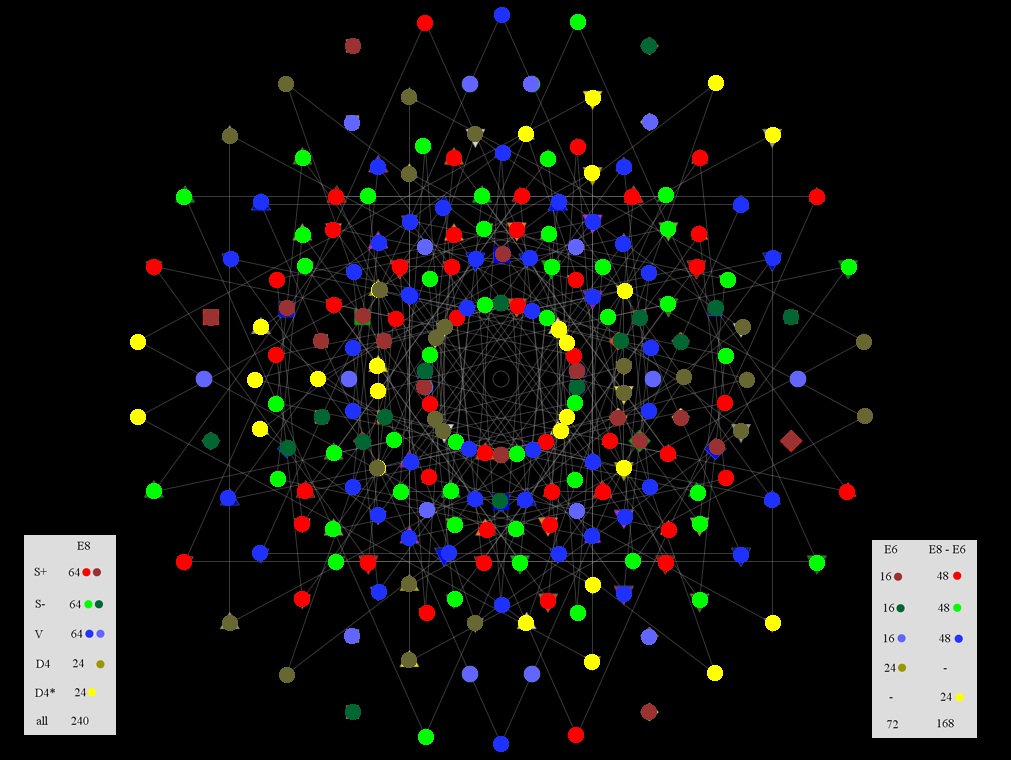
The 240 root vectors of my E8 physics model can also be projected as in this image made using a root vector rotation web applet by Carl Brannen
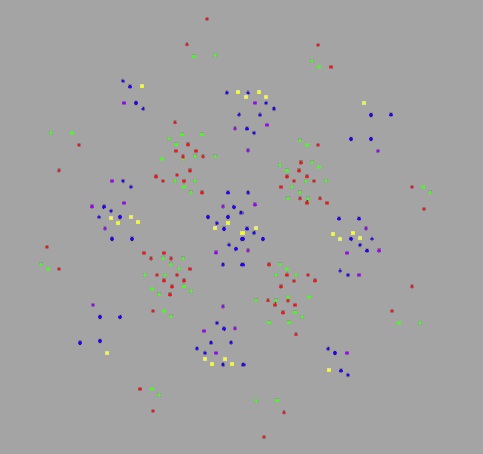
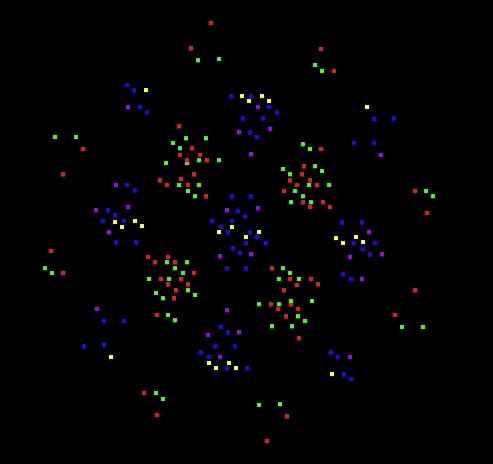
Note that the points are grouped (roughly from left to right) in red-green sets (RG) and blue-purple-yellow sets (BPY) as
that, if you add 8 Cartan elements of E8 to the central 56 blue-purple-green, you get a representation of a 7-grading of E8 described by Tomas Larsson when he said in a post to the spr thread Re: Structures preserved by e_8 : "... e_8 also seems to admit a 7-grading,
e_8 = 8 + 28* + 56 + (sl(8) + 1) + 56* + 28 + 8*. ...".
[ Note that g_0 = 8+56 = 64 = U(8) is in Spin(16) = U(8) plus D4 plus D4 ]
which 7-grading shows the fermionic (odd grade) nature of the RG points and the bosonic (even grade) nature of the BPY points.
In the image, the 24 yellow points correspond to the 24 root vectors of D4 which is used to construct Gravity by a generalized MacDowell-Mansouri mechanism based on the 15-dimensional D3 = A3 Conformal Group Spin(2,4) = SU(2,2). To help get started with visualization, here are the 24 yellow points
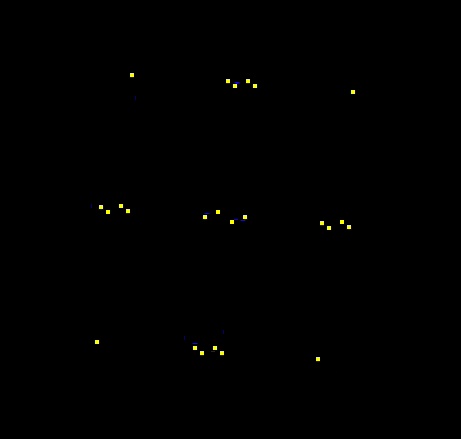
in the image. Note that the 24 yellow points form three sets:
Note also that a 24-cell can be seen as being made up of a cuboctahedron and two octahedra as in this stereo image:
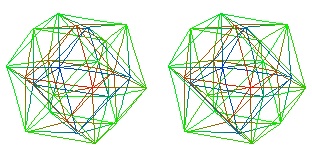
in which the cuboctahdron is green and the two octahedra are red and blue. So
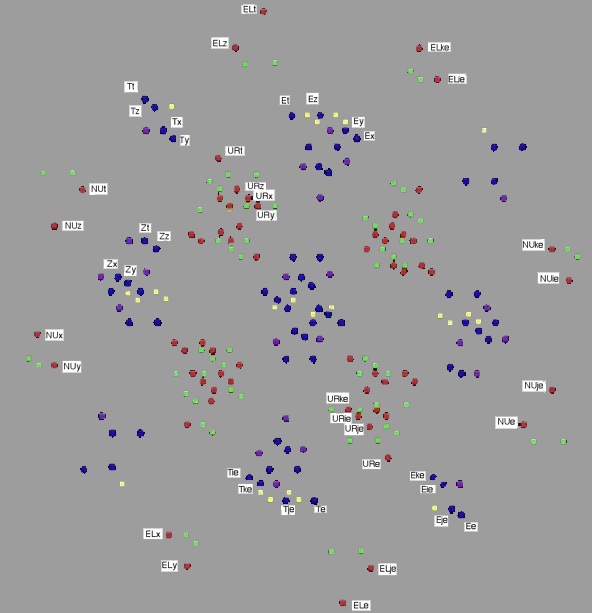
In my E8 physics model, 64 of the 240 E8 root vectors (blue in the image above) are represented by 64 = 8x8 = 8 dimensions of full 8-dim spacetime x 8 Dirac Gammmas
The 8 Dirac components of the 8 spacetime vector dimensions (such as Xk etc ) physically describe effective spacetime curvature in full 8-dimensional (high-energy) spacetime analogous to gravitational curvature in 4-dimensional (low-energy) physical spacetime.
A second set of 64 of the 240 E8 root vectors (red in the image above) are represented by 64 = 8x8 = 8 half-spinor fundamental first-generation fermion particles x 8 Dirac Gammmas or, equivlalently, the 8 covariant components of the 8 fundamental first-generation fermion particles.The 8 fundamental first-generation fermion particles are denoted here by
Therefore, the 8x8 = 64 covariant components of the fundamental first-generation fermion particles are:
ELt ELx ELy ELz ELe ELie ELje ELke URt URx URy URz URe URie URje URke UGt UGx UGy UGz UGe UGie UGje UGke UBt UBx UBy UBz UBe UBie UBje UBke DRt DRx DRy DRz DRe DRie DRje DRke DGt DGx DGy DGz DGe DGie DGje DGke DBt DBx DBy DBz DBe DBie DBje DBke NUt NUx NUy NUz NUe NUie NUje NUke
A third set of 64 of the 240 E8 root vectors (green in the image above) are represented by 64 = 8x8 = 8 half-spinor fundamental first-generation fermion anti-particles x 8 Dirac Gammmas that can be represented by notation similar to that of the second set of 64 (red in the image above).
The 3 sets of 64 of the 240 E8 root vectors (blue, red, and green in the image above) are related by triality. To try to reduce confusing clutter, only some of the blue (8-dim spacetime) and red (fundamental first-gemeration fermion particle) root vector vertices are explictly labelled. I hope that enough labelling has been done to clearly indicate how the remaining blue, red, and green vertices should be labelled.
As to the 24 yellow and 24 purple vertices, they represent the root vectors of two copies of D4 (one D4 for Gravity and another D4 for the Standard Model) that live within the Spin(16) inside E8, with structure
Spin(16) / D4xD4 = 64
The spinor fermion term of the full 8-dimensional Lagrangian of my E8 physics model is of the form
INTEGRAL over {t,x,y,z,e,ie,je,ke} of SPINOR {ELt ,ELx ,ELy ,ELz ,ELe ,ELie ,ELje ,ELke} ...(other fermions)
After dimensional reduction according to the Mayer Mechanism from a uniform octonionic 8-dimensional spacetime with basis
{t,x,y,z,e,ie,je,ke}
down to a quaternionic 4+4 = 8-dimensional Klauza-Klein spacetime with basis
{t,x,y,z} of physical spacetime plus {e,ie,je,ke} of internal symmetry space
the spinor term of the Lagrangian breaks down into the sum of four parts
1 - INTEGRAL over {t,x,y,z} of SPINOR {ELt ,ELx ,ELy ,ELz} ...(other fermions)
2 - INTEGRAL over {t,x,y,z} of SPINOR {ELe ,ELie ,ELje ,ELke} ...(other fermions)
3 - INTEGRAL over {e,ie,je,ke} of SPINOR {ELt ,ELx ,ELy ,ELz } ...(other fermions)
4 - INTEGRAL over {e,ie,je,ke} of SPINOR {ELe ,ELie ,ELje ,ELke} ...(other fermions)
1 - is just the usual Standard Model spinor fermion term for 4-dim physical spacetime and first-generation fermions, so 1 represents first-generation fermions. The 8 first-generation fermion particles and antiparticles each correspond to the 8 octonion basis elements, so that the first-generation ferrmion particles and the first-generation fermion antiparticles each correspond to the Octonions O.
2 - differs from the usual Standard Model in that the SPINOR has components in the {e,ie,je,ke} internal symmetry space instead of in the {t,x,y,z} physical spacetime. Transformation from the SPINOR with components in the {e,ie,je,ke} internal symmetry space to a SPINOR with components in the {t,x,y,z} physical spacetime introduces a 4x4 matrix
t x y z e * * * * ie * * * * je * * * * ke * * * *
Introduction of those new 4x4 = 16 degrees of freedom of that Transformation corresponds to introducing a new octonion corresponding to a second copy of the 8 fundamental fermion particles and a new octonion corresponding to a second copy of the 8 fundamental fermion antiparticles, so that the second-generation fermion particles and the second-generation fermion antiparticles each correspond to pairs of Octonions OxO.
3 - differs from the usual Standard Model in that the base manifold spacetime has components in the {e,ie,je,ke} internal symmetry space instead of in the {t,x,y,z} physical spacetime. Transformation from the base manifold spacetime with components in the {e,ie,je,ke} internal symmetry space to a base manifold spacetime with components in the {t,x,y,z} physical spacetime introduces a 4x4 matrix as described in 2. Introduction of those new 4x4 = 16 degrees of freedom of that Transformation corresponds to introducing a new octonion corresponding to a second copy of the 8 fundamental fermion particles and a new octonion corresponding to a second copy of the 8 fundamental fermion antiparticles, so that the second-generation fermion particles and the second-generation fermion antiparticles each correspond to pairs of Octonions OxO.
4 - differs from the usual Standard Model in that the SPINOR has components in the {e,ie,je,ke} internal symmetry space instead of in the {t,x,y,z} physical spacetime AND the base manifold spacetime has components in the {e,ie,je,ke} internal symmetry space instead of in the {t,x,y,z} physical spacetime. Transformation from the SPINOR with components in the {e,ie,je,ke} internal symmetry space to a SPINOR with components in the {t,x,y,z} physical spacetime introduces a 4x4 matrix
t x y z e * * * * ie * * * * je * * * * ke * * * *
Introduction of those new 4x4 = 16 degrees of freedom of that Transformation corresponds to introducing a new octonion corresponding to a second copy of the 8 fundamental fermion particles and a new octonion corresponding to a second copy of the 8 fundamental fermion antiparticles.
Transformation from the base manifold spacetime with components in the {e,ie,je,ke} internal symmetry space to a base manifold spacetime with components in the {t,x,y,z} physical spacetime introduces a second 4x4 matrix
t x y z e * * * * ie * * * * je * * * * ke * * * *
Introduction of the second new 4x4 = 16 degrees of freedom of that Transformation corresponds to introducing a second new octonion corresponding to a second copy of the 8 fundamental fermion particles and a second new octonion corresponding to a second copy of the 8 fundamental fermion antiparticles, so that the third-generation fermion particles and the third-generation fermion antiparticles each correspond to triples of Octonions OxOxO.
Type EVIII rank 8 Symmetric Space Rosenfeld's Elliptic Projective Plane (OxO)P2
Type BDI(8,8) rank 8 Symmetric Space real 8-Grassmannian manifold of R16 or set of the RP7 in RP15
Due to the special isomorphisms Spin(6) = SU(4) and Spin(2) = U(1) and the topological equality RP1 = S1

Note that in the above image some of the 240 E8(8) vertices are projected to the same point:
In the above, the black underlined 4+4 = 8 correspond to the 8 E8 Cartan subalgebra elements that are not represented by root vectors, and the black non-underlined 1+3+3+1 = 8 correspond to the 8 elements of 256-dim Cl(8) that do not directly correspond elements of 248-dim E8.
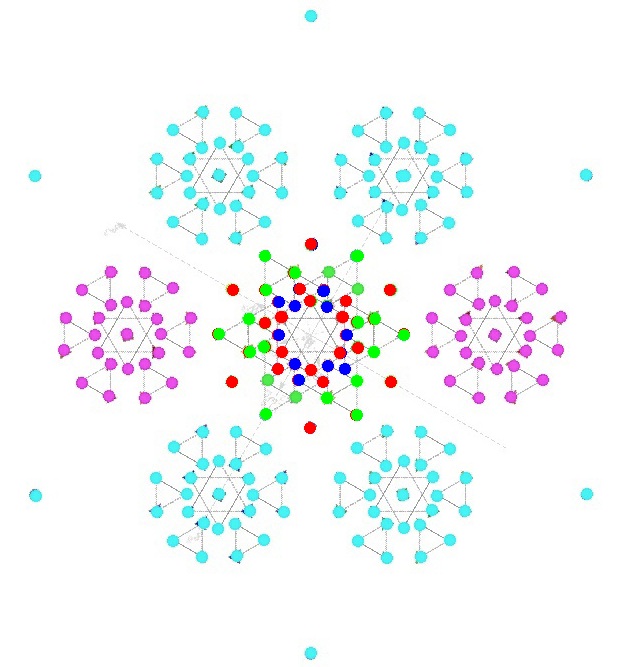
Note that in the above image some of the 240 E8 vertices are projected to the same point:
Since an important aspect of both the E8 model and the Cl(8) model is the representation of fermions by spinor-type structures,
such as by 8-dimensional Spin(8) +half-spinors and 8-dimensional Spin(8) -half-spinors in the Cl(8) model
and by 128-dimensional Spin(16) half-spinors in the E8 model (based on the identification of 248-dimensional E8 as the sum of the 120-dimensional Spin(16) adjoint plus a 128-dimensional Spin(16) half-spinor space)
it is useful to see how spinor-type structures appear in the above-described structure of E8 by enclosing theire enumeration in [ brackets ]:
Note that each of the [16] above live in the 27-dimensional exceptional Jordan algebra J3(O), which is the algebra of 3x3 Hermitian Octonion matrices
E8 Root Vector Projections - Frank Dodd (Tony) Smith, Jr. - 2008
The basis of my E8 physics model, which is based on Garrett Lisi's E8 physics model, is the figure
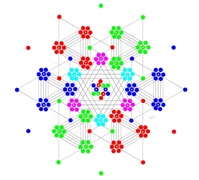
in which the two D4 inside E8 are shown in cyan and magenta.
Another figure I use, based on another projection of E8 root vectors into 2 dimensions, shows a nesting
D4 in D5 in E6 in E7 in E8
in which the two D4 of E8 are ( showing multiplicities 3 and 2 of points to which multiple root vectors are projected )
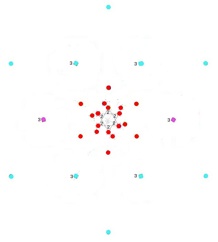
The outer magenta 6 of the outer D4 in E7 outside E6 are the two central 3 of:
126 root vectors of E7 - 72 root vectors of E6 = 54 = 2x(24+3) =
2 circular 12+12 + 2 central 3
The magenta 6 root vectors of the two central 3 correspond to the root vectors of a 7-sphere S7 ( which, although not a Lie algebra due to Octonion non-associativity, is a Malcev algebra )
The magenta 48 = 54-6 of the two E7 circular 12+12 are related to the blue 16 of 8-complex-dimensional Kaluza-Klein vector spacetime D5 outside red D4 so that the magenta 48 and blue 16 combine to form a 48+16 = 64-real-dimensional = 8-octonionic-dimensional vector spacetime .
Therefore, E7 looks like E6 plus octonification of vector spacetime plus a 7-sphere S7.
The outer cyan 18 of the outer D4 in E8 outside E7 are the four central 3 plus outside 6 of:
240 root vectors of E8 - 126 root vectors of E7 = 114 = 108 + 6 = 4x(24+3) + 6 =
4 circular 12+12 + 4 central 3 + outside 6
The cyan 12 root vectors of the four central 3 correspond to the root vectors of the 14-dimensional Lie algebra G2.
The outside 6 root vectors correspond to the root vectors of a 7-sphere S7 ( which, although not a Lie algebra due to Octonion non-associativity, is a Malcev algebra )
The cyan 96 = 108-12 of the four E8 circular 12+12 are related to the green 32 of 16-complex-dimensional full-spinor E6 fermion first-generation particles and antiparticles so that the cyan 96 and green 32 combine to form 96+32 = 128-real-dimensional = 16-octonionic-dimensional representation space for full-spinor fermion first-generation particles and antiparticles.
Therefore, E8 looks like E7 plus octonification of representation space for full-spinor fermion first-generation particles and antiparticles plus G2 plus a 7-sphere S7.
The outer magenta-cyan 24

look like the outer red-green-blue 24
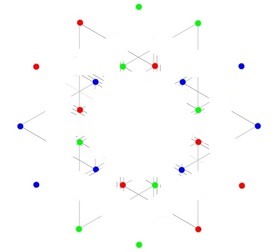
in my basic E8 physics model figure

in which the second D4 is represented by its magenta 24
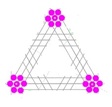
so the physics interpretations of the two projections are related by interchanging, in the basic figure,
its outer red-green-blue 24 and its magenta 24.
The basic figure, so interchanged, and with cyan changed to bright yellow and magenta changed to dark yellow. looks like
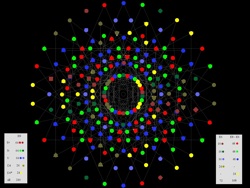
from the view of the 240 of E8 as 8 circles of 30.
To get more feel for the 8 circles of 30, consider the comment by rntsai on N-category Cafe that mentioned Kostant's "... decomposition of e8 into 31 cartan's ..." and said: "... It's ... related to e8/(d4+d4) decomposition :
The last 3 terms can be seen as 24 8-dim spaces ...
The other 7 cartans are inside d4+d4 ... there are probably several ways to identify [them]...".
Another way (other than the one mentioned by rntsai) is to decompose d4 into a 14-dim G2 plus two 7 spheres S7 + S7, getting
14-dim rank-2 G2 has 7 = 14/2 Cartans and G2 can be seen as the sum of two 7-dimensional representations. If each 7 is represented by the 7 imaginary octonions { i,j,k,e,ie,je,ke } then the 7 Cartans of G2 are the 7 pairs (one from each of the 7 in G2):
j j
k k
e e
ie ie
je je
ke ke
Note that to make an Abelian Cartan, the pairs must match, because only matching pairs close to form an Abelian Cartan (this can be seen by looking at the octonion products).
28-dim rank-4 d4 has 28/4 = 7 Cartans and d4 looks like G2 plus S7 plus S7 and since G2 decomposes into two 7 representations
d4 decomposes into 7 + 7 + 7 + 7 ( where the first two 7 are from G2 and the other two come from the two S7 )
and the 7 Cartans of d4 are ( in terms of octonion imaginaries )
j j j j
k k k k
e e e e
ie ie ie ie
je je je je
ke ke ke ke
Again, note that all elements of the quadruples must match to get Abelian Cartan structure.
When you look at d4 + d4 to get 8-element Cartans of E8, all 8 elements must again match up to get Abelian Cartan structure, so the 7 Cartans of E8 that come from d4 + d4 look like
j j j j j j j j
k k k k k k k k
e e e e e e e e
ie ie ie ie ie ie ie ie
je je je je je je je je
ke ke ke ke ke ke ke ke
Of course, this octonion structure is also reflected in the "... 24 8-dim spaces ..." described by rntsai as "... (8v,8v) + (8S+,8S+) + (8S-,8S-) ..." so that all 31 of the 8-dim Cartans of E8 have nice octonionic structure.
Also note that when you make a 240-element E8 root vector diagram of 8 circles each with 30 vertices, 8 of the 248 E8 generators are missing, so that you must leave out one of the 31 Cartan 8-element sets. Seeing E8 in terms of E8 = 120 + 128 = d4 + d4 + 8x8 + 8x8 + 8x8 it is most natural to see the Cartan as being one of the Cartan sets of 8 coming from the d4 + d4, but you could see the E8 from other points of view by using other Cartan sets of 8 to determine which of the 248 were the 8 omitted from the root vector diagram.
rntsai also said, about "The last 3 terms [that] can be seen as 24 8-dim spaces", "... You can verify that these are abelian, so calling them cartan is justified. ...". Each of the 8x8 look like
g1 g2 g3 g4 g5 g6 g7 g8 1 i j k e ie je ke
where the E8/octonionic { 1,i,j,k,e,ie,je,ke } represent 8-dim spacetime (8v) or 8 fermion fundamental first-generation particles (8S+) or 8 fermion fundamental first-generation antiparticles (8S-) and the g1 ... g8 are Dirac gammas of 8-dimensional Kaluza-Klein spacetime.
Those Dirac gammas, although they have intrinsic Clifford algebra structure, can be regarded with respect to E8/octonionic structure as only indicating physical Dirac gamma component structure of the E8/octonionic { 1,i,j,k,e,ie,je,ke } so that they are consistent with each of the rows
1g1 1g2 1g3 1g4 1g5 1g6 1g7 1g8 ig1 ig2 ig3 ig4 ig5 ig6 ig7 ig8 jg1 jg2 jg3 jg4 jg5 jg6 jg7 jg8 kg1 kg2 kg3 kg4 kg5 kg6 kg7 kg8 eg1 eg2 eg3 eg4 eg5 eg6 eg7 eg8 ieg1 ieg2 ieg3 ieg4 ieg5 ieg6 ieg7 ieg8 jeg1 jeg2 jeg3 jeg4 jeg5 jeg6 jeg7 jeg8 keg1 keg2 keg3 keg4 keg5 keg6 keg7 keg8
being able to represent an 8-element E8 Cartan subalgebra, no matter which of the three representations 8v, 8S+, or 8S- (which are related to each other by triality) is used.
Consider the two D4 in the E8 physics model based on E8 / Spin(16) that I like to use, and denote them D4 and D4* to distinguish between them.
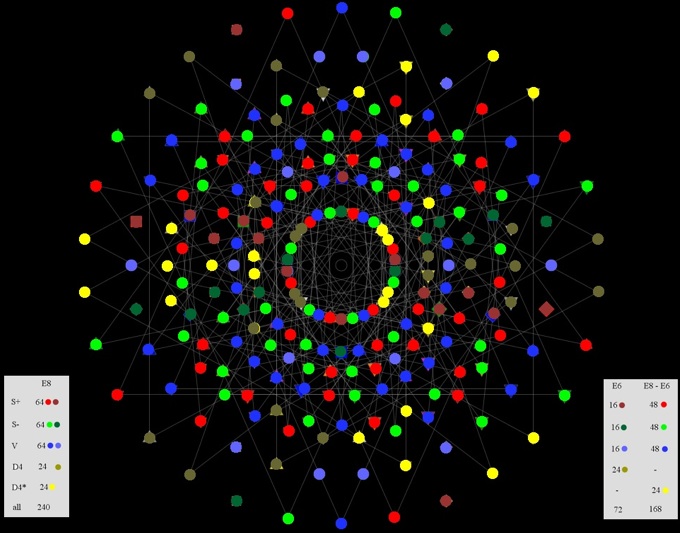
When transformed from the 8-circle projection to the basic projection of my E8 physics model, D4 and D4* look like
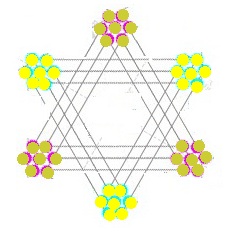
The basic figure of my E8 physics model

has, for the D4 and D4*, cyan intead of bright yellow and magenta instead of dark yellow, so that in the basic figure the D4 and D4* look like
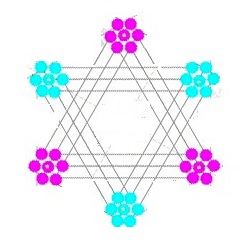
28-dim D4 ( with 24 root vectors ) gives Gravity from its 15+1 = 16-dimensional D3xU(1).
The 12-dimensional symmetric space D4 / D3xU(1) corresponds to the Lie spheres in R8.
28-dim D4* ( with 24 root vectors ) gives the Standard Model SU(3) and SU(2) and U(1) from its 15+1 = 16-dimensional A3xU(1) = U(4).
The 12-dimensional symmetric space D4* / U(4) corresponds to the set of complex structures in R8.
Since D3 = A3 and D3xU(1) = U(4), the Lie spheres in R8 looks like the set of complex structures in R8, so from when I refer to the "set of complex structures in R8" I am referring to both of those things.
Since D4 describes Gravity acting on 4-dimensional M4 physical spacetime, the 12-dimensional set of complex structures in R8 of the D4 symmetric space correspond to the ways that M4 can be fit inside the prior-to-dimensional-reduction 8-dimensional spacetime.
Since D4* describes the Standard Model SU(3) and SU(2) and U(1) acting on 4-dimensional CP2 , the 12-dimensional set of complex structures in R8 of the D4* symmetric space correspond to the ways that CP2 can be fit inside the prior-to-dimensional-reduction 8-dimensional spacetime.
After dimensional reduction, the uniform R8 is transfomed into a 4+4-dimensional M4xCP2 Kaluza-Klein space,
and consistency with the structure of the M4xCP2 Kaluza-Klein space is a restriction on the 12+12 = 24 degrees of freedom of the D4 and D4* symmetric spaces.
and the geometry of that dimensional reduction gives, by the Mayer Mechanism, the Higgs scalar, which is 2-complex dimensional or 4-real dimensional ( see, for example, Introduction to Gauge Field Theory, by Bailin and Love (rev ed IOP 1993 at pages 235, 238)).
Since the 12+12 = 24 degrees of freedom of the D4 and D4* symmetric spaces produce the 4 degrees of freedom of the Higgs scalar,
the remaining 24-4 = 20 degrees of freedom do not correspond to physics in our M4xCP2 low-energy Kaluza-Klein realm,
but to phenomena in the high-energy realm of prior-to-dimensional-reduction 8-dimensional spacetime.
Having seen how the Higgs etc comes from the 28-16 = 12-real-dimensional symmetric spaces Spin(8) / U(4) of D4 and D4*
consider the physical interpretation of the 16-real-dimensional U(4) subgroup of Spin(8) in D4* that produces the Standard Model.
12 of the dimensions describe the Standard Model gauge groups SU(3) and SU(2) and U(1)
As to the remaining 16-12 = 4 dimensions,
1 of them is the U(1) of U(4) = U(1)xSU(4) that describes a complex propagator phase, which must be corrrelated/coincidental with the U(1) of the U(2,2) in the Spin(8) of D4 that produces Gravity for consistency of the E8 physics model after dimensional reduction
1 more of them is accounted for by requiring the U(1) of U(3) and the U(1) of U(2) to be correlated/coincidental, producing the U(1) photon. (Note that in the E6 physics model with only one D4, the 12 Standard Model generators are the 28-16 = 12 of Spin(8) / U(2,2), so there is only one U(1) photon.)
The other 2 are in CP3 beyond CP2 ( where CP3 = SU(4) / U(3) and CP2 = SU(3) / U(2) ) and they describe the Quantum Worlds of the Many-Worlds, much like "the "tunnel effect" of quantum mechanics in terms of classical evolution of a system in imaginary time" to use the words of Yu. Manin in his 1981 book "Mathematics and Physics", where he said:
"... It is extremely important to ... imagine the whole history of the Universe ... as a complete four-dimensional shape, something like the "tao" of ancient Chinese philosophy. The introduction of temporal dynamics is the next step. ... the natural structure for the absolute sky ... at the point P0 ... is the complex Riemann sphere ... the complex projective line CP1 ... the natural coordinates are complex numbers ... they are always connected by a fractional-linear transformation ... each sky CP1 is simply embedded in ... The "Penrose paradise" H = CP3 ... the space of "projective twistors" ... the skies over the points of the Minkowski World are not all the lines in CP3, but only part of them, lying in a five-imensional hypersurface ... introduc[ing] additional ... skies correspond[ing] to the missing lines in CP3 ...[gives]... the compact complex spacetime of Penrose, denoted CM ... [with] the interpretation of the "tunnel effect" of quantum mechanics in terms of the classical evolution of a system in imaginary time ...In a world of light there are neither points nor moments of time; beings woven from light would live "nowhere" and "nowhen" ... One point of CP3 is the whole life history of a free photon - the smallest "event" that can happen to light. ...".
Note that in the below images some of the 240 E8(8) vertices are projected to the same point, so that when counting root vectors keep in mind:
The right figure in the image below shows the 240 root vectors of 248-dimensional E8:
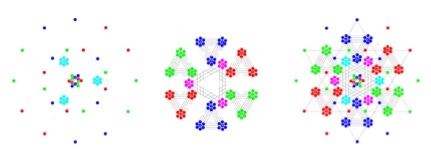
The left figure in the image above shows the 72 root vectors of 78-dimensional E6 which is made up of:
Given a basis {1,i} of the complex numbers, the 3 sets of 8+8 in E6 can each be regarded as representing 8 complex elements of the form
so that the representation spaces of 8-dimensional Kaluza-Klein spacetime and the 8 fundamental first-generation fermion particles and the 8 fundamental first-generation fermion antiparticles can be seen as complex as is useful for calculation of particle masses and force strength constants using an approach motivated by that of Armand Wyler.
So, to expand to E8, each of the S7 must be Octonified. This is done by introducing an octonion product among the points of each S7. Unlike S3 with a quaternion product that closes to form a Lie group, S7 under an octonion product does not close, but expands to form a 28-dimensional Spin(8) that can be seen as an S7, another S7, and a 14-dimensional G2. Since each of the two S7 expands to a Spin(8):
Expanding E6 to E8 goes from the one D4 in E6 to 2 D4 in E8. The 24 root vectors of the second D4 are the 24 magenta root vectors in the central figure of the above image.
To Octonify them they must be expanded from complex with basis {1,e} to octonion with basis {1,i,j,k,e,ie,je,ke}
by adding 6 more root vectors ( {i,j,k} added corresponding to {1} and {ie,je,ke} added corresponding to {e} ) such that the each of the 3 sets of 8+8 = 16 can, when expanded to E8, each be regarded a representing 8+8+8+8+8+8+8+8 = 64 octonionic elements of the form
by adding 6 new sets of 8 root vectors for each of the vector blue, +half-spinor red, and -half-spinor green as shown in the central figure of the above image, for a total of 3 x 6x8 = 3x48 = 6 x 24 =144 of the root vectors in the central figure of the above image.
Those three images are shown on larger scale in the three images immediately below:
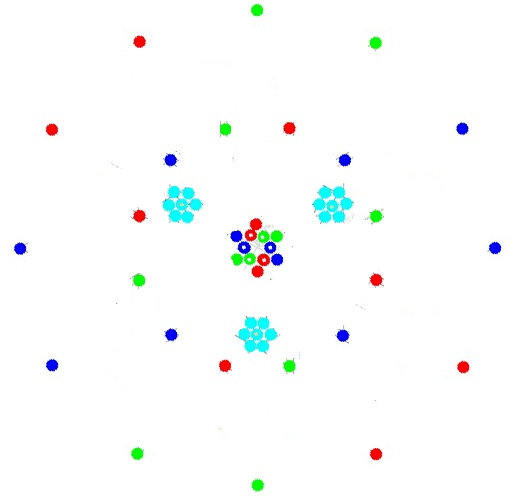
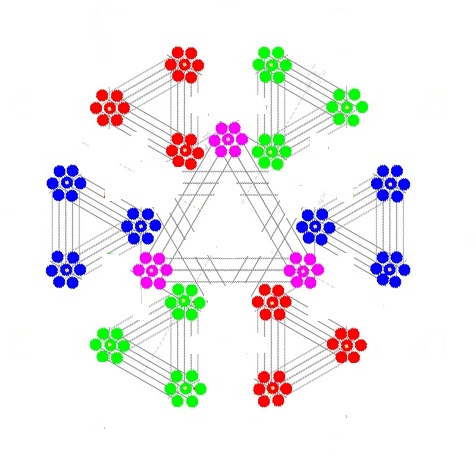

According to Bulletin (New Series) of the American Mathematical Society, Volume 36, Number 1, January 1999, Pages 75-93
by Robert L. Griess Jr. AND A. J. E. Ryba:
"... The finite subgroups of the smallest simple algebraic group PSL(2;C) (up to conjugacy) constitute the famous list: cyclic, dihedral, Alt4, Sym4, Alt5. This list has been associated to geometry, number theory, and Lie theory in several ways. McKay's correspondence between these groups and the Cartan matrices of types A, D and E and his related tensor product observations are provocative. For the exceptional algebraic groups, theories of Kostant, Springer and Serre have called attention to particular finite simple subgroups. A good list of finite subgroups should help us understand the exceptional groups better. ...
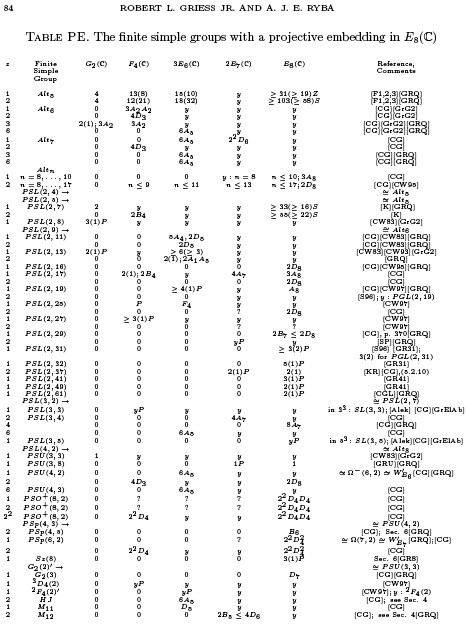 ...".
...".
According to a 2006 paper in the Journal of Mathematical Chemistry entitled
by Erwin Lijnen, Arnout Ceulemans, Patrick W. Fowler,and Michel Deza:
"... the special linear group SL(2,p) ... has order p (p^2 - 1) . The group PSL(2,p) is defined as the quotient group of SL(2,p) modulo its centre ... For all prime numbers p at least 5, the centre has only two elements and the corresponding quotient group PSL(2,p) is simple. Of all these prime numbers p however, the numbers p = 5, 7, 11 stand out as they are the only cases in which the group PSL(2,p) acts transitively on sets of p as well as on sets of p +1 elements, a result already known to Galois.For all other prime values of p the group PSL(2,p) acts transitively on sets of p + 1 elements, but not on sets of p elements ...
Three projective special linear groups PSL(2,p), those with p = 5, 7 and 11, can be seen as p-multiples of tetrahedral, octahedral and icosahedral rotational point groups, respectively.
The first two have already found applications in carbon chemistry and physics,
PSL(2,5) ... is the rotation group of the fullerene C60 and dodecahedrane C20H20 ... PSL(2,5) has 60 elements and is isomorphic to the pure icosahedral rotation group I . It is alternatively called the pentakistetrahedral group 5T as it contains the tetrahedral group as a subgroup of index 5 . This can easily be seen on a regular dodecahedron where the 20 vertices can be divided into five sets of four vertices such that each set of four vertices forms a regular tetrahedron .... The group PSL(2,5) acts transitively on this set of five tetrahedra by the action of one of the fivefold rotations. The group acts also transitively on a six element set as can be seen from the action on the six diagonals of the regular icosahedron connecting opposite points. ... The smallest 3-regular map with rotational symmetry PSL(2,5) (i.e., 5T or I ) is the all-pentagon dodecahedral map ...
PSL(2,7) is the rotation group of the 56-vertex all-heptagon Klein map, an idealisation of the hypothetical genus-3 "plumber's nightmare" allotrope of carbon. ... PSL(2,7) of order 168, which is alternatively called the heptakisoctahedral group 7O as it contains the octahedral group O as a subgroup of index 7. The group can be represented by the regular genus-3 Klein map, named after Felix Klein who investigated its very high symmetry in connection with the theory of multivalued functions ... Using this map it is easy to show the transitive character on a 7-set, as under removal of the sevenfold symmetry elements, the 56 vertices split into seven octahedral structures containing eight vertices. The complete structure of this group and its relevance to some negative-curvature carbon structures was described in previous papers ... the smallest ... 3-regular map ... with the rotational symmetry PSL(2,7) (i.e., 7O) is the all-heptagon Klein map ...
PSL(2,11) ... has potential relevance for the study of the icosahedral phase of quasicrystals, and was identified as a finite simple subgroup of the Cartan exceptional group E8 ... Here, we present an analysis of PSL(2,11) as the rotation group of a 220-vertex, all 11-gon, 3-regular map, which provides the basis for a more exotic hypothetical sp2 framework of genus 26. The group structure and character table of PSL(2,11) are developed in chemical notation and a three dimensional (3D) geometrical realisation of the 220-vertex map is derived in terms of a punctured polyhedron model where each of 12 pentagons of the truncated icosahedron is connected by a tunnel to an interior void and the 20 hexagons are connected tetrahedrally in sets of 4. ... to realise PSL(2,11) (i.e., 11 I ) by a 3-regular map it is necessary to go to an all-undecagon map which will have 220 vertices, v, and 330 edges, e and 60 faces, f . Hence, from f = v / 2 + 2( 1 - g ), we find a genus g of 26. ... the map of interest ...[has]... total automorphism group consists of 1,320 elements, of which the orientation-preserving (rotational) part of 660 elements corresponds with the group PSL(2,11). ... a geometrical representation for this genus-26 map has thus far not yet been reported. The most obvious representation would be to draw a Schlegel-like diagram consisting of a central 11-gon surrounded by layers of undecagonal faces, adding layers until all faces have been accounted for. ...
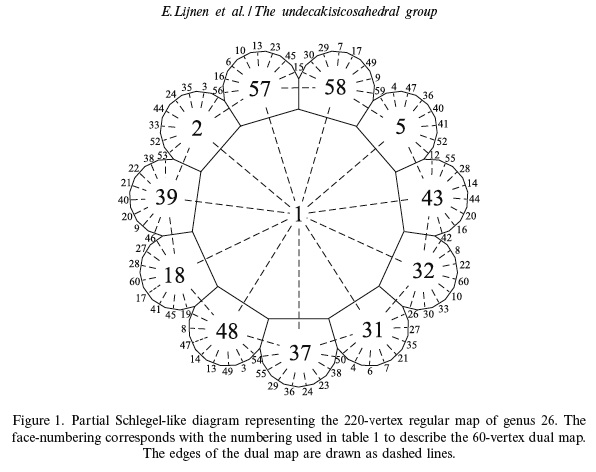
... Continuation to produce the whole diagram with 220 numbered vertices and all 60 faces would yield a very intricate figure. Instead, we work with the dual map, represented by the dashed lines in figure 1. It consists of 60 undecavalent vertices and 220 triangular faces, and of course retains the PSL(2,11) rotational symmetry of the original 220-vertex 3-regular map. ...
... our parent group has four direct subgroups: I' , I'' , M5,11 and D6. In total there are 22 subgroups isomorphic to the purely rotational icosahedral group. They fall into two subgroup classes I' and I'' , which are non-equivalent within 11I symmetry. The subgroups within one of these classes are transformed into each other by any one of the 11-fold operations. Note, that equivalence of both classes is restored when one considers the full symmetry group 11Id of the genus-26 map, which also includes orientation-reversing symmetry operations. The second largest subgroup class consists of 12 groups of order 55 corresponding with the metacyclic group M5,11, which is formed by the semi-direct product of a fivefold and 11-fold cyclic group and is the only subgroup of 11I that is not isomorphic with a point group. The fourth direct subgroup class contains 55 groups of order 12 isomorphic to a sixfold dihedral group. Apart from the subgroup class T with 55 purely rotational tetrahedral groups, all other subgroup classes are only composed of dihedral groups Dn or cyclic groups Cn. ...
We ... investigate the possibility of forming a 3D geometrical model exhibiting such icosahedral symmetry, where we further impose the restriction that the 60 vertices remain equivalent, as is the case under PSL(2,11) symmetry. In 3D space there are four semiregular convex polyhedra on 60 vertices obeying these restrictions. They are the four icosahedral Archimedean solids on 60 vertices depicted ...
... namely the small rhombicosidodecahedron, the truncated dodecahedron, the snub dodecahedron and the truncated icosahedron. ... Seeking a geometrical representation it is worth investigating whether the graphs of these Archimedean solids appear as subgraphs of the graph underlying our 26-genus map. If such an Archimedean subgraph does indeed exist, i would be useful as a 3D icosahedral backbone on which a complete geometrical model of the genus-26 map could be built. ...
The ... most interesting subgraph is the truncated icosahedron, corresponding with the framework of Buckminsterfullerene C60. The special relationship of this truncated icosahedral structure to the group PSL(2,11) has already been noted in papers by Kostant ...[who]... showed that the graph of C60 can be expressed group-theoretically by the structure of a 60-element conjugacy class of PSL(2,11) ...".
According to "The Classification of the Finite Simple Groups" (AMS Mathematical Surveys and Monographs, Vol. 40, No. 1, 1994) by Gorenstein, Lyons, and Solomon ( in the following I change their notation from prime number q to prime number p ):
"... It is our purpose ... to prove the following theorem:CLASSIFICATION THEOREM. Every finite simple group is
- cyclic of prime order,
- an alternating group,
- a finite simple group of Lie type,
- or one of the twenty-six sporadic finite groups.
... the bulk of the set of finite simple groups consists of finite analogues of Lie groups ... called finite simple groups of Lie type, and naturally form 16 infinite families ... In 1968, Steinberg gave a uniform construction and characterization of all the finite groups of Lie type as groups of fixed points of endomorphisms of linear algebraic groups over the algebraic closure of a finite field ...
The finite simple groups are listed ...[including]... Group ... E8(p) ...[ for prime p ]...
Order ... p^120 (p^2 - 1 ) (p^8 - 1 ) (p^12 - 1 ) (p^14 - 1 ) (p^18 - 1 ) (p^20 - 1 ) (p^24 - 1 ) (p^30 - 1 ) ...".
To get a feel for E8(p), ignore the -1 part of the Order formula for E8(q) and see that the order of E8(q) is roughly (somewhat less than)
p^120 p^(2+8+12+14+18+20+24+30) = p^(120+128) = p^248
Note that 248-dim E8 = 120-dim adjoint of Spin(16) + 128-dim half-spinor of Spin(16)
and that p^248 is the set of maps from 248 to p
and that the exponents are one greater than each of the primes 1, 7, 11, 13, 17, 19, 23, and 29,
but not similarly related to the primes to 2, 3, or 5.
and that
In math.RT/0712.3764 Skip Garibaldi said:
"... Theorem. Let L be a Lie algebra of type E8 over a field of characteristic 5. Then there is no quotient trace form on L. ...Roughly speaking, we use lemmas due to Block to reduce to showing that the trace is zero for representations coming from algebraic groups of type E8. From this, it is easy to see that it suffices to consider only the Weyl modules, which are defined over Z. Leaning on the fact that a Lie algebra of type E8 is simple over every field ... we note that the trace form is zero because 5 divides 60, the Dynkin index of E8. ...
Lemma 1.3. Let G and g be ... of type E8. The following are equivalent:
- (1) The Killing form of g is not zero over F.
- (2) The Killing form of g is nondegenerate over F.
- (3) The characteristic of F is =/= 2, 3, 5.
...
Proposition 1.5. Let G and g be as in 1.1 and of type E8. There is a representation rho of G over F with tr =/= 0 if and only if F has characteristic =/= 2, 3, 5.
... ".
The exceptional Lie algebra f4 =
Therefore, you can build a natural Lagrangian from f4 as
If you let the second and third fermion generations be composites of the first, i.e., if
then
f4 looks pretty good IF you can get gravity and the standard model from the 28 so(8) gauge bosons.
If you want to make gravity from 15-dim Conformal Lie algebra so(2,4) by a generalized McDowell-Mansouri mechanism
then you have 28-15 = 13 so(8) generators left over, which are enough to make the 12-dim SM,
BUT
the 15-dim Conformal Gravity and 12-dim Standard Model are not both-at-the-same-time either
Not only does the Weyl group of so(8) have only one factor of 3 while the Conformal Group and Standard Model have two factors of 3, but the total order of the Weyl groups of the Conformal Group and Standard Model is 24 x 6 x 2 x 1 = 288 which is larger than the order 192 of the Weyl group of so(8).
So, if you try to get both the 15 CG and 12 SM to fit inside the 28 so(8),
so
what I have done is to look at them as root vectors, where the so(8) root vector polytope has 24 vertices of a 24-cell
My root vector decomposition (using only one so(8) or D4) is one of the things that causes Garrett Lisi to say that I have "... a lot of really weird ideas which ...[ he, Garrett ]... can't endorse ...".
So, from a conservative point of view, that you must use group or Lie algebra decompositions (not even considering a somewhat unconventional Weyl group factor approach, for which the f4 approach also will not work) ,
f4 will not work because one copy of D4 so(8) is not big enough for gravity and the SM.
Also, f4 has another problem for my approach: f4 has basically real structures, while I use complex-bounded-domain geometry ideas based on ideas of Armand Wyler to calculate force strengths and particle masses.
So, although f4 gives you a nice natural idea of how to build a Lagrangian as
f4 has two problems:
So, look at bigger exceptional Lie algebra:
e6 is nice, and has complex structure for my Armand Wyler-based calculation of force strengths and particle masses, so e6 solves my problem 1 with f4 and I can and have constructed an e6 model,
but e6 still has only one D4, so e6 is still problematic from the conventional view, as e6 does not solve the conventional problem 2 with f4.
So, do what Garrett Lisi did, and go to the largest exceptional Lie algebra, e8:
If you look at e8 in terms of E8(8) EVIII = Spin(16) + half-spinor of Spin(16)
you see two copies of D4 inside the Spin(16) (Jacques Distler mentioned that) which are enough to describe gravity and the SM.
I think that Garrett's use of e8 is brilliant, and have written up a paper about e8 (and a lot of other stuff) HERE .
There is a link to a pdf version, and there is a misprint on page 2 where I said EVII instead of EVIII, and probably there are more misprints, but as I said in the paper"... Any errors in this paper are not Garrett Lisi's fault. ...".
My view of e8 differs in some details from Garretts:
Given E8 = adjoint Spin(16) + half-spinor Spin(16) and physical interpretation
is it natural to put them together to form the Lagrangian of my E8 physics model ?
In the 1986 Dirac Memorial Lectures published in the book Elementary particles and the Laws of Physics (Cambriddge 1987)
Steven Weinberg said ( in the following I sometimes substitute the word "fermion" for "electron" and the words "gauge bosons" for "photon" and the words "the equation" for "(1)" referring to equation (1), and I sometimes insert my comments indented and enclosed by brakcets [ ] ):
"... Let's examine the following equation:
- PSIbar ( gamma^mu d/dx_mu + m ) PSI
- (1/4) ( d/dx_mu A_nu - d/dx_nu A_mu )^2
+ i e A_mu PSIbar gamma^mu PSI
- MU ( d/dx_mu A_nu - d/dx_nu A_mu ) PSIbar sigma^mu nu PSI
- G PSIbar PSI PSIbar PSI
+ ...
L stands for Lagrangian density; roughly speaking you can think of it as the density of energy.
Energy is the quantity that determines how the state vector rotates with time, so this is the role that the Lagrangian density plays; it tells us how the system evolves.
L ...[ is ]... written as a sum of products of fields and their rates of change.
PSI is the field of the fermion ( a function of the spacdetime position x ), and m is the mass of the fermion.
d/dx_mu means the rate of change of the field with position. ...
the gamma^mu matrices are called Dirac matrices.
A_mu is the field of the gauge bosons ...
Each term has an independent constant, called the coupling constant, that mutiplies it. These are the quantities e , MU , G , ... in the equation. The coupling constant gives the strength with which the term affects the dynamics.
No coupling constant appears in the first two terms simply because I have chosen t absorb them into definition of the two fields PSI and A_mu. ...
Experimentally we know that the formula consisting of just the first three terms, with all higher terms neglected, is adequate to describe electrons and photons to a fantastic level of accuracy. This theory is known as quantum electrodynamics or QED. ...
[ An ] argument ... why the behaviour of electrons and photons is described by just the first three terms in the equation ... goes back to work by Heisenberg in the 1930s ... The argument is based on dimensional analysis ... I will work in a system of units called physical units, in which Planck's constant and the speed of light are set equal to one. With these choices, mass is the only remaining unit; we can express the dimensions of any quantity as a power of mass.
For example, a distance or time can be expressed as so many inverse grammes. A cross-sction ... is given in terms of som many inverse grammes squared. ...
Now suppose that all interactions have coupling constants that are pure numbers, like the constant e in the third term of the equation ... Then itr would be very easy to figure out what contribution an observable gets from its cloud of virtual gauge bosons and fermion-antfermion pairs at very high energy E.
Lets suppose an observable O has dimensions [mass]^(-a) where a is positive. ... Now, at very high virtual-particle energy, E , much higher than any mass, or any energy of a particle in the initial or final state, there is nothing to fix a unit of energy. The contribution of high energy virtual particles to the observable O must then be given an integral like [ the following expression (3) ]
because this is the only quantity wihcih has the right dimensions, the right units, to give the observable O. ... The lower bound in the integral is some finite energy that marks the dividing line between what we call high and low energy. ... This argument only works because there are no other quantities in the theory that have the units of mass or energy. ...
On the other hand, suppose that there are other constants around that have units of mass raised to a negative power. Then if you have an expression involving a constant C_1 with units [mass]^(-b_1) , and another constant C_2 with units [mass]^(-b_2) nd so on, then ... we get a sum of terms of the form [ of the following expression (4) ]
again because these are the only quantities tha have the right units for the observable O. ...
Expression (3) is perfectly well-defined, the integral converges ... as long as the number a is greater than zero.
However, if b_1 + b_2 + ... is greater than a , then (4) will not be well-defined, because the numerator will have more powers of energy than the denominator and so the integral will diverge.
The point is that no matter how many powers of energy you have in the denominator, i.e. no matter how large a is , (4) eventually will diverge when you get up to sufficiently high order in the coupling constants, C_1 , C_2 , etc., that have dimensionls of negative powers of mass, because if you have enough of these constants, then eventually b+1 + ... is greater than a .
Looking at the Lagrangian density in the equation, we can easily work out what the units of the constant e , MU , G , etc., are.
[ In 4-dimensional physical spacetime ]... All terms in the Lagrangian density must have units [mass]^4 , because length and time have units of inverse mass and trhe Lagrangian density integrated over spacetime must have no units.
From the m PSIbar PSI term, we see that the fermion field must have units [mass]^(3/2) , because ... [t]he derivative operator ( the rate of change operator ) has units of [mass]^1 ...[ and] 3/2 + 3/2 + 1 = 4 .
[ In an e-dimensional spacetime, the fermion field must have units [mass]^(7/2) , because 7/2 + 7/2 + 1 = 8 . ]
The derivative operator ( the rate of change operator ) has units of [mass]^1 , and so the gauge boson field also has units of [mass]^1.
Now we can work out what the units of the coupling constants are. ...
the electric charge ... e ... turns out to be a pure nuber, to have no units.
But then as you add more and more powers of fields, more and more derivatives, you are adding more and more quantities that have units of positive powers of mass, and since the Lagrangian density [ in 4-dimensional physical spacetime ]... has to have fixed units of [mass]^4 , therefore the mass dimensions of the associated coupling constants must get lower and lower, until eventually you come to constants like MU and G which have negative units of mass. ... Specifically, MU has the units of [mass]^(-1) , while G has the unts [mass]^(-2) ... Such terms in the equation would completely spoil the agreement between theory and experiment ... so experimentally we can say that they are not there to a fantrastic order of precision and ... it seems that this could be explained by saying that such terms must be excluded because they would give infinite results, as in (4).
... that is exactly waht we are lookign for: a theoretical framework based on quantum mechanics, and a few symmetry principles, in which the specific dynamical principle, the Lagrangian, is only mathematically consistent if it takes one particular form.
At the end of the day, we ... have the feeling that "it could not have been any other way". ...
I described to you the success quantum electrodynamics has had in the theory of photons and electrons ...
In the 1960s these ideas were applied to the weak interactions of the nuclear particles, with a success that became increasingly apparent experimentally during the 1970s.
In the 1970s, the same ideas were applied to the strong interactions of the elementary particles, with results that ... have been increasingly experimentally verified since then.
Today we have a theory based on just such a Lagrangian as given in the equation. In fact,
It is a theory that seems to be capable of describing all the physics that is accessible using today's accelerators. ... The standard model works so well because all the terms which could make it look different are naturally extremely small. A lot of work has been done by experimentalists trying to find effects of these tiny terms ... but so far nothing has been discovered.
[ Neutrino masses have been discovered since Weinberg gave his talk in1986, but they can be considered to be part of the lepton sector of the Standard Model. ]
So far, no effect except for gravity itself has been discovered coming down to us from the highest energy scale where we think the real truth resides. ... ".
Some of the ... omissions in the above quote indicate that Weinberg's views stated above reflect his thinking "... until about five or six years ..." before he gave the talk in 1986, and the rest of the talk indicates that his thinking as of 1986 was "... that the ultimate constituents of nature, when you look at nature on a scale of 10^15 - 10^19 GeV , are not particles or fields but strings ...".I prefer to see string theory in terms of my E6 bosonic string model, with fermions coming from orbifolding and strings being physically interpreted as world-lines of particles, which model is consistent with my E8 physics model which is consistent with the Standard Model plus MacDowell-Mansouri gravity from the Conformal Group which gives a Dark Energy : Dark Matter : Ordinary Matter ratio that is consistent with observations. My E6 and E8 models allow calculation of what Weinberg describes as "... the ... fairly large number ... of free parameters ... that have to be chosen "just so" in order to make the [ standard model ] theory agree with experiment ...".
In a post to the spr thread Re: Structures preserved by e_8 Thomas Larsson says:
"... e_8 also seems to admit a 7-grading,
of the form
Kaneyuki does not mention anything about this, because from his point of view 3- and 5-gradings are more interesting. Incidentally, this grading refutes my claim that mb(3|8) is deeper than anything seen in string theory, since now e_8 also admits a grading of depth 3 and I learned about it in an M theory paper: P West, E_11 and M theory, hep-th/0104081, eqs (3.2) - (3.8). OTOH, the above god-given 7-grading of e_8 is not really useful in M theory, because g_-3 is identified with spacetime translations and one would therefore get that spacetime has 8 dimensions rather than 11. ...".
If you see (sl(8) + 1) as 64 = 8v x 8g, and if you regard the 8v as the basis of an 8-dimensional Kaluza-Klein spacetime and the 8g as its 8 Dirac gammas then you get
and the even part of the 7-grading has 120 elements
If you see the 8 Dirac gammas of 8g as corresponding to the octonion basis elements {1,i,j,k,e,ie,je,ke} and denote by 7g those corresponding to the 7 octonion imaginary basis elements {i,j,k,e,ie,je,ke} and denote by 1g the one corresponding to the octonion real basis element {1}, then you get
so that if you let the 8 ( now denote it by 8s' ) correspond to the 8 fundamental first-generation fermion particles and the 8* ( now denote it 8s" ) correspond to the 8 fundamental first-generation fermion antiparticles, you get for the odd part of the 7-grading the 128 elements
= 8s' x 8g + 8s" x 8g
This is consistent with the structure of my version of E8 physics in which, as Thomas Larsson says "... spacetime has 8 dimensions ...".
In Clifford Algebras and Their Applications in Mathematical Physics (Proceedings of the NATO and SERC Workshop, 15-27 September 1985, ed. by J. S. R. Chisholm and A. K. Common (Reidel 1986) at pages 9-10, 23, 327-328), David Hestenes said:
"... Clifford Algebras ... become vastly richer when given geometrical and/or physical interpretations. When a geometric interpretation is attached to a Clifford Algebra, I prefer to call it a Geometric Algebra, which is the name originally suggested by Clifford himself. ...the theory of geometric representations should be extended to embrace Lie groups and Lie algebras. A start has been made in ... D. Hestenes and G. Sobczyk, Clifford Algebra to Geometric Calculus, Reidel Publ. Co., Dordrecht/Boston (1984) ... I conjectured there that every Lie algebra is isomorphic to a bivector algebra, that is, an algebra of bivectors under the commutator product. Lawyer-physicist Tony Smith has proved that this conjecture is true by pointing to results already in the literature. ...
the columns of a matrix are minimal left ideals in a matrix algebra, because columns are not mixed by matrix multiplication from the left. The Dirac matrix algebra C(4) has four linearly independent minimal left ideals, because each matrix has four column. The Dirac spinor for an electron or some other fermion can be represented in C(4) as a matrix with nonvanishing elements only in one column, like so
PSI_1 0 0 0 PSI_2 0 0 0 PSI_3 0 0 0 PSI_4 0 0 0where the PSI_i are complex scalars. The question arises: Is there a physical basis for distinguishing between different columns?
The question looks more promising when we replace C(4) by the isomorphic geometric algebra R_4,1 in which every element has a clear geometric meaning. Then the question becomes: Is there a physical basis for distinguishing between different ideals?
The Dirac theory clearly shows that a single ideal (or column if you will) provides a suitable representation for a single fermion. This suggests that each ideal should represent a different kind of fermion, so the space of ideals is seen as a kind of fermion isospace. I developed this idea at length in my dissertation, classifying leptons and baryons in families of four ...".
In the same Workshop proceedings I said I(at pages 377-379, 381-383):
"... The 16-dimensional spinor representation of Spin(8) reduces to two irreducible 8-dimensional half-spinor representations that can correspond to the 8 fundamental fermion lepton and quark first-generation particle and to their 8 antiparticles ...Numerical values for force strengths and ratios of particle masses to the electron mass are given. ... Armand Wyler ... (1971), C. R. Acad. Sci. Paris A272, 186 ... wrote a paper in which he purported to calculate the fine structure constant to be a = 1 / 137.03608 ... from the volumes of homogeneous symmetric spaces. ... Joseph Wolf ... (1965), J. Math. Mech. 14, 1033 ... wrote a paper in which he classified the 4-dimensional Riemannian symmetric spaces with quaterniuonic structure. There are just 4 equivalence classes, with the following representatives:
- T4 = U(1)^4
- S2 x S2 = SU(2) / U(1) x SU(2) / U(1)
- CP2 = SU(3) / S(U(2) x U(1))
- S4 = Spin(5) / Spin(4)
... Final Force Strength Calculation ...
- fine structure constant for electromagnetism = 1 / 137.03608
- weak Fermi constant times proton mass squared = 1.03 x 10^(-5)
- color force constant (at about 10^(-13) cm.) = 0.6286
- gravitational constant times proton mass squared = 3.4 - 8.8 x 10^(-39).
... PARTICLE MASSES ...
- the electron mass ...[ is assumed to be given at its experimentally observed value ]...
- electron-neutrino mass = 0 ... [ Note that this is only a tree-level value. ] ...
- down quark constituent mass = 312.8 Mev ...
- up qaurk constituent mass = 312.8 Mev ...
- muon mass = 104.8 Mev ...
- muon-neutrino mass = 0 ... [ Note that this is only a tree-level value. ] ...
- strange quark constituent mass = 523 Mev ...
- charm quark constituent mass = 1.99 Gev ...
- tauon mass = 1.88 Gev ...
- tauon-neutrino mass = 0 ... [ Note that this is only a tree-level value. ] ...
- beauty quark constituent mass = 5.63 Gev ...
- truth quark constituent mass = 130 Gev ...
CERN has announced that the truth quark mass is about 45 Gev (Rubbia ... (1984), talk at A.P.S. D.P.F. annual meeting at Santa Fe ... but I think that the phenomena observed by CERN at 45 Gev are weak force phenomena that are poorly explained ... As of the summer of 1985, CERN has been uable to confirm its identification of the truth quark in the 45 Gev events, as the UA1 experimenters have found a lot of events clustering about the charged ... W mass and the UA2 experimenters have not found anything convincing. (Miller ... (1985), Nature 317, 110 ... I think that the clustering of UA1 events near the charged ... W mass indicates that the events observed are ... weak force phenomena. ...".
Since I have been critical of CERN for its error in truth quark obersvations, I should state that my paper in that 1985 Workshop also contained errors, the most conspicuous of which may have been my statement that "... there should be three generations of weak bosons ...".
Combining the David Hestenes idea of left ideals representing fermions with 8-dimensional D4 half-spinors and an 8-dimensional D4 vector Kaluza-Klein spacetime and 8-dimensional Clifford/Geometric Algebra Dirac gammas gives physical meaning to the three 64-dimensional structures
of my version of an E8 physics model. It is useful to study the mathematical structure of such 64-dimensional spaces of the form 8 x 8.
Ian Porteous, in his book Clifford Algebras and the Classical Groups (Cambridge 1995) says(page 180-182):
"... The existence of the Cayley algebra [ octonions ] depends on the fact that the [ 64-dimensional ] matrix algebra R(8) [ of 8 x 8 real matrices ] may be regarded as a ... Clifford algebra for the [ 7-dimensional ] positive-definite orthogonal space R7 in such a way that conjugation of the Clifford algebra corresponds to transposition in R(8). For then ... the images of R and R7 in R(8) together span an eight-dimensional linear subspace, passing through ...[ the 8-dimensional unit ]... 1 , such that each of its elements, other than zero, is invertible. This eight-dimensional subspace of R(8) will be denoted Y.Proposition 19.3 Let [ the 8-dimensional real space ] R8 -> Y be a linear isomorphism. Then the map
R8 x R8 -> R8 ; (a,b) -> a b = (mu(a))(b) is a bilnear product on R8 such that, for all a,b in R8 , a b = 0 if and only if a = 0 or b = 0 . Moreover, any non-zero element e in R8 can be made the unit element for such a product by choosing mu to be the inverse of the isomorphism
Y -> R8 ; y -> y e . The division algebra with unit element introduced in Proposition 19.3 is called the Cayley algebra on R8 with unit element e. ... We shall ... speak simply of the Cayley algebra, denoting it by O ( for octoniions ) ... it is advantageous to select an element of length 1 in R8 ... we seelect e_0 , the zeroth element of the standard basis for R8. ... we have implicitly assigned to R8 its standard positive-definite structure ... The space Y also has an orthogonal structure ... The Cayley algebra O inherits both ... the choice of e as an element of length 1 guarantees that these two structures coincide. ... though the product on R(8) is associative, the product on O need not be. ... The Cayley algebra O is alternative ...".
Geoffrey Dixon in hep-th/9303039 says:
"... multiplication tables for ... O are constructable from the following elegant rules: ...
- Imaginary Units ... e_a , a = 1, ..., 7 ,
- Anticommutators ... e_a e_b + e_b e_a = 2 delta_ab ,
- Cyclic Rules ... e_a e_a+1 = e_a-2 = e_a+5 ,
- Index Doubling ... e_a e_b = e_c => e_(2a) e_(2b) = e_(2c) , ...
The octonion algebra is generally considered ill-suited to Clifford algebra theory becauseO is nonassociative, and Clifford algebras are associative. This problem disappears once we identify O as the spinor space of OL , the adjoint algebra of actions of O on itself from the left. OL is associative. ... a complete basis for OL consists of the elements
1 , e_La , e_Lab , e_Labc , Therefore OL is 1 + 7 + 21 + 35 = 64-dimensional, and OL ...[ is isomorphic to the real 8 x 8 matrix algebra ]... R(8) . ... OL is iksomorphic to the Clifford algebra ...[ Cl(0,6) ]... of the space R^(0,6) , the spinor space of which is 8-dimensional over R . In the case the spinor space is O itself, the object space of OL . ... the algebra OR of right adjoint actions of O on itself is the same algebra as OL . Every action in OR can be written as an action in OL .
A 1-vector basis for OL , playing the role of the Clifford algebra ...[ Cl(0,6) ]... of R^(0,6) is { e_Lp , p = 1, ..., 6 } .
The resulting 2-vector basis is then { e_Lpq , p,q = 1, ..., 6 , p =/= q } . This subspace is 15-dimensional, closes under the commutator product, and is in that case isomorphic to so(6). The interesection of this Lie algebra with the Lie algebra of the automorphism group of O , G2 , is su(3) , with a basis
su(3) -> { e_Lpq - e_Lrs , p,q,r,s distinct, and from 1 to 6 } . ... SU(3) is the stability group of e_7 , hence the index doubling automorphism of O is an SU(3) rotation ...".
Geoffrey Dixon, in his book Division Algebras, Octonions, Quaternions, Complex Numbers and the Algebraic Design of Physics (Kluwer 1986), says (pages 43-45, 141-142, 191-192, 197, 209-211, 215-216) (in the following quote I have changed some notation from l to j and have particularized some division algebra notation from the general division algebra K to the octonion division algebra O ) :
"... An algebraic idempotent, A, is by definition a nonzero element satisfying : A^2 = A . A is nontrivial if A =?= 1 ... [and]...A ( 1- A ) = A - A^2 = A - A = 0 and ( 1-A )^2 = 1 - 2A + A^2 = 1 - 2A + A = 1 - A .
So ... 1 - A is aslo an idempotent, and ... A and 1-A are orthogonal. ... nontrivial idempotents are divisors of zero, hence the identity is the sole idempotent of any division algebra ... This ...[ does not apply ]... to OL = OR = R(8), which is not a division algebra.
Certain elements of OL are diagonal in the adjoint representation. A basis for these consists of the identity, 1_L , together with the e_Labc satisfying e_Labc(1) = e_a ( e_b e_c ) = 1 ... In particular, define I_a = e_L(3+a)(6+a)(5+a) (indices from 1 to 7 , modulo 7), and let I_0 be the identity. Their adjoint representations are
I_0 = 1_L -> diag(++++++++) I_1 = e_476 -> diag(+---+-++) I_2 = e_517 -> diag(++---+-+) I_3 = e_621 -> diag(+++---+-) I_4 = e_732 -> diag(+-++---+) I_5 = e_143 -> diag(++-++---) I_6 = e_254 -> diag(+-+-++--) I_7 = e_365 -> diag(+--+-++-)... Being diagonal, the I_a clearly commute. They also satisfy I_a I_a+1 = I_a+3 , a in {1, ..., 7} ( had e_a e_a+1 = e_a+3 been chosen as the multiplication for O , then ... I_a I_a+1 = I_a+5, so these choices are in this manner dual to each other ... ) ...
the identity of OL can be elegantly resolved into orthogonal primitive idempotents using the I_a. A primitive idempotent can not be expressed as the sum of two other idempotents ... orthogonal primitive idempotents resolving the identity of OL ... are ...
P_0 = (1/8) ( 1 + e_L476 + e_L517 + e_L621 + e_L732 + e_L143 + e_L254 + e+L365 ) , P_1 = (1/8) ( 1 - e_L476 + e_L517 + e_L621 - e_L732 + e_L143 - e_L254 - e+L365 ) , P_2 = (1/8) ( 1 - e_L476 - e_L517 + e_L621 + e_L732 - e_L143 + e_L254 - e+L365 ) , P_3 = (1/8) ( 1 - e_L476 - e_L517 - e_L621 + e_L732 + e_L143 - e_L254 + e+L365 ) , P_4 = (1/8) ( 1 + e_L476 - e_L517 - e_L621 - e_L732 + e_L143 + e_L254 - e+L365 ) , P_5 = (1/8) ( 1 - e_L476 + e_L517 - e_L621 - e_L732 - e_L143 + e_L254 + e+L365 ) , P_6 = (1/8) ( 1 + e_L476 - e_L517 + e_L621 - e_L732 - e_L143 - e_L254 + e+L365 ) , P_7 = (1/8) ( 1 + e_L476 + e_L517 - e_L621 + e_L732 - e_L143 - e_L254 - e+L365 ) ,... These satisfy SUM(a=0 to 7) P_a = 1 , and P_a P_b = delta_ab P_b . ... They are related as follows ( a in {0, 1, ..., 7} ):
- P_a = e_La P_0 e*_La ;
- P_a e_La = e_La P_0 ;
- e_La P_a = P_0 e_La ;
if e_a e_b = e_c ( a,b,c in {1, ..., 7}, then e_La P_0 e_Lb = - e_Lb P_c e_La ...
for example ... ( P_0 + P_1 + P_2 + P_6 ) is an idempotent projecting from O a subalgebra isomorphic to Q:
( P_0 + P_1 + P_2 + P_6 ) O = Q Likewise ... ( P_0 + P_1 ) O = C ... and ... P_0 O = R . ...
The matematical context upon which the model building ... rests relied heavily on treating the ... division algebras as spinor spaces of their left adjoint algebras ( identified as Clifford algebras ), of tensoring those adjoint algebras with ...[ the 2 x 2 real matrix algebra ]... R(2) ( doubling the size of the spinor space ) ... These ... same methods will be employed here to generate bases for the Lie algebras of the groups of a version of the magic square. Each will be derived from a tensor product of two division algebras ...
The foundation upon which the method rests is R(2) . In R(2) define ...
1 0 1 0 0 1 0 1 E = A = B = W = 0 1 0 -1 1 0 -1 0Let O(x)O be the tensor product of two ...[ copies of the octonion division algebra O ]...
Let c_k ... denote ...[ a basis ]... for the pure hypercomplex part...[ of O ]... In ... O(x)O (2) the elements
W , c_Lk A , c_LljB anticommute ( and associate ) and form the basis for the 1-vector generators of a ... Clifford algebra with negative definite Euclidean metric. Under commutation they generate the 2-vectors
c_Lk B , c_Lj A , c_Lk1k2 E , c_Lj1j2 E , c_Lk c_Lk W , Together ...[ those ]... elements form a basis for a representation of the Lie algebra so( dimO + dimO ). I'll call this External_OO and call it the external subalgebra.
To this collection we now add the spinors of O(x)O(2) , namely the elements of (O(x)O)^2 , without yet specifying a commutator product on this linear space. I'll denote this Spinor_OO . ...
The total resulting linear space will be denoted MS_OO , MS for magic square ...
Let e_La and e'_Lb be distinct and mustually commuting bases for the hypercomplex octonions.
External_OO is spanned by
W , e_La A , e'_La B ( 1-vector basis for ...[ the Clifford algebra Cl(0,15) ]... ) and e_Lab B , e'_Lab A , e_La e'_Lb W , e_Lab E , e'_Lab E ( 2-vectors )
...[ with dimension 1 + 7 + 7 + 21 + 21 + 21 + 21 + 21 = 1+14 +105 = 120 ]...
External_OO = so(16) .
Spinor_OO is 128-dimensional, and ... because OL = OR ...[ there is no Internal_OO ]...
That's 120 + 128 = 248 elements altogether, and we make the identification:
MS_OO = LE8 . ... Getting LE8 from O(x)J3(O) ...[ where J3(O) is the 27-dimensional exceptional Jordan algebra ]... is slightly trickier. In this case there are two distinct copies of O commuting with each other ( denote them O1 and O2 ) ...
We begin .. with the 28 so(8) generators ...[ that ]... are elements of LF4... and the 3 so(3) generators ... [that]... account for 3 of the 52 dimensions of LF4 ... Together ...[ they ]... account... for 3 + 28 = 31 of the 52-dimensional LF4. ...
in ...[ this ]... O1(x)J3(O2) case we expand so(3) to LF4 , the Lie algebra of the sutomorphism of J3(O1) . That gives us 28 elements from so(8 , and 52 elements from LF4 ( which contains another distinct so(8) ). Of the 52 generators of theis new LF4 , 28 are diagonal ... and 24 are off-diagonal. Commutators of the 28 diagonal generators ( the so(8) of O1 ) with the so(8) of O2 yield nothing new, but each of the 24 off-diagonal generators gives rise to a 7-dimensional space of new generators. That yields,
28 + 52 + 168 = 248 generators all together, and the set closes here on LE8 ...".
Note that 168 is the order of PSL(2,7) = SL(3,2) which can be thought of as the group of linear fractional transformations of the vertices of a heptagon and is so related to octonion multiplication rules, and that SL(2,7) of order 336 double covers the Klein Quartic.
In E8 physics,
Since the all belong to one half-spinor representation of Spin(16), they all have the same helicity. Let that helicity correspond to left-handed fermion particles.
Since antiparticles are effectively particles travelling backward in time, the corresponding helicity for fermion antiparticles is right-handed.
Therefore, in E8 physics, fermion particles are fundamentally left-handed and fermion antiparticles are fundamentally right-handed.
Opposite handedness arises dynamically, and can be seen in experiments involving massive fermions moving at much less than the speed of light.
L. B. Okun, in his book Leptons and Quarks (North-Holland (2nd printing 1984) page 11) said:
"... a particle with spin in the direction opposite to that of its momentum ...[is]... said to possess left-handed helicity, or left-handed polarization. A particle is said to possess right-handed helicity, or polarization, if its spin is directed along its momentum. The concept of helicity is not Lorentz invariant if the particle mass is non-zero. The helicity of such a particle depends oupon the motion of the observer's frame of reference. For example, it will change sign if we try to catch up with the particle at a speed above its velocity. Overtaking a particle is the more difficult, the higher its velocity, so that helicity becomes a better quantum number as velocity increases. It is an exact quantum number for massless particles ...The above space-time structure ... means ... that at ...[ v -> speed of light ]... particles have only left-handed helicity, and antparticles only right-handed helicity. ...".
Soji Kaneyuki has written a chapter entitled Graded Lie Algebras, Related Geometric Structures, and Pseudo-hermitian Symmetric Spaces, as Part II of the book Analysis and Geometry on Complex Homogeneous Domains, by Jacques Faraut, Soji Kaneyuki, Adam Koranyi, Qi-keng Lu, and Guy Roos (Birkhauser 2000). Kaneyuki lists a Table of Exceptional Simple Graded Lie Algebras of the Second Kind including
e(17) for which g = E8(8)
Kaneyuki also considers the even part of such algebras
g(ev) = g(-2) + g(0) + g(2)
= 14 + so(7,7)+R + 14 = 14 + 92 + 14 = 120 = so(8,8) = so(7,1) + 64 + so(1,7)
= so(7,1) + so(1,7) + 8-dim Kaluza-Klein spacetime x 8 Dirac gammas
If all 120 g(ev) generators are physically bosonic and if all 128 generators of the odd g(-1) and g(+1) are physically fermionic then under E8
so Spin-Statistics is satisfied.
As to signature (diagram from Spinors and Calibrations, by F. Reese Harvey (Academic 1990)):

Cl(7,1) is the 8x8 Quaternion Matrix Algebra M(Q,8)
Cl(1,7) = Cl(0,8) is the 16x16 Real Matrix Algebra M(R,16) which has effective Octonionic structure.
If a preferred Quaternionic subspace is frozen out of the Octonionic spacetime of Cl(1,7), then its 8-dimensional (1,7) vector spacetime undergoes dimensional reduction to
and Cl(1,7) is transformed into quaternionic Cl(2,6) = M(Q,8).
After dimensional reduction, since Cl(1,7) = Cl(2,6) = M(Q,8) you effectively have two copies of Cl(2,6) = M(Q,8).
Note that some might object that Spin(p,q) does not come directly from Cl(p,q) but rather comes from its even subalgebra, so that sometimes when I write Spin(p,q) I should be writing Pin(p,q), where, as Ian Porteous says in his book Clifford Algebras and the Classical Groups (Cambridge 1995):
"... the Pin and Spin groups doubly cover the relevant orthogonal and special orthogonal groups.Proposition 16.14 Let X be a non-degenerate quadratic space of positive finite dimension. Then the maps
PinX -> O(X) ... and SpinX -> SO(X) ... are surjective, the kernel in each case being isomorphic to S0 [ the zero-sphere { -1, +1 } ]...
When X = R(p,q) the standard notations for [ the Clifford group ] GAMMA(X) ...[ and for ] ... GAMMA0((X) , PinX and SpinX will be GAMMA(p,q) , GAMMA0(p,q) , Pin(p,q) and Spin(p,q).
Since ...[ the even Clifford subalgebra Cle(p,q) is isomorphic to the even Clifford subalgebra Cle(q,p) ]...
- GAMMA0(q,p) is isomorphic to GAMMA0(p,q) and
- Spin(q,p) is isomorphic to Spin(p,q).
Finally, GAMMA0(0,n) is often abbreviated to GAMMA0(n) and Spin(0,n) to Spin(n). ...".
Further, Pertti Lounesto says in his book Clifford Algebras and Spinors (Second Edition Cambridge 2001):
"... 17.2 The Lipschitz grooups and the spin groups The Lipschitz group GAMMA(p,q) , also called the Clifford group although invented by Lipschitz 1880/86 , could be defined as the subgroup in Cl(p,q) generated by invertible vectors x in R(p,q) ...The Lipshitz group has a normalized subgroup Pin(p,q) ... The group Pin(p,q) has an even subgroup Spin(p,q) ...".
Further, in Spinors and Calibrations (Academic 1990) F. Reese Harvey says:
"... The Grassmannians and Reflections ... G(r,V) ...[ is ]... the grassmannian of all unit, oriented, nondegenerate r-planes through the origin in V ...[ G(r,V) ]... consists of all simple vectors in /\r(V) that are of unit length. That is,u is in G(r,V) if u = u_1 /\ ... /\ u_r with u_1 , ... , u_r in V and |u| = 1 ( ||u|| = +/-1 ) . ... Given u in G(r,V) , reflection along u , denoted R_u , is defined by
R_u(x) = -x if x is in span(u) and R_u(x) = x if s is ...[ orthogonal to ]... span(u) ... ... Remark 10.20 ... each reflection R_u in O(V) along a subspace span u of V is replaced in the double cover Pin(V) of O(V) be either of the two elements +/-u in G(r,V) in /\r(v) in Cl(V) in the Clifford algebra. ...
By definition, the group Pin is generated by the element G(1,V) in Pin. ... the definition of Spin ... suffers from the defect that the generators u in G(1,V) are not in Spin. This defect can be corrected .. if e is any unit vector and S(n-1) denotes the unit sphere in V , then e.S(n-1) generates Spin ... In addition ... Proposition 10.21 ( n = dim(V) >= 3 ). The group Spin is the subgroup of Cl*(V) ... of invertible elements in ... Cl(V) ... generated by G(2,V) ...".
Roughly, Pin has reflections and so can map fermion particles into fermion antiparticles. In the example of Cl(8) = M(R,16) , Pin(8) sees spinors as 1x 16 columns like
x 0 0 0 0 0 0 0 0 0 0 0 0 0 0 0 x x 0 0 0 0 0 0 0 0 0 0 0 0 0 0 0 x x 0 0 0 0 0 0 0 0 0 0 0 0 0 0 0 x x 0 0 0 0 0 0 0 0 0 0 0 0 0 0 0 x x 0 0 0 0 0 0 0 0 0 0 0 0 0 0 0 x x 0 0 0 0 0 0 0 0 0 0 0 0 0 0 0 x x 0 0 0 0 0 0 0 0 0 0 0 0 0 0 0 x x 0 0 0 0 0 0 0 0 0 0 0 0 0 0 0 = x x 0 0 0 0 0 0 0 0 0 0 0 0 0 0 0 x x 0 0 0 0 0 0 0 0 0 0 0 0 0 0 0 x x 0 0 0 0 0 0 0 0 0 0 0 0 0 0 0 x x 0 0 0 0 0 0 0 0 0 0 0 0 0 0 0 x x 0 0 0 0 0 0 0 0 0 0 0 0 0 0 0 x x 0 0 0 0 0 0 0 0 0 0 0 0 0 0 0 x x 0 0 0 0 0 0 0 0 0 0 0 0 0 0 0 x x 0 0 0 0 0 0 0 0 0 0 0 0 0 0 0 x
while Spin has no reflections, so Spin(8) sees spinors as two mirror-image sets of 8 +half-spinor particles and 8 -half-spinor antiparticles like
x 0 0 0 0 0 0 0 x
x 0 0 0 0 0 0 0 x
x 0 0 0 0 0 0 0 x
x 0 0 0 0 0 0 0 x
x 0 0 0 0 0 0 0 x
x 0 0 0 0 0 0 0 x
x 0 0 0 0 0 0 0 x
x 0 0 0 0 0 0 0 x
= +
x 0 0 0 0 0 0 0 x
x 0 0 0 0 0 0 0 x
x 0 0 0 0 0 0 0 x
x 0 0 0 0 0 0 0 x
x 0 0 0 0 0 0 0 x
x 0 0 0 0 0 0 0 x
x 0 0 0 0 0 0 0 x
x 0 0 0 0 0 0 0 x
In the quaternionic example of Cl(2,6) = M(Q,8) , Pin(2,6) sees spinors as
X 0 0 0 0 0 0 0 X X 0 0 0 0 0 0 0 X X 0 0 0 0 0 0 0 X X 0 0 0 0 0 0 0 = X X 0 0 0 0 0 0 0 X X 0 0 0 0 0 0 0 X X 0 0 0 0 0 0 0 X X 0 0 0 0 0 0 0 X
while Spin(2,6) sees spinors as
X 0 0 0 X
X 0 0 0 X
X 0 0 0 X
X 0 0 0 X
= +
X 0 0 0 X
X 0 0 0 X
X 0 0 0 X
X 0 0 0 X
In the quaternionic example of Cl(2,4) = Cl(6,0) = M(Q,4) , Pin sees spinors as
X 0 0 0 X X 0 0 0 = X X 0 0 0 X X 0 0 0 X
while Spin(2,4) ( in my view where the even Cle(2,4) is taken to be Cl(1,4) = M(Q,2)+M(Q,2) instead of Cl(2,3) = M(C,4) ) sees spinors as
X 0 X
X 0 X
= +
X 0 X
X 0 X
As to Cl(2,3) = M(C,4), my view is that its even Cle(2,3) is taken to be Cl(1,3) = M(Q,2) instead of Cl(2,2) = M(R(4).
As to Cl(1,4) = M(Q,2)+M(Q,2), my view is that even Cle(1,4) is taken to be Cl(1,3) = M(Q,2) = Cl(0,4).
In short, for E8 physics I form even subalgebras from Cl(2,6) on down to Cl(1,3) so that quaternionic structure is maintained.
I think that Pin is more fundamental than Spin because the overall symmetry should include reflections that can transform between particles and antiparticles, even though the particle-antiparticle distinction is useful in setting up the structure of the E8 model and its Lagrangian. However, Spin is more widely known than Pin, so sometimes ( particularly in exposition ) I write Spin when Pin would be technically more nearly correct.
In the 1960s-early 1970s Armand Wyler wrote a calculation of the fine structure constant using geometry of bounded complex domains. It was publicized briefly (almost as much as Garrett Lisi's E8 model is publicized now) but Wyler never showed convincing physical motivation for his interpretation of the math structures, and it was severely ridiculed and ignored (with sad personal consequences for Wyler).
Also in the 1960s, Joseph Wolf classified 4-dim spaces with quatenionic structure:
and the noncompact duals of II, III, and IV
and I noticed that they corresponded to
so
I thought that it might possibly be useful to apply Wyler's approach to the geometries of those 4-dim quaternionic structures.
It was only in the 1980s that I was able to cut back on the time devoted to my law practice to try to learn enough math/physics to try to work out the application of Wyler's stuff to Wolf's classification, and I did so by spending a lot of time at Georgia Tech auditing seminars etc of David Finkelstein (who was tolerant enough to allow me to do so). I had learned some Lie group / Lie algebra math while an undergrad at Princeton (1959-63), but I did not know Clifford algebras very well until studying under David Finkelstein.
Then (early 1980s) N=8 supergravity was popular, so I looked at SO(8) and its cover Spin(8), and noticed that:
To break the 8-dim spacetime into a 4-dim physical spacetime plus a 4-dim internal symmetry space I used the geometric methods that had been developed by Meinhard Mayer (working with Andrzej Trautman) around 1981.
A consequence of that dimensional reduction was second and third generations of fermions as composites (pairs and triples) of states corresponding to the first-generation fermions.
When I played with the Wyler-type geometry stuff, I got particle masses that looked roughly realistic, and a (then) prediction-calculation of the Tquark mass as around 130 GeV (tree-level, so give or take 10% or so).
When in 1984 CERN announced at APS DPF Santa Fe that they had seen the Tquark at 45 GeV, I gave a talk there (not nearly as well-attended as Carlo Rubbia's) saying that CERN was wrong and the Tquark was more massive (I will not here go into subsequent history of Dalitz, Goldstein, Sliwa, CDF, etc except to say that I still feel that experimental data supports the Tquark having a low-mass state around 130-145 GeV, and that the politics related to my position may have something to do with my current outcast status with the USA physics establishment.)
Since Spin(8) is bivector Clifford algebra of the real Clifford algebra Cl(8), and since real Clifford algebra 8-periodicity means that any very large real Clifford algebra can be factored into tensor products of Cl(8), it can be a building block of a nice big algebraic QFT (a real version of the complex hyperfinite II1 von Neumann factor).
Since the Adjoint, Vector, and two half-Spinor reps of Spin(8) combine to form the exceptional Lie algebra F4, I tried to use it as a unifying Lie algebra,
but I eventually saw that the real structure of F4 was incompatible with the complex bounded domain structures of the Wyler approach, so I went to E6, which is roughly a complexification of F4, and used E6 to construct a substantially realistic version of 26-dim bosonic string theory (fermions coming from orbifolding). Since by then I was blacklisted by the Cornell arXiv, I put that up on the CERN website as CERN-CDS-EXT-2004-031
As of then, the major conventional objection to my model was how I got 16 generators for a MacDowell-Mansouri gravity U(2,2) and 12 generators for the Standard Model from the 28 generators of Spin(8) (I used root vector patterns, because they do not consistently fit as subgroups and subalgebras).
Now, Garrett Lisi's E8 model has two copies of the D4 Spin(8) Lie algebra, so I can use it to be more conventional and get MacDowell-Mansouri gravity from one D4 and the Standard Model from the other one, so I wrote that up in my 82-page pdf paper at
http://tony5m17h.net/GLE8Cl8TSxtnd.pdf
Note that now I am not only blacklisted by arXiv, but pressure forced CERN to terminate its external preprint service, so I cannot even put it there as I was able to do in 2004 with my E6 string model.
All the gory details of calculations are set out in my 82-page paper, so I won't go into any more detail here.
I apologize for, in trying to be brief, leaving out a lot of people who helped me learn stuff, including but not limited to people at the University of Alabama and Robert Gilmore at Drexel and others.
PS - I should add that while at Georgia Tech in the late 1980s -early 1990s I enrolled in the physics PhD program, but that ended when I encountered the comprehensive exam (a 3-day closed book test) which I could not pass (my then 50-year-old memory had trouble recalling formulas), so I am in that sense a failure without official PhD qualification.
Type EVIII rank 8 Symmetric Space Rosenfeld's Elliptic Projective Plane (OxO)P2
Type BDI(8,8) rank 8 Symmetric Space real 8-Grassmannian manifold of R16 or set of the RP7 in RP15
Due to the special isomorphisms Spin(6) = SU(4) and Spin(2) = U(1) and the topological equality RP1 = S1
Martin Cederwall and Jakob Palmkvist, in "The octic E8 invariant" hep-th/0702024, say:
"... The largest of the finite-dimensional exceptional Lie groups, E8, with Lie algebra e8, is an interesting object ... its root lattice is the unique even self-dual lattice in eight dimensions (in euclidean space, even self-dual lattices only exist in dimension 8n). ... Because of self-duality, there is only one conjugacy class of representations, the weight lattice equals the root lattice, and there is no "fundamental" representation smaller than the adjoint. ... Anything resembling a tensor formalism is completely lacking. A basic ingredient in a tensor calculus is a set of invariant tensors, or "Clebsch&endash;Gordan coefficients". The only invariant tensors that are known explicitly for E8 are the Killing metric and the structure constants ...The goal of this paper is to take a first step towards a tensor formalism for E8 by explicitly constructing an invariant tensor with eight symmetric adjoint indices. ... On the mathematical side, the disturbing absence of a concrete expression for this tensor is unique among the finite-dimensional Lie groups. Even for the smaller exceptional algebras g2, f4, e6 and e7, all invariant tensors are accessible in explicit forms, due to the existence of "fundamental" representations smaller than the adjoint and to the connections with octonions and Jordan algebras. ...
The orders of Casimir invariants are known for all finite-dimensional semi-simple Lie algebras. They are polynomials in U(g), the universal enveloping algebra of g, of the form t_(A1...Ak) T^(A1 . . . TAk ), where t is a symmetric invariant tensor and T are generators of the algebra, and they generate the center U(g)^(g) of U(g). The Harish-Chandra homomorphism is the restriction of an element in U(g)^(g) to a polynomial in the Cartan subalgebra h, which will be invariant under the Weyl group W(g) of g. Due to the fact that the Harish-Chandra homomorphism is an isomorphism from U(g)^(g) to U(h) W(g) one may equivalently consider finding a basis of generators for the latter, a much easier problem. The orders of the invariants follow more or less directly from a diagonalisation of the Coxeter element, the product of the simple Weyl reflections ...
In the case of e8, the center U(e8)^(e8) of the universal enveloping subalgebra is generated by elements of orders 2, 8, 12, 14, 18, 20, 24 and 30. The quadratic and octic invariants correspond to primitive invariant tensors in terms of which the higher ones should be expressible. ... the explicit form of the octic invariant is previously not known ...
E8 has a number of maximal subgroups, but one of them, Spin(16)/Z2, is natural for several reasons. Considering calculational complexity, this is the subgroup that leads to the smallest number of terms in the Ansatz. Considering the connection to the Harish-Chandra homomorphism, K = Spin(16)/Z2 is the maximal compact subgroup of the split form G = E8(8). The Weyl group is a discrete subgroup of K, and the Cartan subalgebra h lies entirely in the coset directions g/k ...
We thus consider the decomposition of the adjoint representation of E8 into representations of the maximal subgroup Spin(16)/Z2. The adjoint decomposes into the adjoint 120 and a chiral spinor 128. ...
Our convention for chirality is GAMMA_(a1...a16) PHI = + e_(a1...a16) PHI . The e8 algebra becomes ( 2.1 )
[ T^(ab) , T^(cd) ] = 2 delta^([a)_([c) T^(b])_(d]) , [ T^(ab) , PHI^(alpha) ] = (1/4) ( GAMMA^(ab) PHI )^(alpha) ,
[ PHI^(alpha) , PHI^(alpha) ] = (1/8) ( GAMMA_(ab) )^(alpha beta) T^(ab) ,
... The coefficients in the first and second commutators are related by the so(16) algebra. The normalisation of the last commutator is free, but is fixed by the choice for the quadratic invariant, which for the case above is
X2 = (1/2) T_(ab) T^(ab) + PHI_(alpha) PHI^(alpha) . Spinor and vector indices are raised and lowered with delta . Equation (2.1) describes the compact real form, E8(-248) .
By letting PHI -> i PHI one gets E8(8), where the spinor generators are non-compact, which is the real form relevant as duality symmetry in three dimensions (other real forms contain a non-compact Spin(16)/Z2 subgroup).
The Jacobi identities are satisfied thanks to the Fierz identity
( GAMMA_(ab)_[(alpha beta) ( GAMMA_(ab )_(alpha beta)] = 0 , which is satisfied for so(8) with chiral spinors, so(9), and so(16) with chiral spinors
( in the former cases the algebras are so(9), due to triality, and f4 ).
The Harish-Chandra homomorphism tells us that the "heart" of the invariant lies in an octic Weyl-invariant of the Cartan subalgebra. A first step may be to lift it to a unique Spin(16)/Z2-invariant in the spinor, corresponding to applying the isomorphism fÅ|1 above. It is gratifying to verify ... that there is indeed an octic invariant ( other than ( PHI PHI )^4 ), and that no such invariant exists at lower order. ...
Forming an element of an irreducible representation containing a number of spinors involves symmetrisations and subtraction of traces, which can be rather complicated. This becomes even more pronounced when we are dealing with transformation ... under the spinor generators, which will transform as spinors. Then irreducibility also involves gamma-trace conditions. ...
The transformation ... under the action of the spinorial generator is an so(16) spinor. The vanishing of this spinor is equivalent to e8 invariance. The spinorial generator acts similarly to a supersymmetry generator on a superfield ...
The final result for the octic invariant is, up to an overall multiplicative constant:
...".
Martin Cederwall, in hep-th/9310115, says:
"... The only simply connected compact parallelizable manifolds are the Lie groups and S7. If these vectorfields exist one can use them to define parallel transport of vectors. Since transport around any closed curve gives back the same vector, the curvature of the corresponding connection vanishes. We can think of the manifold equipped with this connection as "flat", and the transport as translation.If the parallelizing connection is written as GAMMA~ = GAMMA - T where GAMMA is the metric connection, the vielbeins will not be covariantly constant, but transport as De = T (T is torsion, and this can be taken as its definition). Then ...
[ D_a , D_b ] = 2 T_ab^c D_c
... These are our S7 transformations ... What distinguishes S7 from the Lie groups is that its torsion ("structure constants") vary over the space. ... ".
Martin Cederwall and Christian R. Preitschopf, in hep-th/0702024, say:
"... it is the non-associativity of O that is responsible for the non-constancy of the torsion tensor [ for S7 ] (while the non-commutativity accounts for its non-vanishing) and for the necessity of utilizing inequivalent products associated with different points X ŸS7. We call this field-dependent multiplication the X-product.One should note that the transformation ...[ for S7 ]... relies on the transformation of the parameter field X ... while for group manifolds (and thus for the lower-dimensional spheres S1 and S3 associated with C and H) ...[ the transformation is independent of a parameter field ]... transform independently. A consequence is that fermions cannot transform without the presence of a parameter field, since a fermionic octonion is not invertible. ... Fermions, due to non-invertibility, can be assigned to endpoints of the diagram only; no path may pass via a fermion. ...
We call a field (bosonic or fermionic) transforming according to ...[ the X-product ]... a spinor under S7. ...
Let r, s, ... be S7 spinors ... Can this representation be formed as a tensor product of spinor representations? Due to the non-linearity, the answer is no.... we can form spinors as trilinears of spinors u = ( r ox s* ) ox t , and in this way only. ...
It should be possible to realize E6 = SL(3;O) ... on them in a "spinor-like" manner, much like SO(10) = SL(2;O) acts on its 16-dimensional spinor representations that play the role of homogeneous coordinates for OP1 ...
That would open for for a twistor transform ... for elements in J3(O) ( the exceptional Jordan algebra of 3x3 hermitiean octonionic matrices ) with zero Freudenthal product - a known realization of OP2. Then one would have a direct analogy to the twistor transform of the masslessness condition in SL(2;O) that leads to OP1 as the projective light-cone ...
we would like to address the question of anomaly cancellation: under what circumstances is the Schwinger term "quantum mechanically consistent", i.e. when is the BRST operator quantum mechanically nilpotent, and what actual exact form of the Schwinger term is needed? ... to construct a (classical) BRST operator for the S7 algebra with field-dependent structure functions ... turns out to be extremely simple. The BRST operator takes the same form as for a Lie algebra, namely
Q = c^i J_i - T_ij^k(X) c^i c^j b_k where b_i and c^i are fermionic ghosts ... Higher order ghost terms are not present since the Jacobi identities hold ... This makes BRST analysis quite manageable. ...
Then, turning to ... the quantum algebra, ... We have ... demonstrated the non-trivial fact that Q may be nilpotent, and that ... non-trivial central extensions ...[ of S7 ]... or Schwinger terms ... may be used as a gauge algebra. Normally, one would have expected Q^2=0 to put a constraint on the number of transforming octonionic fields, but that is not the case at hand. Instead one is permitted, for any field content, to adjust the numerical coefficient ... in J in order to fulfil that relation ...
It seems that ... the S7 or ... non-trivial central extensions ...[ of S7 ]... or Schwinger terms ...ghosts do not come in an S7 representation. This is also confirmed by an attempt to construct a representation (other than scalar) for imaginary octonions, which turns out to be impossible. ...
A part of the structure of S7 we have treated only fragmentarily is representation theory. ... It is not immediately clear even how to define a representation. We have quite strong feelings, though, that the spinorial representations and the adjoint, as described in this paper, in some sense are the only ones allowed, and that the spinor representation is the only one to which a variable freely can be assigned. ...".